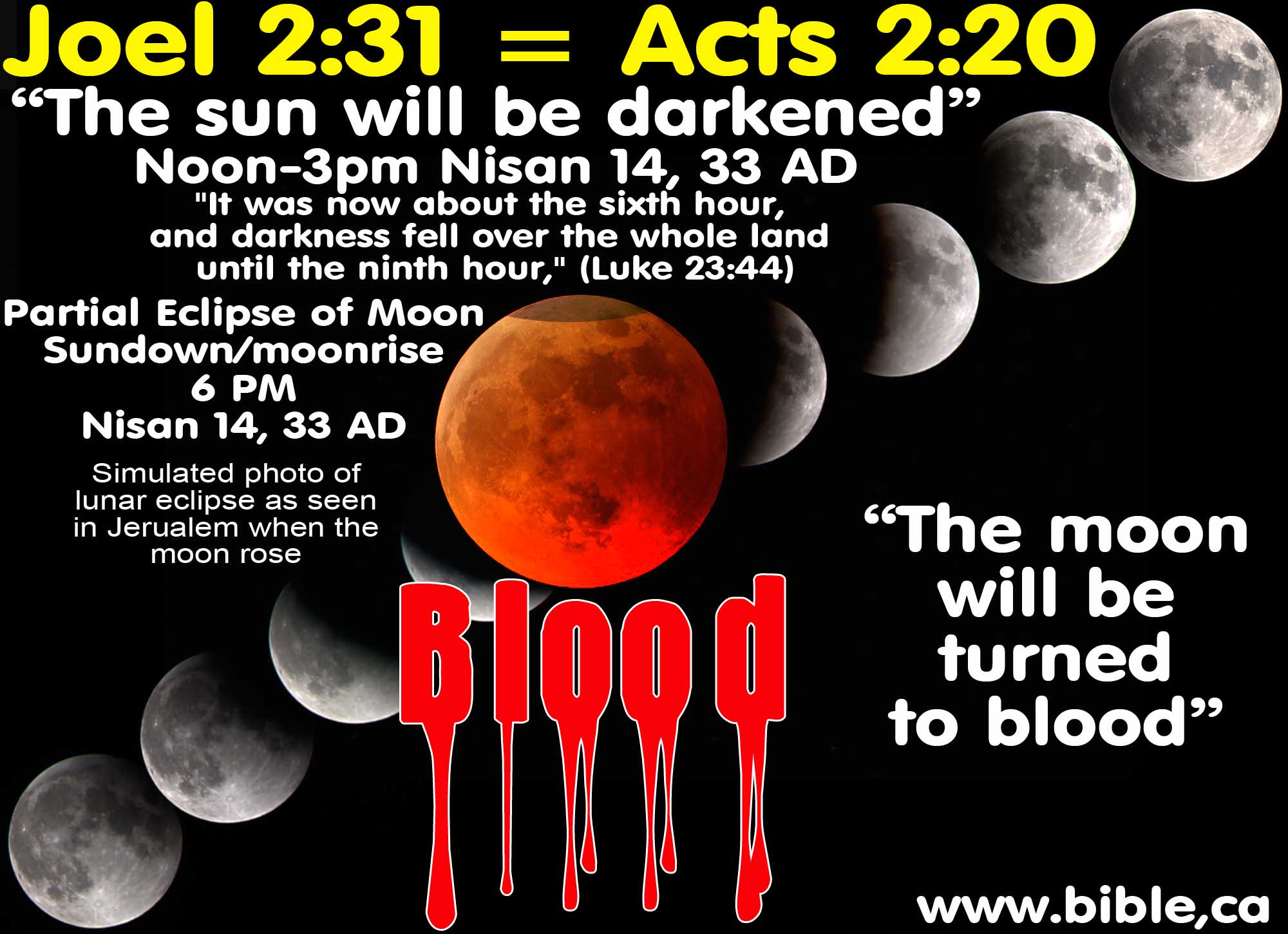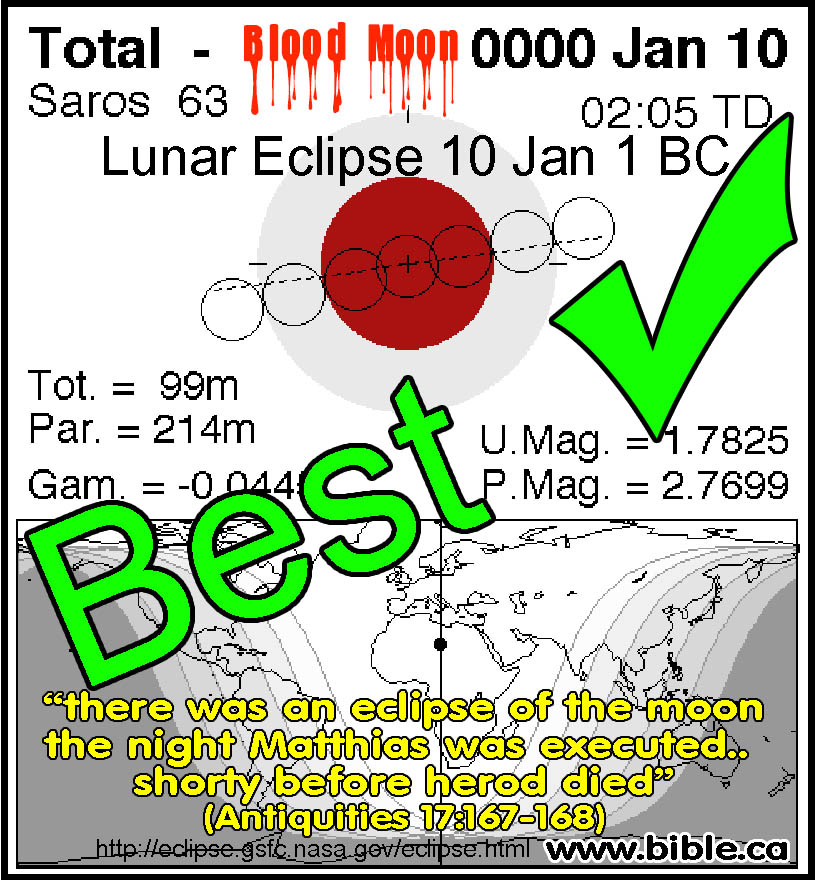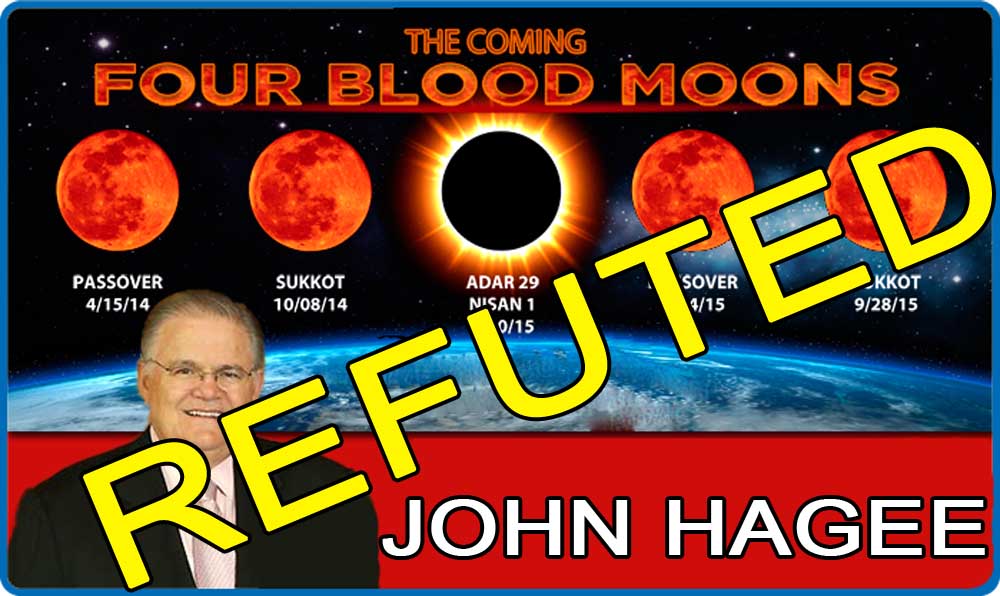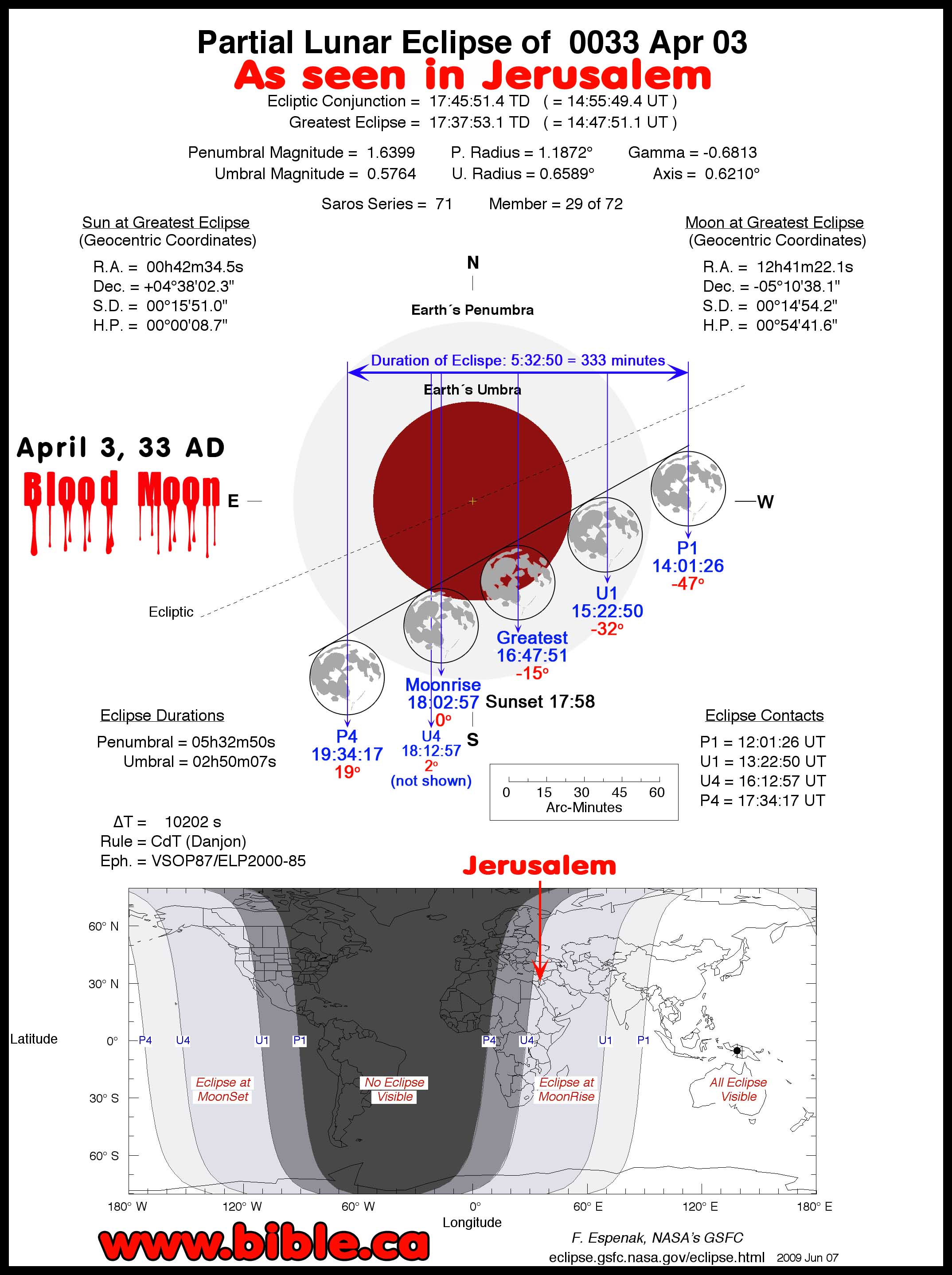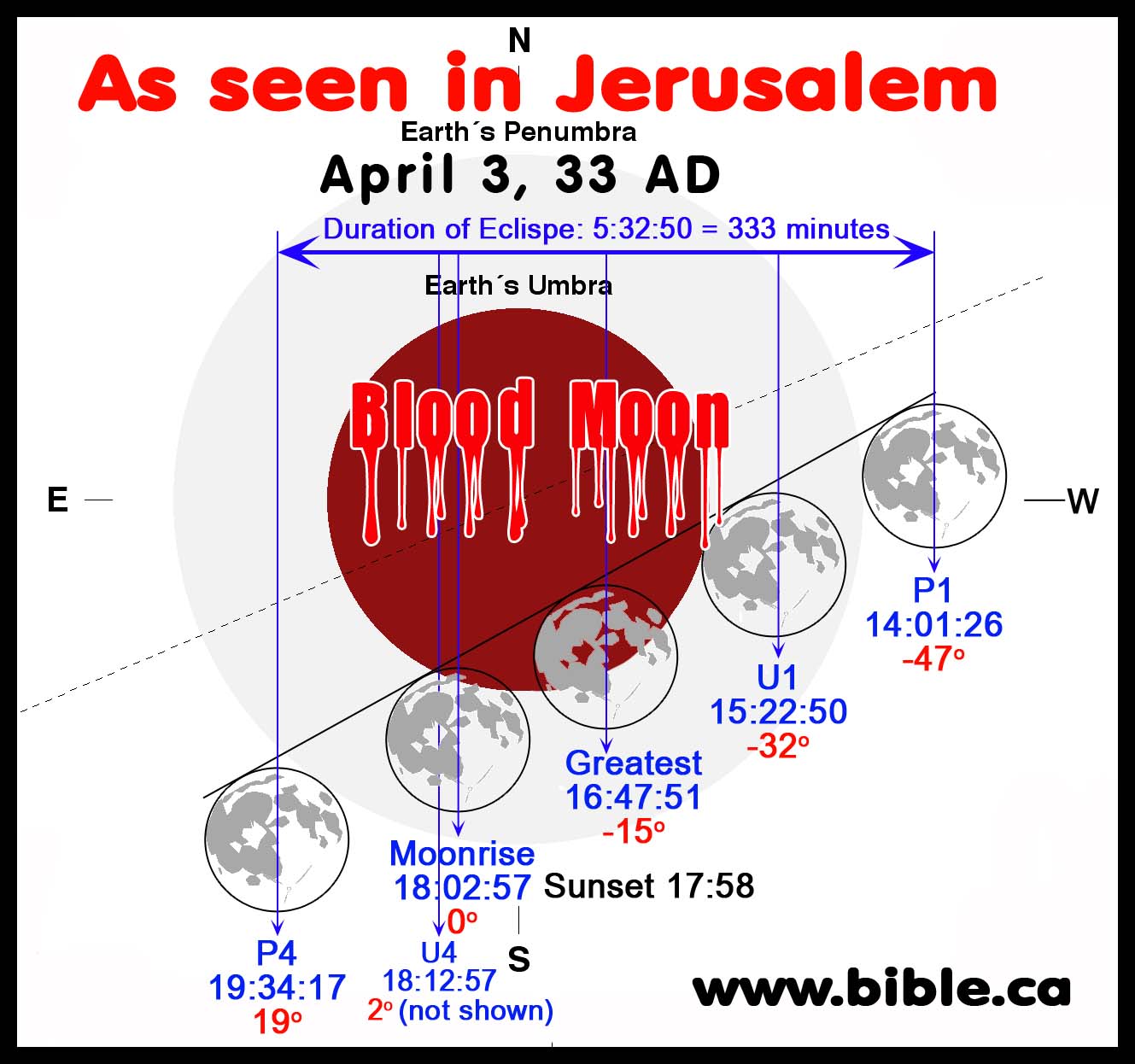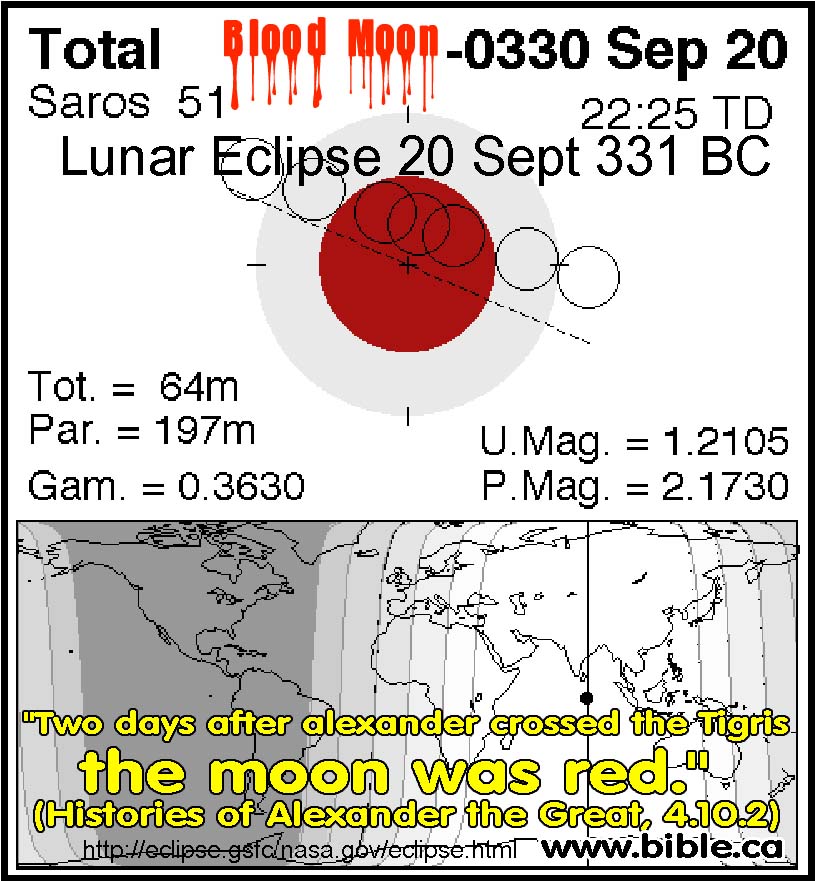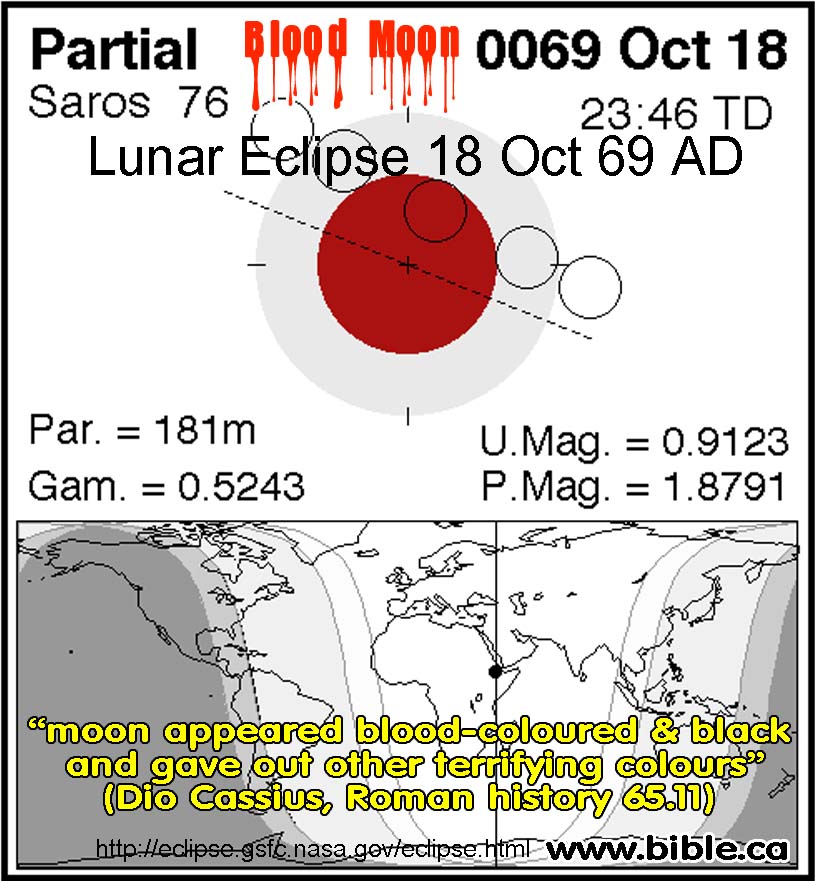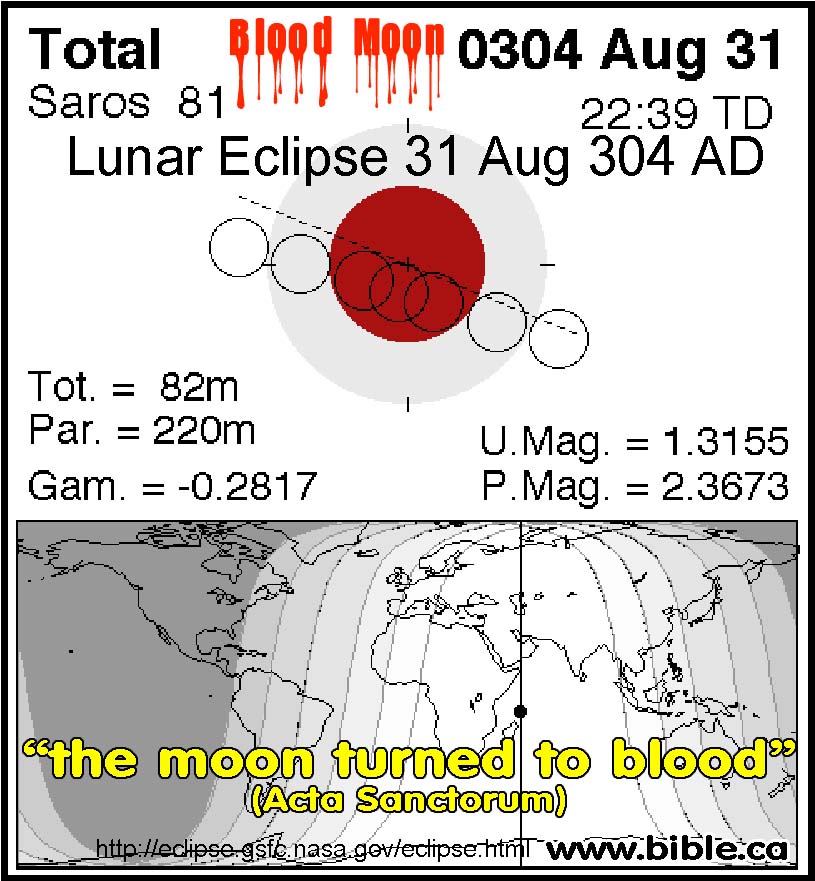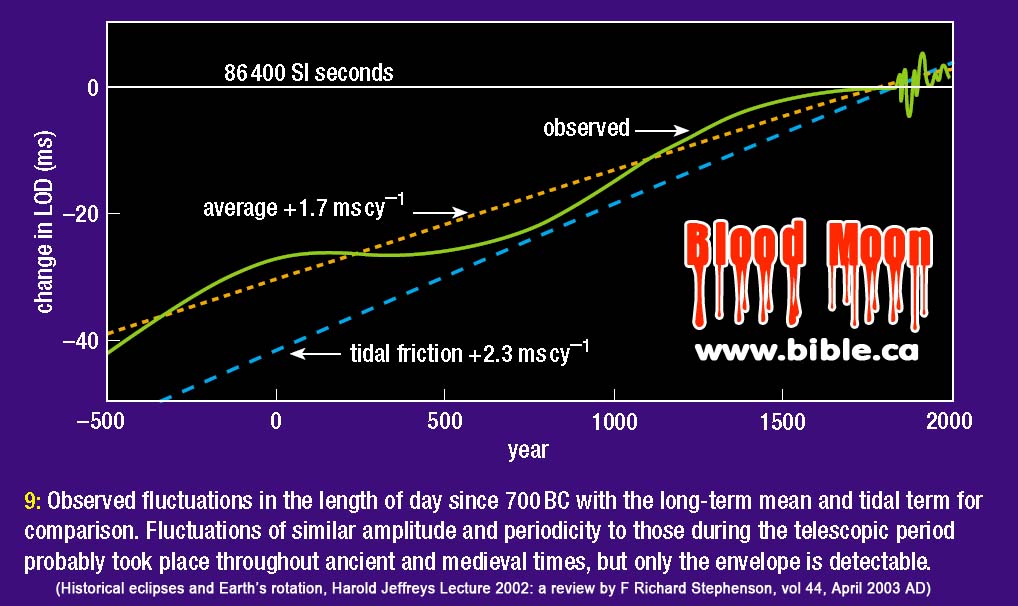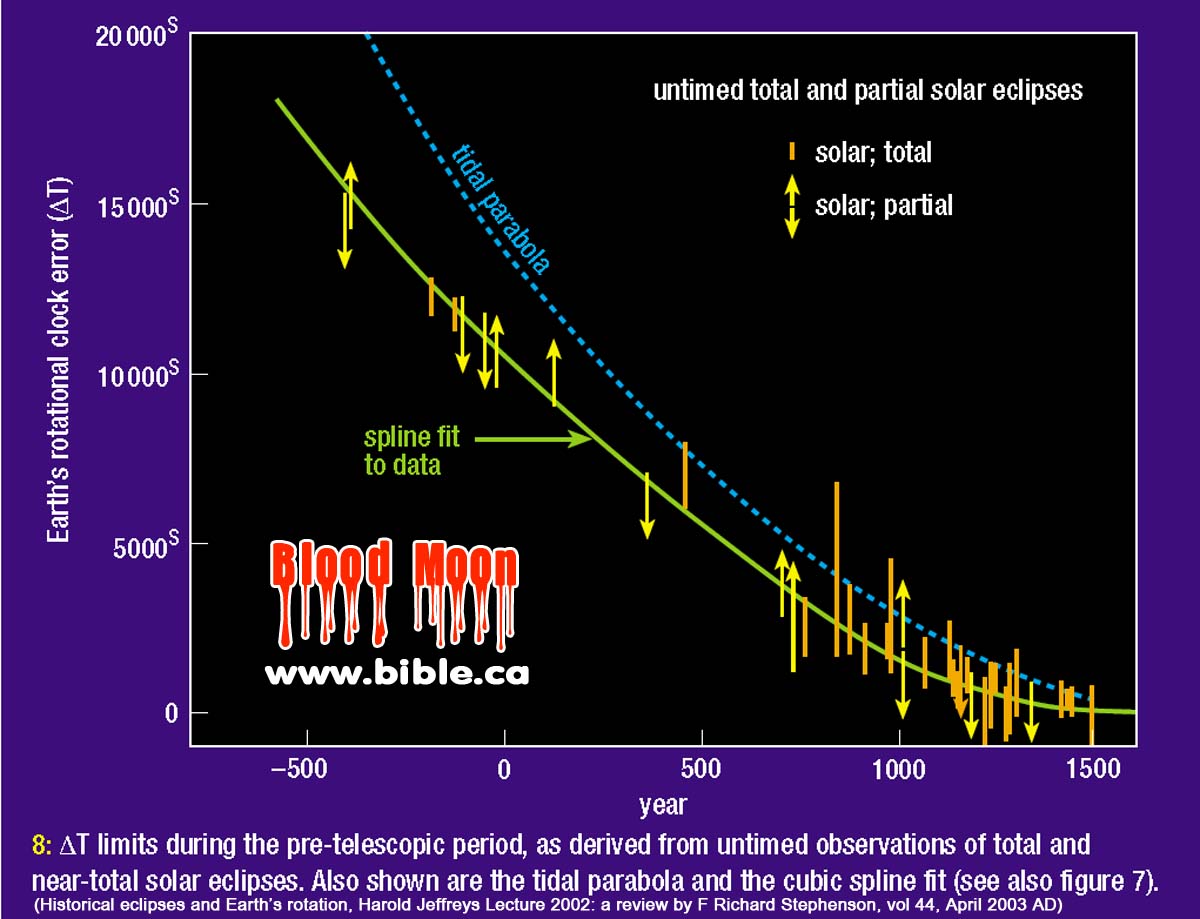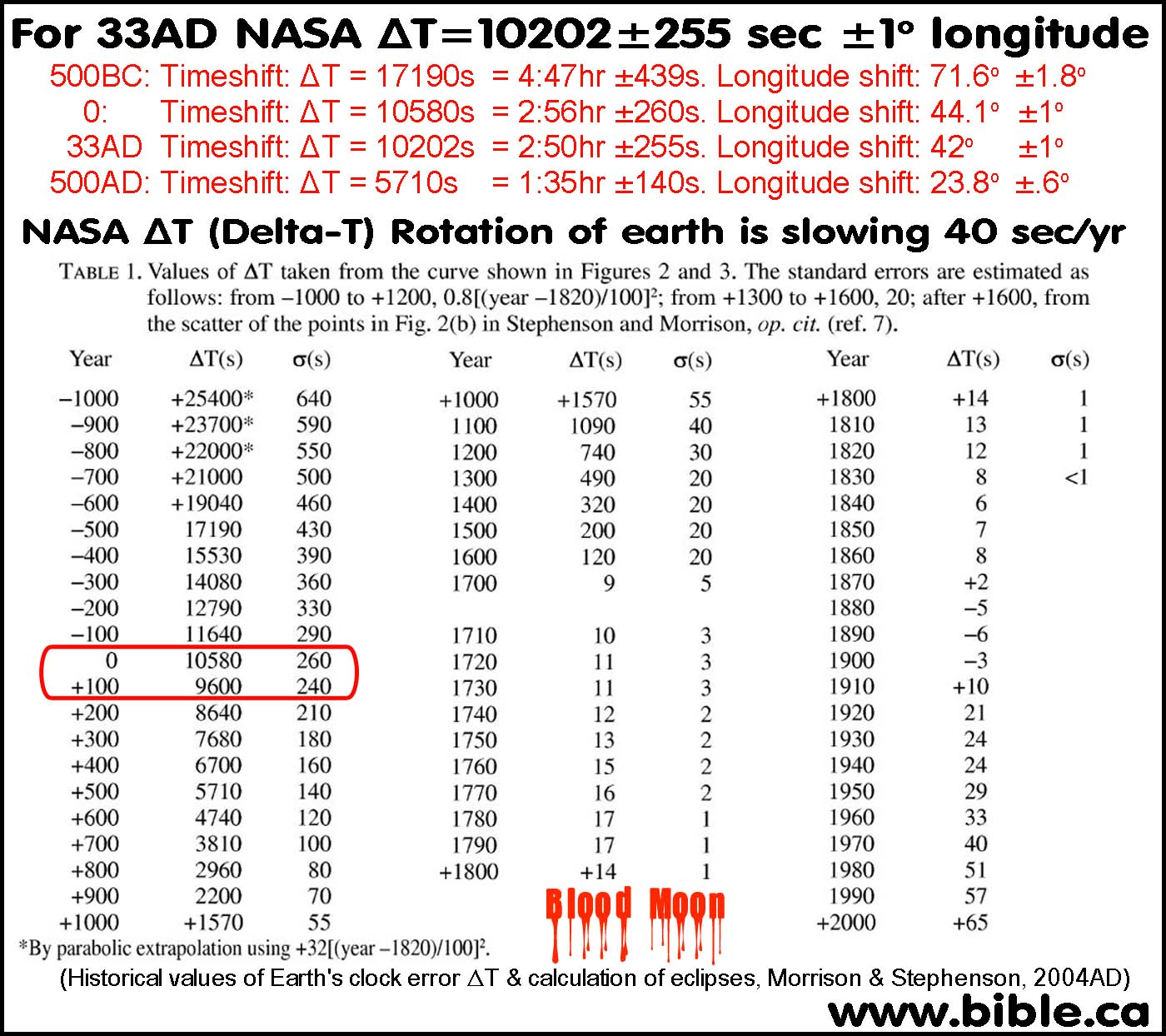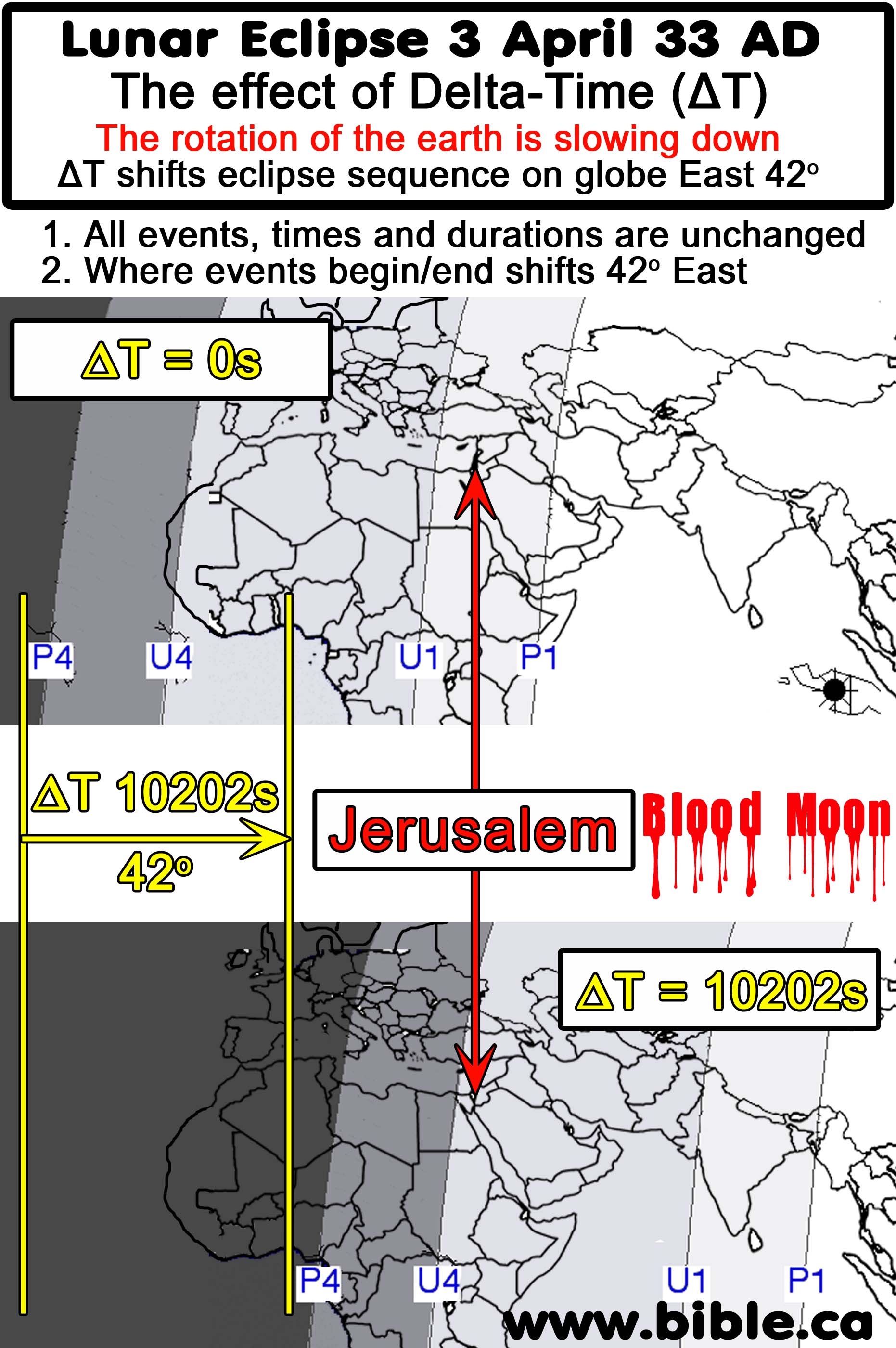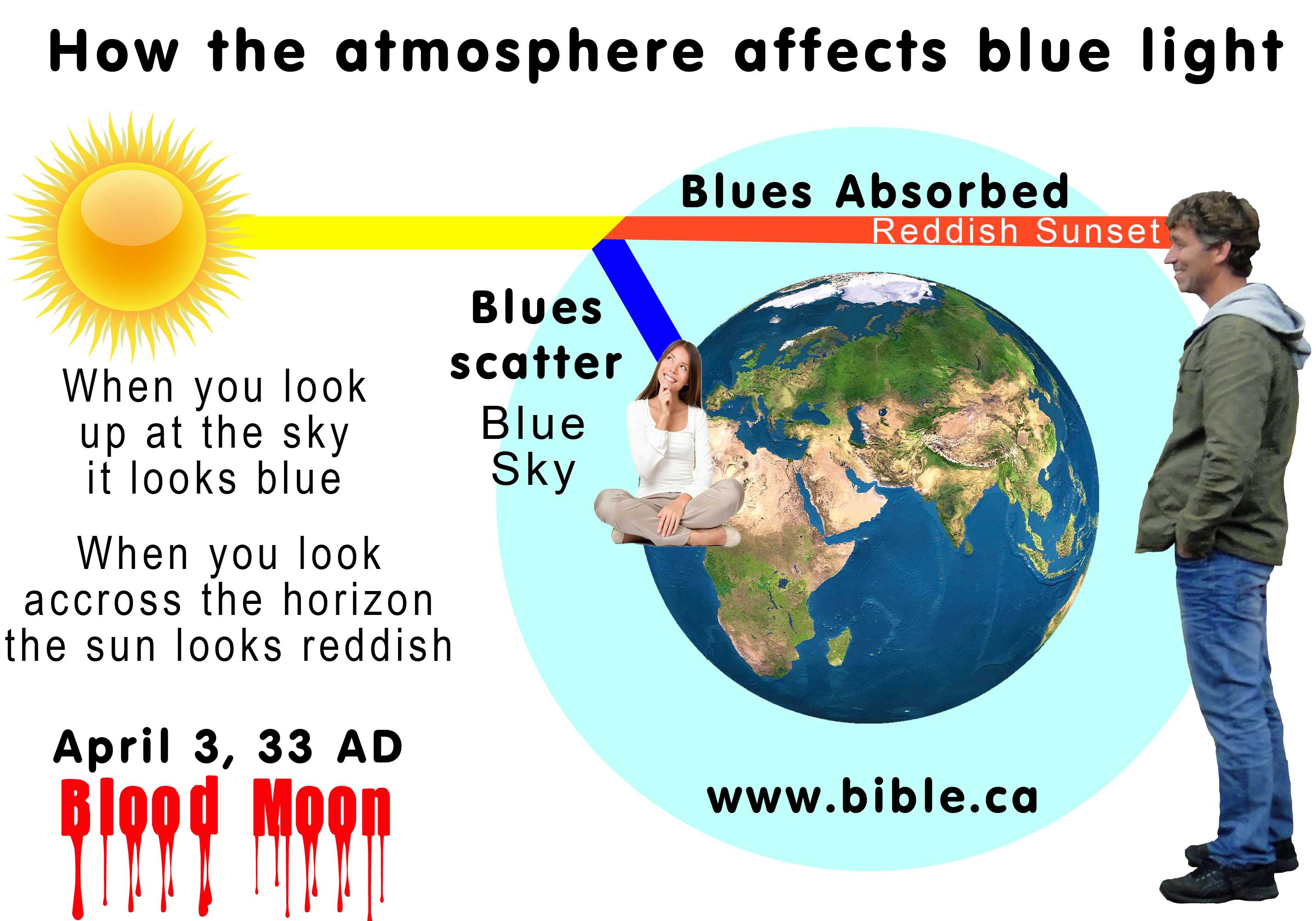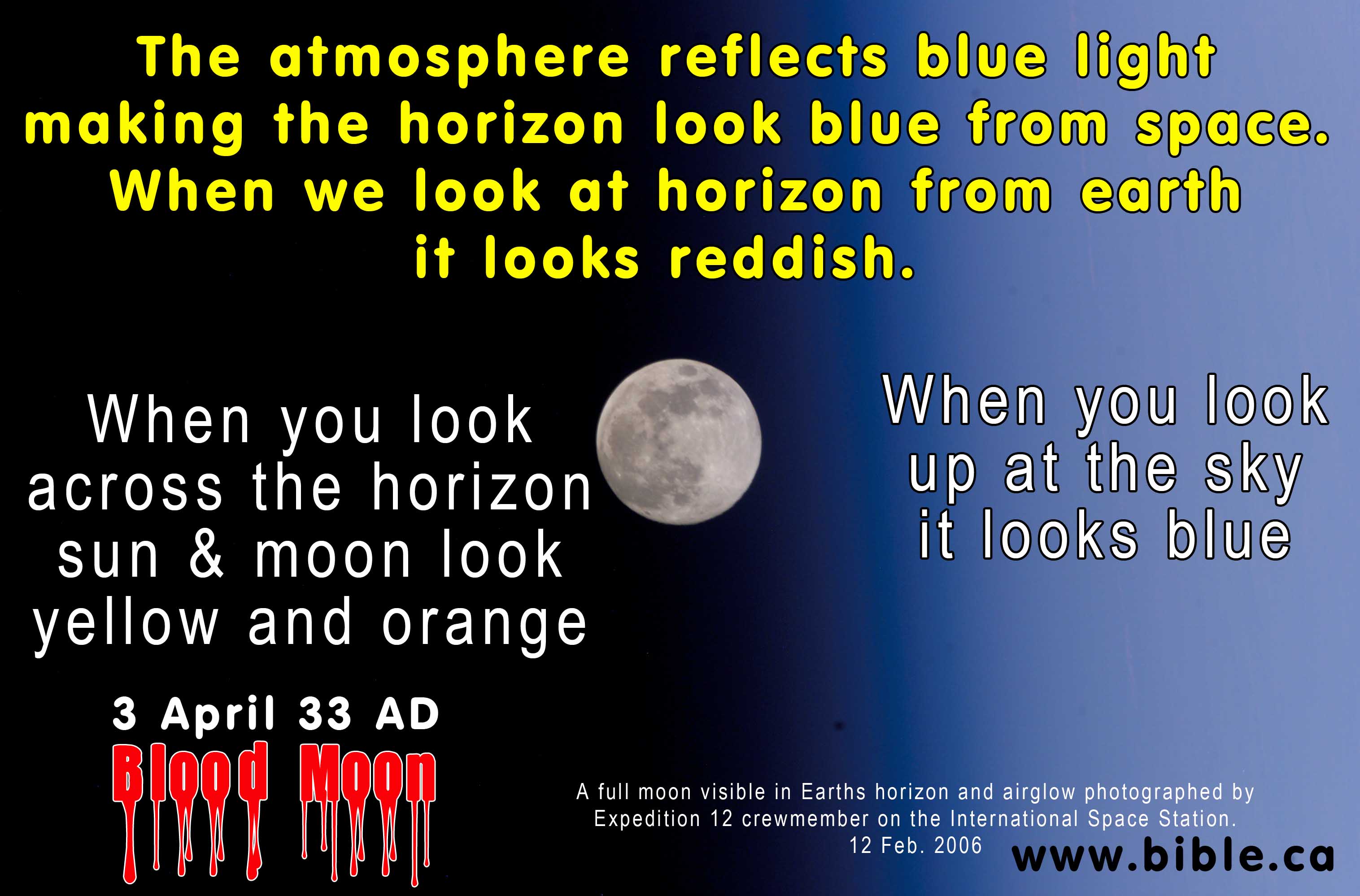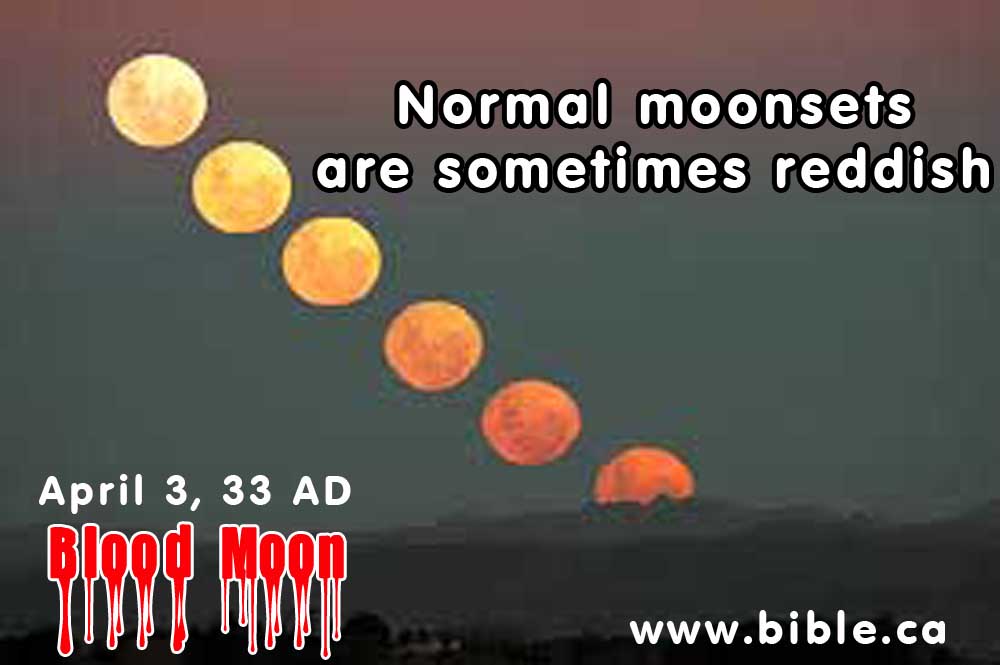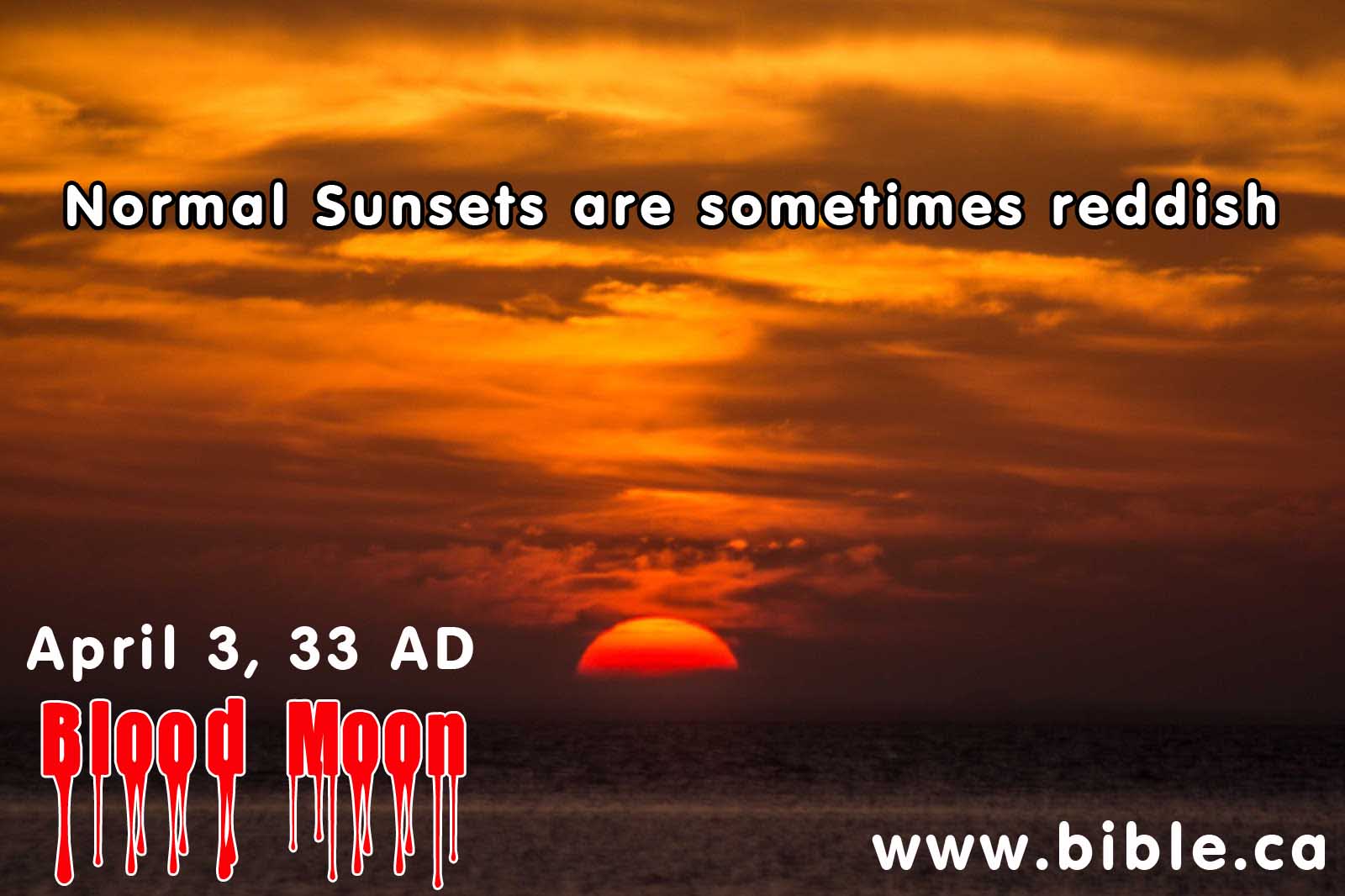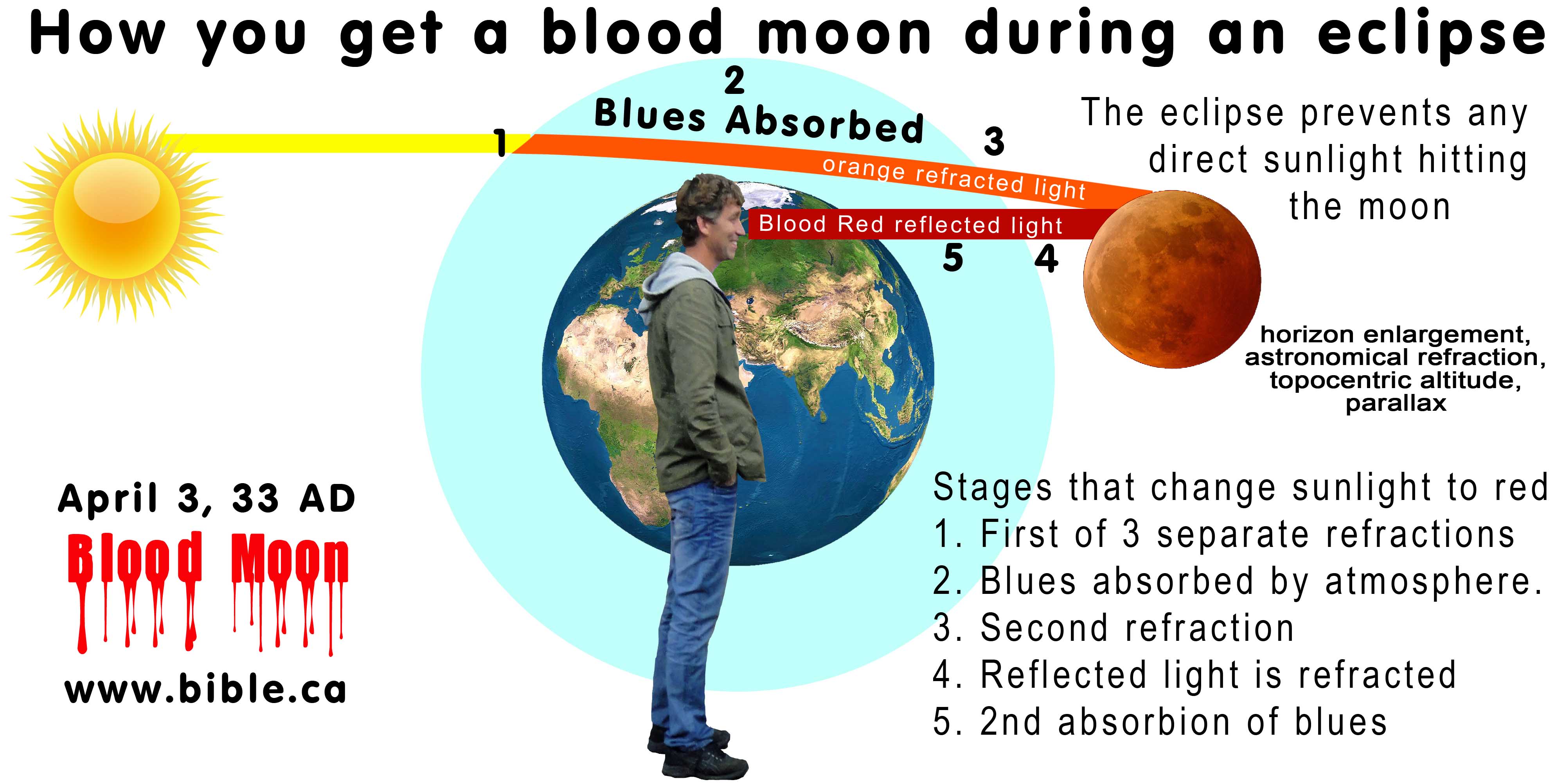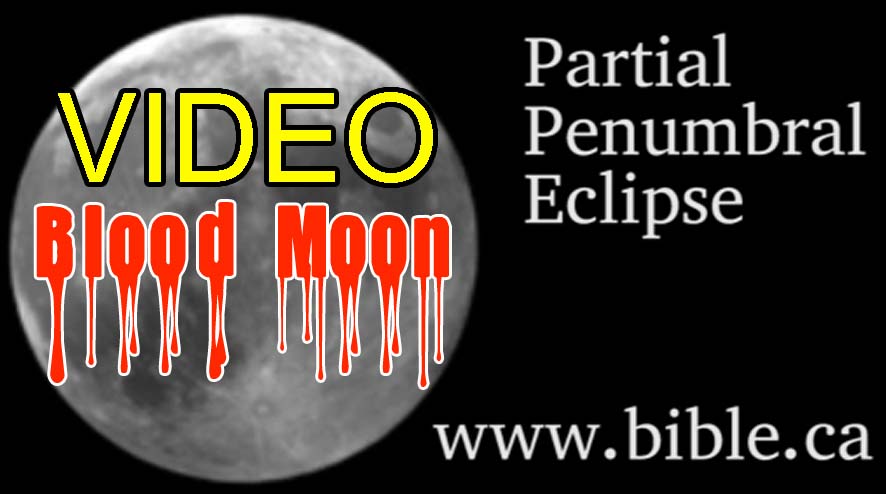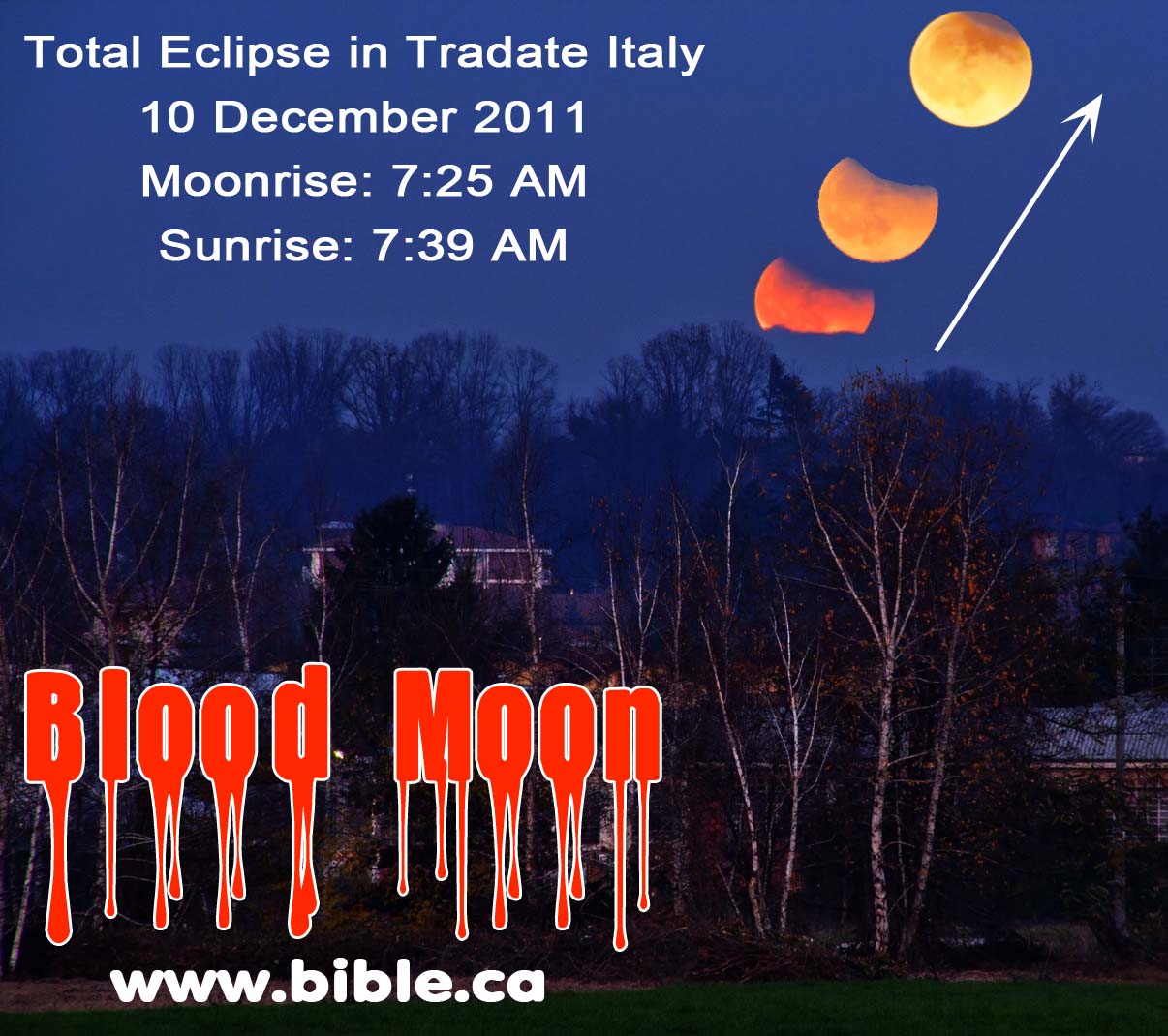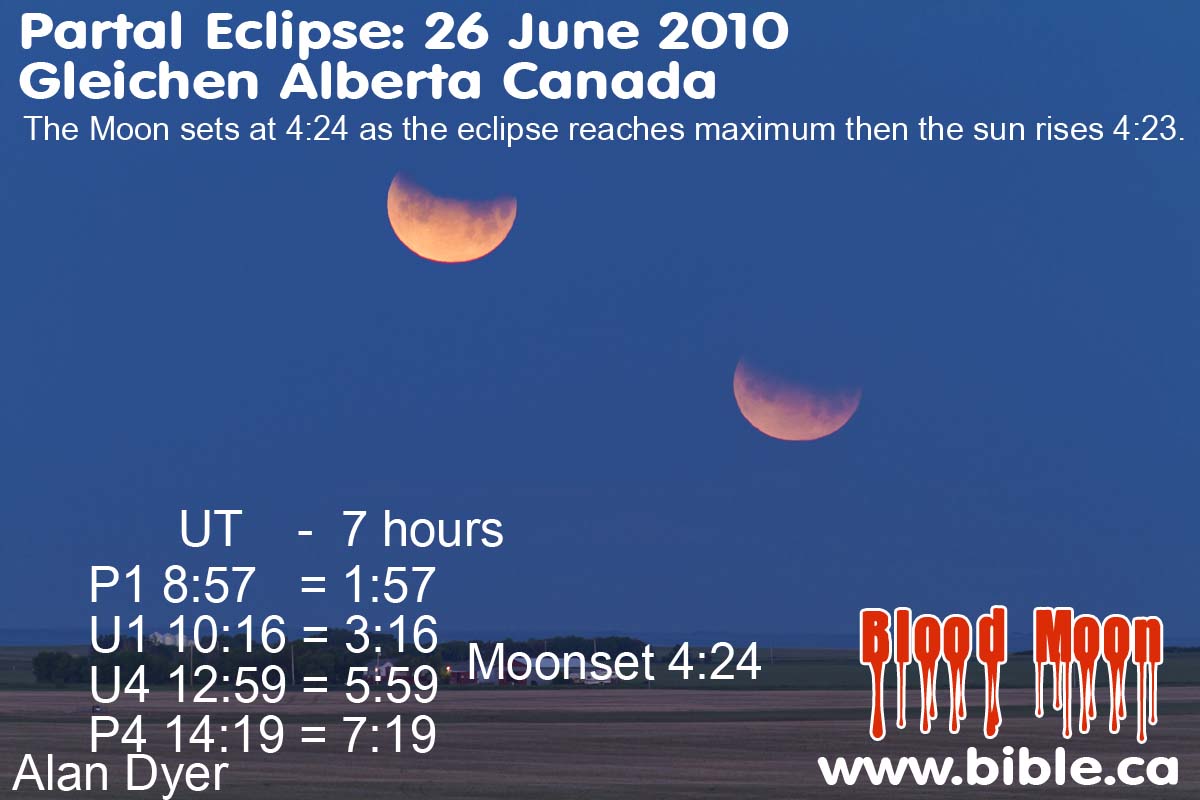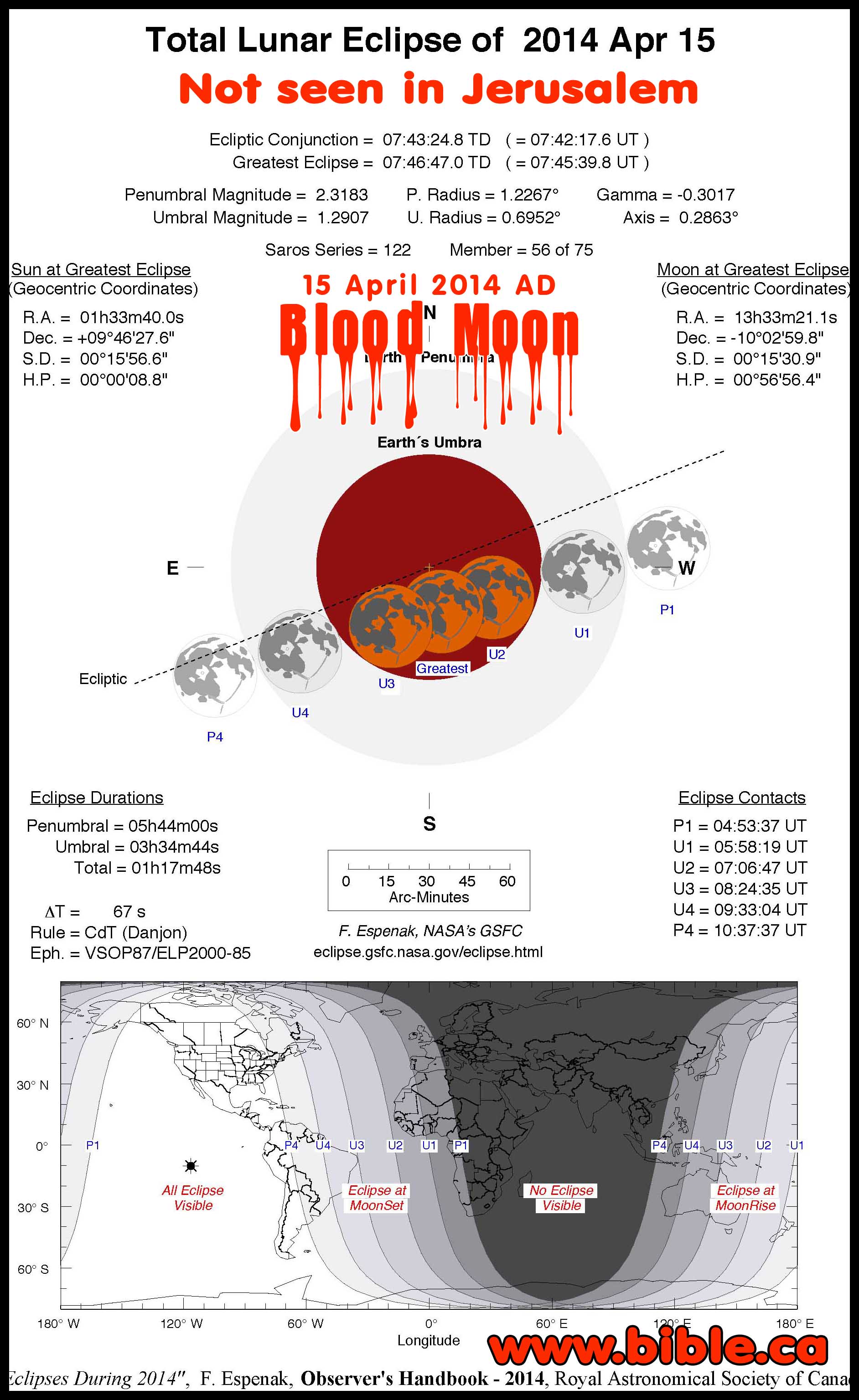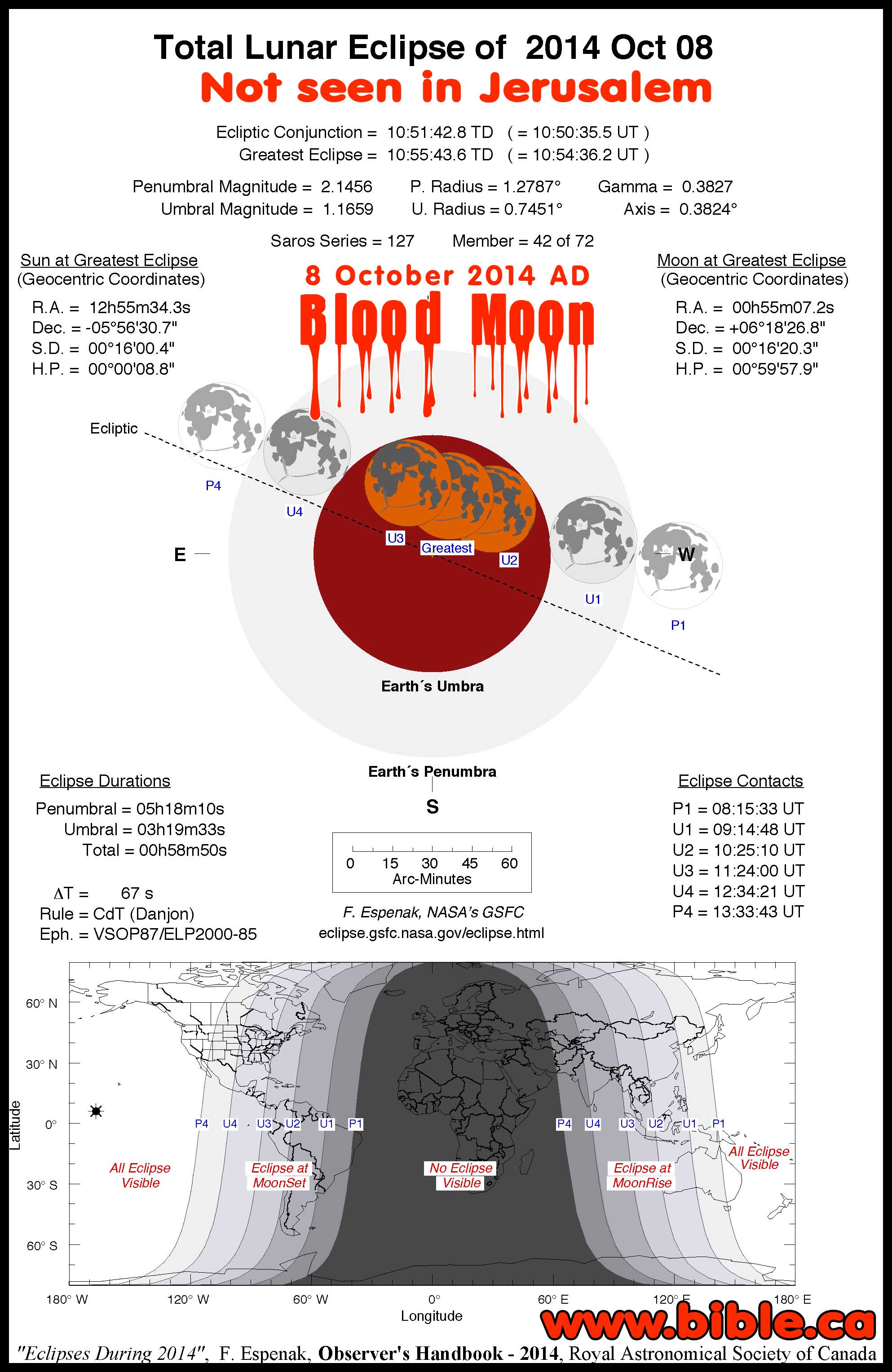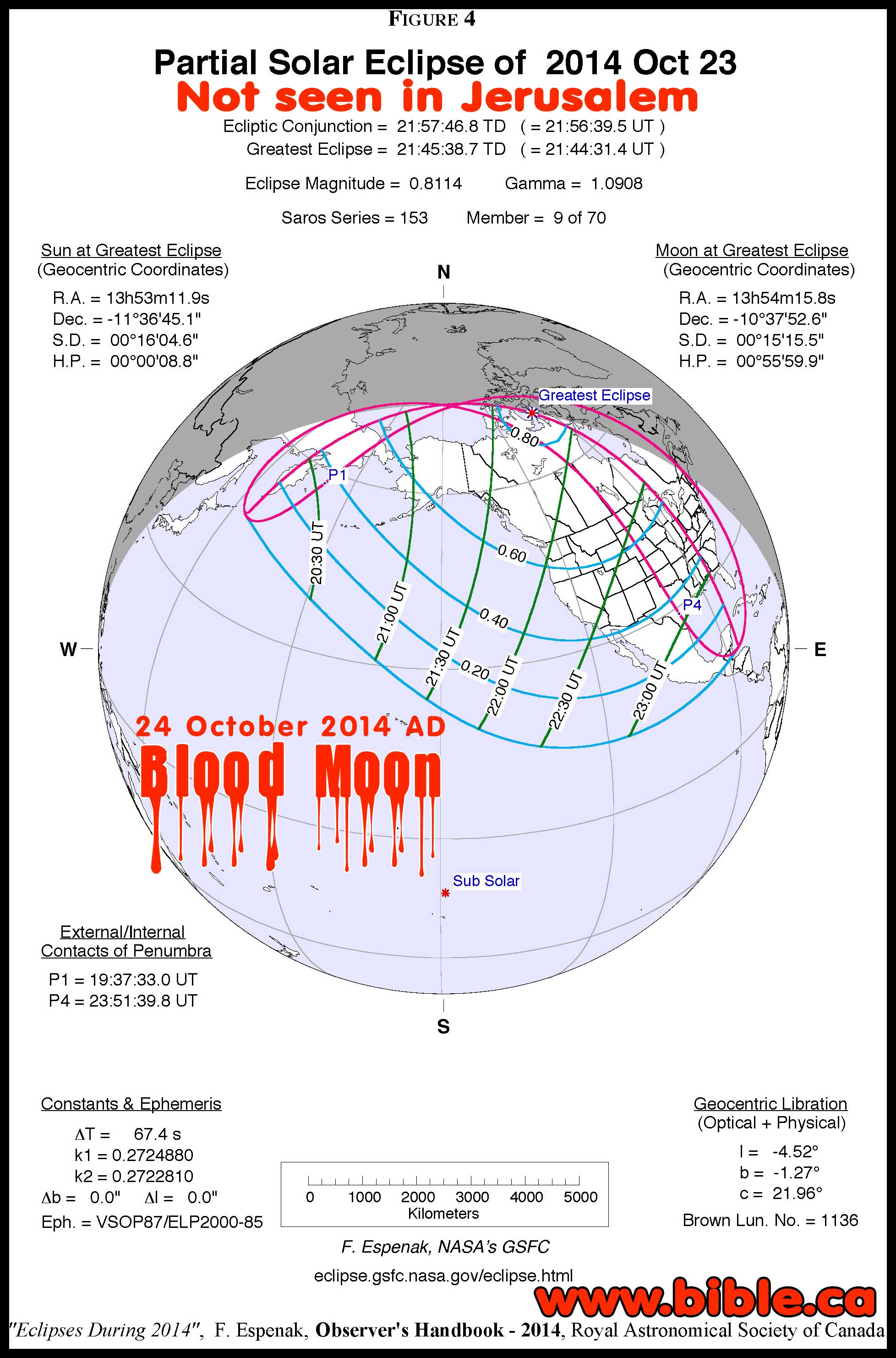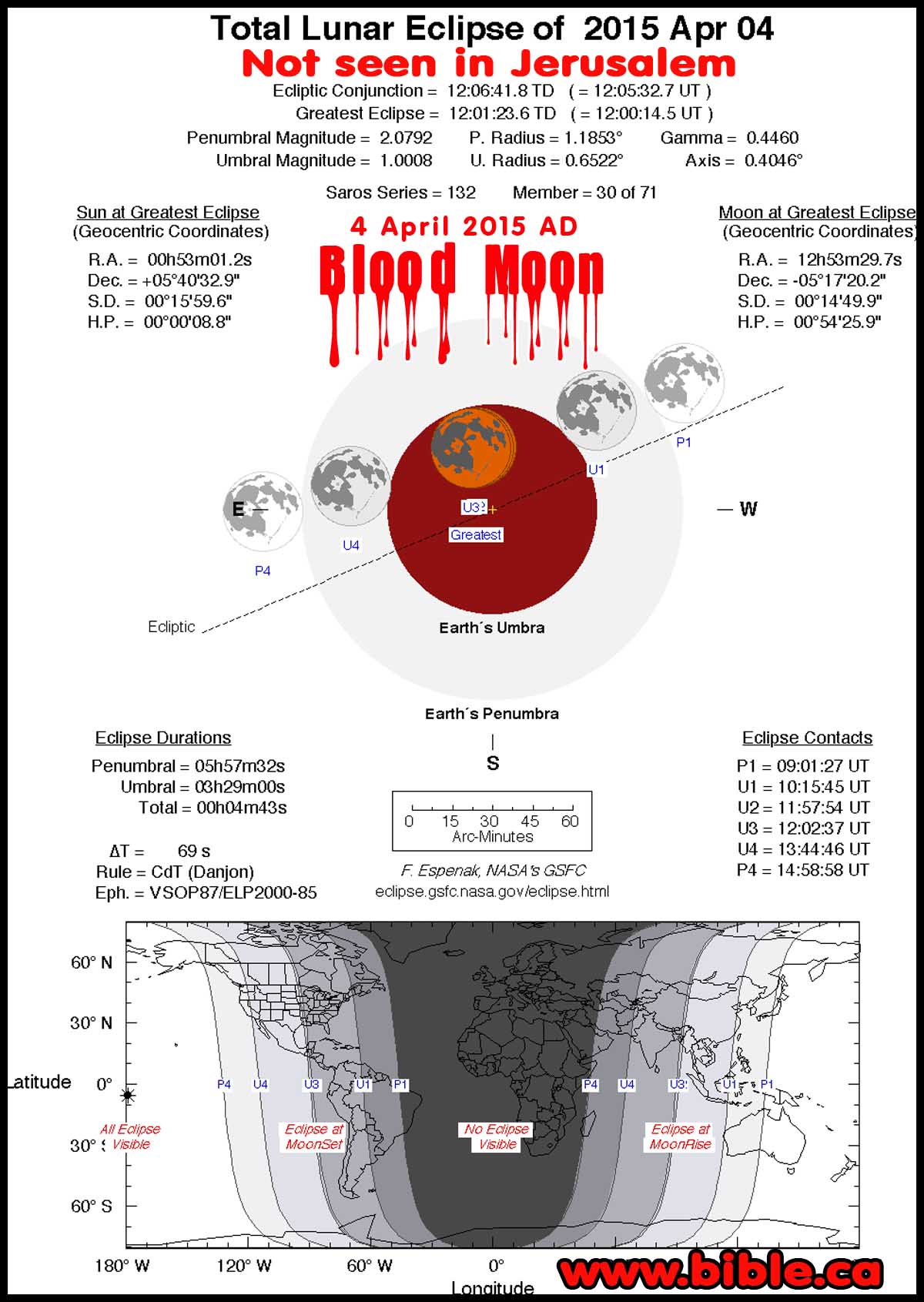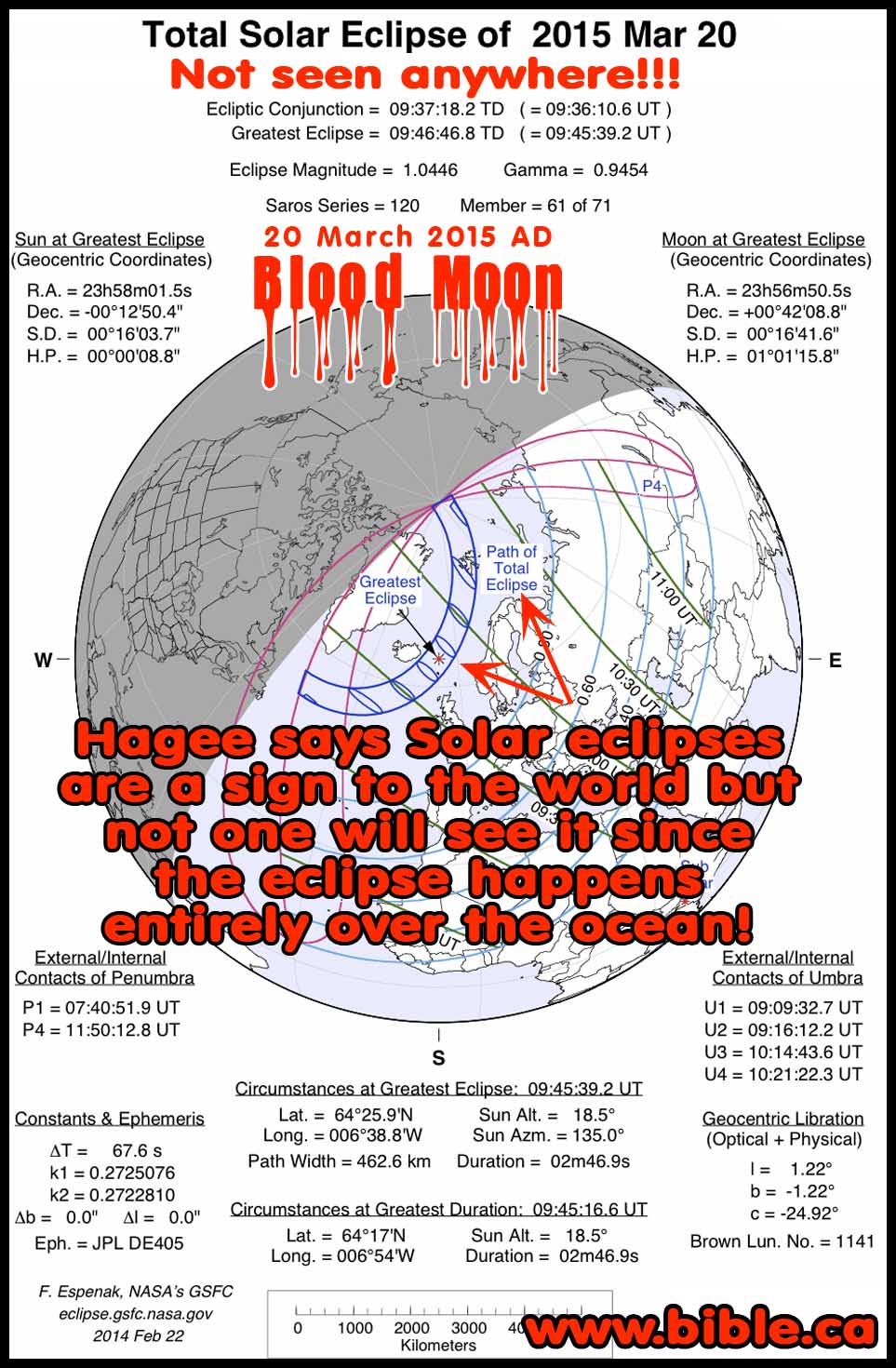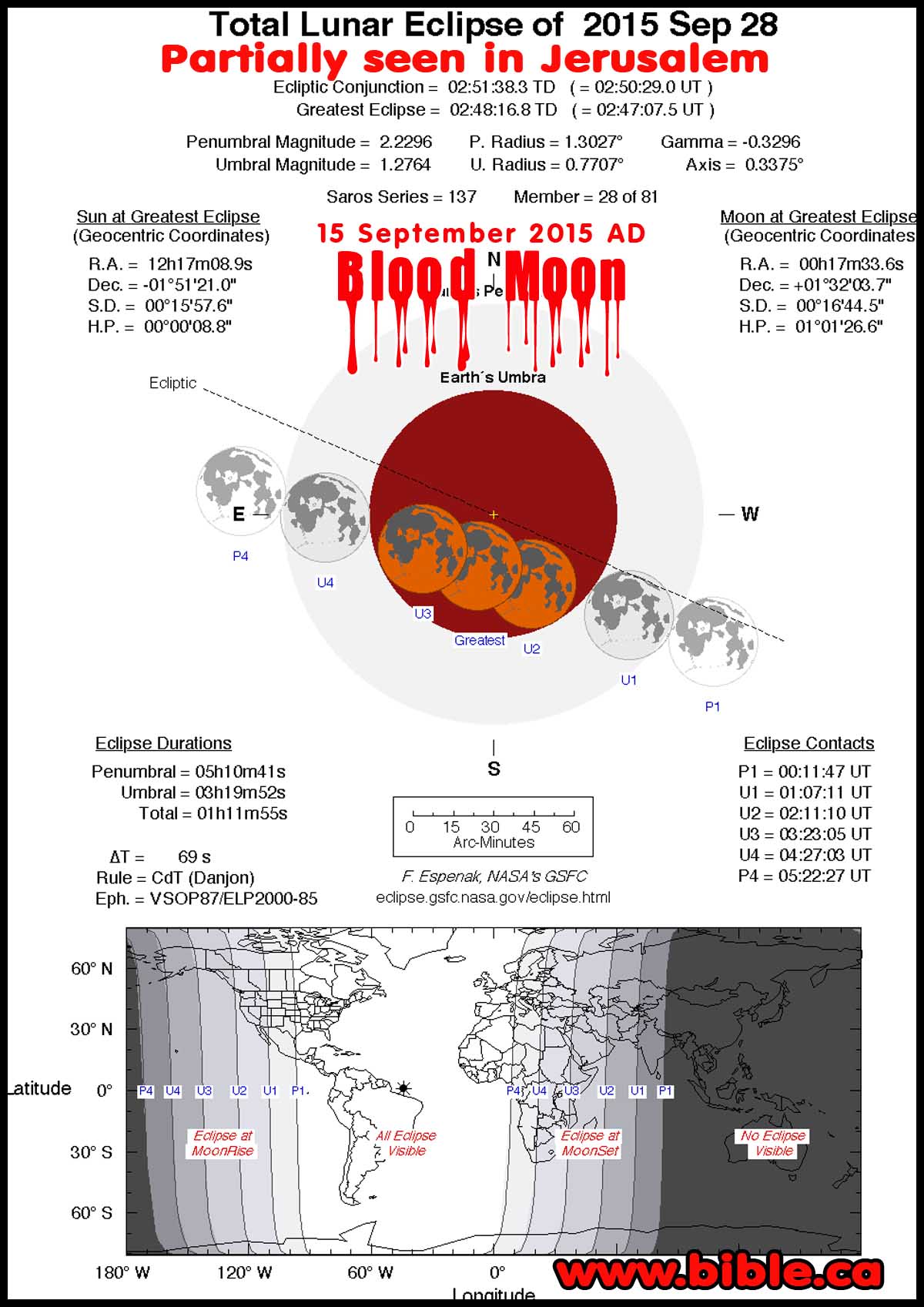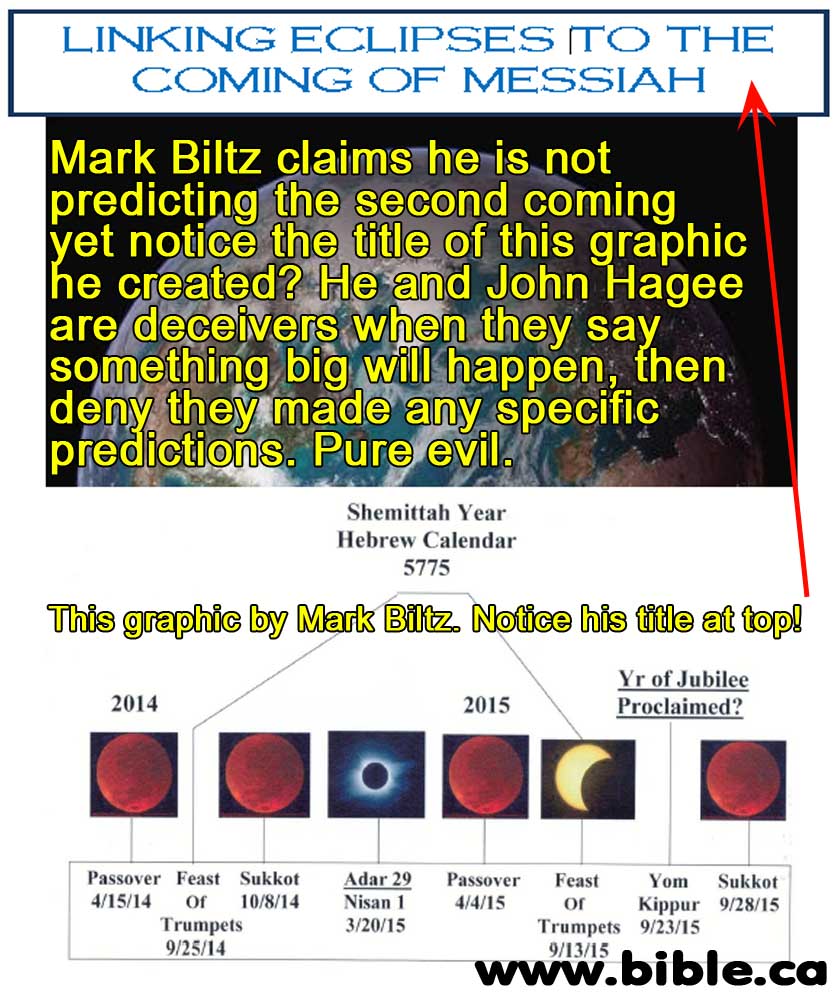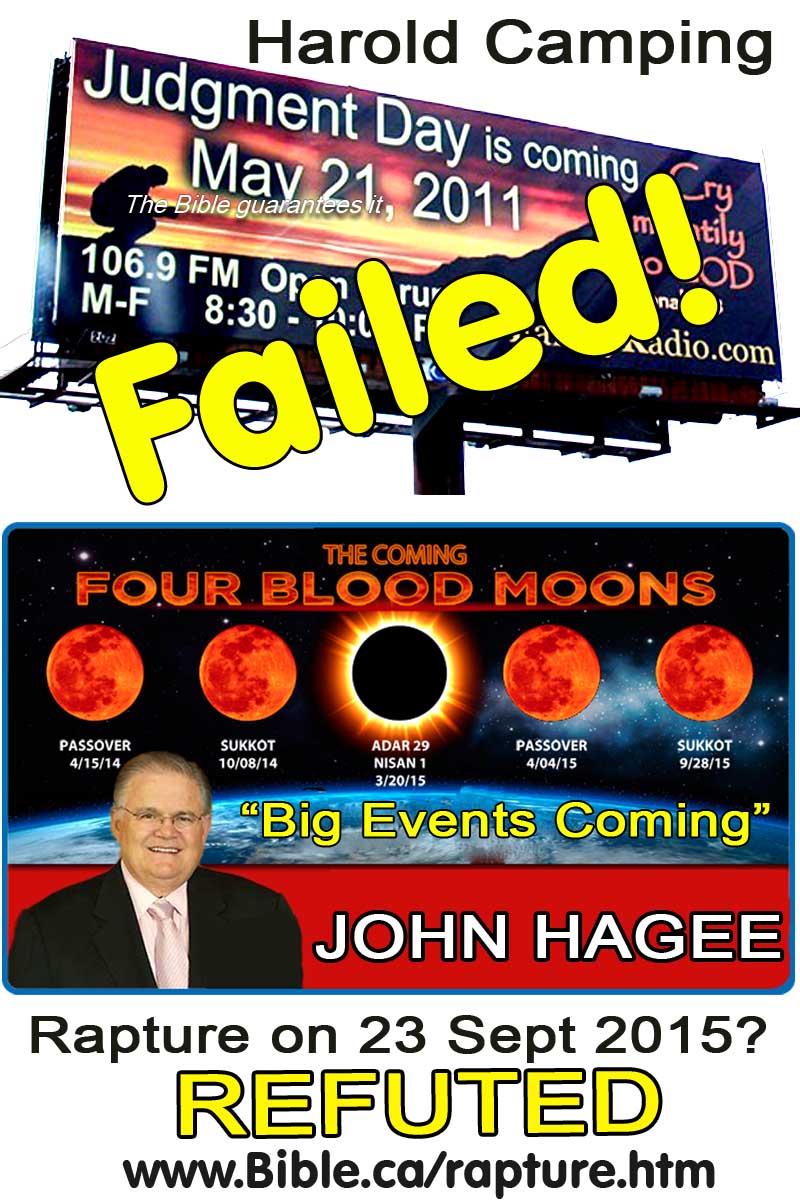Lunar eclipses that mark the birth and death of Christ
"And I will grant wonders in the sky above [darkened sun, eclipsed moon] and signs on the earth below [earthquake] Blood, and fire, and vapor of smoke. The sun will be turned into darkness and the moon into blood, before the great and glorious day of the Lord shall come. And it shall be that everyone who calls on the name of the Lord will be saved.’ “Men of Israel, listen to these words: Jesus the Nazarene, a man attested to you by God with miracles and wonders and signs which God performed through Him in your midst, just as you yourselves know—" (Acts 2:19-22, Joel 2:31f)
Stunning events the day Jesus Died on the cross
|
Birth of Christ: Spring 1 BC 10 January 1 BC: Eclipse of moon spoken of by Josephus (Antiquities 17.167) marking the birth of Christ, Herod's Slaughter of the children, the death of Herod the Great. Death: EVENTS ON Nisan 14, AD 33 Noon - 3pm: Darkness for three hours 3pm: Sunlight restored to normal Earthquake Centurion: "Truly this was God's Son" Veil of Temple torn in two Tombs opened, saints resurrected 6 PM: Sunset & moonrise at precisely the same time Eclipsed blood-red moon rises (NASA) |
Quick links within this document:
- The "Blood Moon" lunar eclipse of 3 April AD 33, 3 hours after Jesus died on the cross that lasted 333 minutes and 66 degrees on the horizon, fulfilling Joel 2:31/Acts 2:20.
- Catalogue of historic lunar eclipses that witnesses described as "Blood Moons".
- The Science behind Lunar eclipses.
- The Science behind a "Blood Moon".
- When did Herod the Great die?
- The "Blood Moon" lunar eclipse of 1 BC that happened just before the birth of Christ and marks Herod's slaughter of the children.
- Refutation of John Hagee's FOUR BLOOD MOONS in 2014/15. Mark Biltz and John Hagee's are both predicting huge world changing events on or before 23 September 2015 (Yom Kippur).
- Master conclusion
Introduction:
- Eclipses have been critical to calculating both the birth and death of Christ.
- The approximate birth of Christ can be determined (2 BC) based upon the total lunar eclipse on 10 January 1 BC.
|
10 January 1 BC Josephus says that the night Herod killed Matthias there was an eclipse of the moon. This eclipse likely marks the slaughter of the children 2 years and younger by Herod. |
- Christians will generally teach that Jesus was born in 4-6 BC but never realize the reason was Josephus speaks of a lunar eclipse just prior to the death of Herod who slaughtered all the babies of Bethlehem. (Antiquities 17.167) But this date is based upon the wrong eclipse! With the right eclipse, Christ was born 2 BC.
- What is stunning, is that this event most likely marks Herod's Slaughter of the Children 2 years of age and younger.
- Josephus notes that the lunar eclipse happened on the night Matthias, of the high priest family, was murdered by Herod the Great.
- However, Josephus very strangely never mentions the great slaughter of the children by Herod. In fact, history is so silent about this event, that Bible haters and scoffers say it is a myth that never happened. "Nor does the first century AD Jewish historian, Flavius Josephus record this event in any of his writings. Even though secular history is silent on this event it does not mean it did not occur.“ (The Slaughter of the Innocents: Historical Fact or Legendary Fiction? Gordon Franz, Associates for Bible Research, 2009 AD)
- We suggest that the timing of such an eclipse not only marked the execution of Matthias, but also all the children as well at the same time!
- The birth of Christ of 4-7 BC is based upon a partial lunar eclipse on 13 March 4 BC but must be rejected because it places the birth of Christ too early and has serious chronology problems in harmonizing historic records.
- NASA data shows that the total eclipse of 10 January 1 BC is the best choice in dating the death of Herod based upon the writings of Josephus: Antiquities 17.167. This places the birth of Christ most likely in the spring of that same year of 1 BC.
- NASA data shows that the partial "blood moon" eclipse of 3 April AD 33 marks the night Christ died (Friday Nisan 14) and fulfilled Joel 2:31/Acts 2:19-22 where it says "the moon will be turned to blood". While moonrise eclipses are very red and high altitude eclipses are pinkish.
- Historically, the phrase "blood moon" was a synonym for a modern "lunar eclipse" in the same way that the phrase "preparation day" was a synonym for our modern "Friday".
- In 2008, Mark Biltz suggested huge events are possible, including the return of Jesus, based upon the four lunar eclipses of 2014/15 AD. John Hagee has followed suite in copying the Biltz heresy. However Hagee is a serpent in that he projects the idea of some huge fulfillment of prophecy event will happen in connection with these four lunar eclipses while never actually saying such. This way he can pull a "Jehovah's Witness" when Christ doesn't return and blame it all on the stupid sheep!
|
Both Mark Biltz and John Hagee have indirectly hinted that the second coming of Christ, or Jesus planting his feet on the mount of Olives (Zech 14) or some other huge catastrophic event on 23 September 2015 (Yom Kippur). Such is irresponsible but boy does it sell books! The FOUR BLOOD MOONS of John Hagee and Mark Biltz are refuted at the end of this outline. |
- "In 1872, J.R. Hind published a paper in the British scientific journal Nature in which he noted that the "moon was eclipsed on the generally received date of the Crucifixion, AD 33, April 3."4 Bible scholars paid little or no attention to this observation, because the best astronomical calculations available at the time showed that the eclipse would not have been visible from Jerusalem. In the 20th century, however, there was a major advance in the accuracy of historical astronomical calculations, due largely to studies of the change of the earth's rate of rotation over the centuries. [Known as Delta T "ΔT"] Using ancient astronomical observations from Babylon and China, the rate of slowing of the earth's rotation [ΔT] is now known precisely enough so that the timing of events such as the rising of the moon or the sun as viewed from any point on earth and at any time in the last 2000 years can be known within about three minutes (Humphreys 2011: 90). In 1981, a British scientist who had learned of the improvements in astronomical accuracy thought it might be interesting to revisit calculations for the eclipse of AD 33. Colin Humphreys, who was teaching at Oxford at the time, asked Oxford astrophysicist Graem Waddington to determine whether the lunar eclipse would have been visible at Jerusalem, and if so, at what time it would have been observed. Very fittingly, their findings were published in the same scientific journal that had published Hind's study 111 years earlier (Humphreys and Waddington 1983). (Bible and Spade, Rodger Young, p 39, 2013 AD)
- One of the critical matters to keep in mind about the April 3, 33AD eclipse is not only was Umbral portion of the moon was eclipsed for the first 10 minutes at moonrise (NASA datasheet), but the eclipsed portion was near the top leading edge and would be the first thing visible.
I. The lunar eclipse of 3 April 33 A.D. lasted 333 minutes and 66 degrees on the horizon:
A. The NASA snapsheet for the lunar eclipse of April 3, 33 A.D.
- If Harold Camping was still alive, he might make a big thing about the number 66 as twice the mark of the beast as the basis of a new end of the world prediction! Notice all the "3's" and "6's": The "Blood Moon" lunar eclipse of 3 April 33 AD, 3 hours after Jesus died on the cross that lasted 333 minutes and 66 degrees on the horizon)
- We have taken the NASA snapsheet as the benchmark for all our calculations and modified it specifically for how it would look in Jerusalem using the NASA Java script
- By using only NASA numbers, it assures accuracy with the best science on earth for historic eclipses.
- Here is the actual NASA data snapsheet for the partial lunar eclipse of 3 April AD 33:
|
The moon rose and the sun set at the same time. The moon appeared in full umbral eclipse at the upper part of the disk and continued for about 10 minutes. At that point the moon continued in full penumbral eclipse for all to see. However from Babylon, where the Magi had noticed the start of Bethlehem, the moon rose in full umbral eclipse for 25 minutes. Surely they would connect the make the connection with the blood moon and the crucifixion of the one they travelled so far 33 years earlier to worship as the king of the Jews! |
B. We have taken the NASA snapsheet as the benchmark for all our calculations and modified it specifically for how it would look in Jerusalem using the NASA Java script.
- It is important to notice that the NASA Java script tells us that the moon was 2o above horizon at the end of the umbral phase of the eclipse (U4).
- This means that the moon rose in full umbral eclipse for the first 10 minutes.
- However, when we add "moonshift" the umbral would be visible for 12:30m after moonrise.
|
JERUSALEM: NASA DATA PAGE COMBINED WITH NASA JAVA SCRIPT ΔT=10202s σ ±255s 2:50hr σ ±4:15m |
|||
|
Stage |
Nasa data Adjusted for Jerusalem (+ 2 hours) |
ΔT Delta-T and σ Error margin |
Angle to horizon It takes 5 minutes for the moon to move one diameter |
|
Penumbral starts (P1) |
14:01:26 |
σ ±4:15m |
47 degrees below horizon |
|
Umbral starts (U1) |
15:22:50 |
σ ±4:15m |
32 degrees below horizon |
|
Greatest eclipse |
16:47:51 |
σ ±4:15m |
15 degrees below horizon |
|
Sunset in Jerusalem |
17:58 |
- |
Sun disappears under horizon |
|
Sunset with astronomical refraction |
18:00:30 (2:30m or 150 seconds) |
- |
.5 degrees below horizon |
|
Moonrise with astronomical refraction |
18:00:27 (2:30m or 150 seconds) |
σ ±4:15m |
.5 degrees below horizon |
|
Moonrise |
18:02:57 |
σ ±4:15m |
0 degrees (Just below Horizon, moon 100% invisible) |
|
Umbral ends (U4) |
18:12:57 |
σ ±4:15m |
2 degrees above horizon |
|
Penumbral ends (P4) |
19:34:17 |
σ ±4:15m |
19 degrees above horizon |
C. The appearance of the moon at Moonrise in Jerusalem vs Babylon:
- There are significant differences in the appearance of moonrise in Jerusalem vs. Babylon.
- Both are on the same latitude but Baghdad is 1000 km due east of Jerusalem.
- This distance means that more of the umbral shadow of the earth would be on the moon as it rose.
- Notice these four cities: Jerusalem, Haifa and Beirut are on the same longitude and the eclipse would appear the same in all three cities.
- However for Baghdad 1000km latitude east, the eclipse sequence is identical EXCEPT for the hight of the moon when U4 ended.
- This is a significant difference.
- An observer would see a full 35 minutes of the Umbral eclipse in Baghdad but only 10 minutes in Jerusalem.
- When the umbral ended (U4) in Jerusalem, the moon would be 2 degrees above the horizon but in Baghdad it would be 10 degrees!
- Remember that one degree is equal to two moon diameters. So in Jerusalem U4 would end when the moon was 4 moon diameters high and 20 moon diameters in Baghdad.
- The further east from Jerusalem you travel, the higher the moon is when the umbral shadow of the earth leaves the moon.
- Keep in mind that once the umbra ends, the moon is still in full penumbral eclipse!
|
City |
Umbra begins (U1) |
Umbra ends (U4) |
Umbra duration |
Degrees of Altitude of moon when umbra ends (degrees @ U4) |
|
Jerusalem |
15.23 |
18.13 |
2.9 |
2 o |
|
Haifa |
15.23 |
18.13 |
2.9 |
2 o |
|
Beirut |
15.23 |
18.13 |
2.9 |
2 o |
|
Baghdad |
16.23 |
19.13 |
2.9 |
10 o |
|
NASA Java lunar eclipse script for April 3, AD 33 city specific |
||||
- Here is how the moon would appear as it rose at 18:12:58 in Jerusalem.
- Keep in mind that with moonshift (atmospheric refraction, enlargement, parallax) the moon would appear to rise 2 minutes 30 seconds before it actually crossed the true horizon.
- Although sunset was officially at 17:58, with atmospheric refraction the topocentric altitude to an observer was below the horizon and sunset appeared to happen at 18:00:30.
- When the moon was 4 moon diameters above the horizon (2 degrees), the umbral shadow would have vanished off the face of the moon.
- What this means is that the "blood-moon" rose at exactly the same time as the sunset. Incredible! And this is using the data from NASA without alterations!
- Here is how the moon would appear as it rose at 19:12:58 in Babylon, 1000km east of Jerusalem in longitude.
|
BAGHDAD (MAGI FROM EAST) : NASA DATA PAGE COMBINED WITH NASA JAVA SCRIPT ΔT=10202s σ ±255s 2:50hr σ ±4:15m |
|||
|
Stage |
Nasa data Adjusted for Baghdad (+ 3 hours) |
ΔT Delta-T and σ Error margin |
Angle to horizon It takes 5 minutes for the moon to move one diameter |
|
Penumbral starts (P1) |
15:01:26 |
σ ±4:15m |
40 degrees below horizon |
|
Umbral starts (U1) |
16:22:50 |
σ ±4:15m |
24 degrees below horizon |
|
Greatest eclipse |
17:47:51 |
σ ±4:15m |
7 degrees below horizon |
|
Sunset in Baghdad |
18:23:00 |
- |
Sun disappears under horizon |
|
Sunset with astronomical refraction |
18:25:30 (2:30m or 150 seconds) |
- |
.5 degrees below horizon |
|
Moonrise with astronomical refraction |
19:20:21 (2:30m or 150 seconds) |
σ ±4:15m |
.5 degrees below horizon |
|
Moonrise |
18:22:51 |
σ ±4:15m |
0 degrees (Just below Horizon, moon 100% invisible) |
|
Umbral ends (U4) |
19:12:57 |
σ ±4:15m |
10 degrees above horizon |
|
Penumbral ends (P4) |
20:34:17 |
σ ±4:15m |
25 degrees above horizon |
- When we ignore moonshift (atmospheric refraction, enlargement, parallax) moonrise happened at 18:22:51 and the sun at exactly the same time at 18:23 essentially duplicating the conditions in Jerusalem but much more of the umbral shadow is covering the earth!
- With moonshift (refraction etc.), you would begin to see the eclipsed moon at 19:20:21, however the sun would not set till 18:25:30 which would have the effect of making the redness of the moon relatively not as bright as in full darkness.
- As the moon rises the refraction angle would reduce, effectively slowing down the rate of rise until the apparent refracted position of the moon in the sky approaches the actual trigonometric position.
- The sun would not disppear from the apparent horizon until 5 minutes after the moon appeared to rise even though there is no actual trigonometric direct line of sight but an illusion or mirage that they are in direct line of sight because of refraction.
- Since the moon moves 1 diameter every 5 minutes and 1 degree equals 2 moon diameters, this means that the sun would appear to set (refraction) when the moon is one diameter above the horizon or 5 minutes!
- When the moon was 20 moon diameters above the horizon (10 degrees), the umbral shadow would have vanished off the face of the moon.
- What this means is that the "blood-moon" rose in full umbral eclipse until it reached about .25 degree above horizon (half moon diameter) when the rest of the moon would be in full penumbral exclipse as it rose to .5 degrees (one moon diameter) above the horizon.
- Then this spectacular blood moon would rise in the sky for about 35 minutes until the umbral shadow had completely disappeared off the face of the moon.
- 25 minutes after the sun appeared to set, the total penumbral phase of the eclipse would progress for another 80 minutes until the entire event was over at 20:34:17
D. What others have said about the lunar eclipse of April 3, 33 A.D.
- Colin Humphreys and W. Waddington describe the eclipse:
- "There is great variability in exact coloration from eclipse to eclipse owing to atmospheric conditions. As explained previously, the umbral shadow is normally blood red. However, this color is most noticeable during total lunar eclipses. For partial eclipses, particularly with the moon at high altitude against a starry background, there is a large contrast between the obscured and unobscured part of the moon, so that the moon often appears almost white with a very dark "bite" removed. However for some partial eclipses the red color of the umbral shadow is clearly visible. For example, D. Davis has recently depicted in color an eclipse sequence as seen by the human eye with the moon low in the sky; the coloration of the umbra in the partial eclipse phase is almost as vivid as when the eclipse is total. For the case of the eclipse of April, A.D. 33, the moon was just above the horizon and was seen against a relatively bright sky background (the sun having just set). The most probable colour of the rising moon would be red in the umbral shadow and yellow-orange elsewhere. At moonrise the initially small yellow-orange region would indicate that the moon had risen, but with most of its visible area turned to blood … If in fact a massive dust storm was responsible for darkening the sun, and this storm subsided at about 3 p.m. (the darkness is recorded in the Gospels to have lasted from noon to 3 p.m.), any dust still suspended in the atmosphere would tend to modify the colours. The nature of such a modification would depend upon the size and distribution of the particles" (The Jewish Lunar Calendar, A lunar Eclipse, and the date of Christ's Crucifixion, Colin Humphreys, W. Waddington, p346, 1992 AD)
- Answers in Genesis (AIG) has become annoying and stubbornly unscientific in the last few years to the point that many Christians have begun to ignore them on the world stage in the anti-evolution crusade. For example, the Bill Nye/Ken Ham debate was a debate on scientific facts and although every one of Nye's arguments were so obviously flawed and wrong, AIG headlined the post debate's pinnacle moment when Ham said, "There is a book" (Bible). Christians were actually outraged that he would say such a stupid thing when the facts of science were available on the AIG website to refute Nye. AIG has mocked and hindered the ongoing search for Noah's Ark at Mt. Ararat so that the enemies of Christ quote AIG as proof the Bible is false! In the scientific discussion of whether there was a blood moon (red colour) during the eclipse of April 3, AD 33, Danny Faulkner opposed the blood moon idea and said the eclipse would happen unnoticed in Jerusalem. Worse Faulkner made huge scientific error in his paper. But the biggest offence Danny Faulkner made was that when scholars clearly pointed out that his science was wrong, he did not go back and correct his original article or publish a footnote to the effect he was wrong. This is why scientifically informed Christians now steer clear of AIG in general, for this is their modus operandi. They think they are the only world authorities, use their power to crush anyone who does not fall in line with them and view themselves as above reproach. It is sickening. In the end it appears that Falkner just blindly adopted the conclusions of Bradley E. Schaefer.
- FALKNER'S FALSE STATEMENT: "However, only a totally eclipsed moon assumes an unusual color, and even a totally eclipsed moon may assume a color other than red. Therefore, one ought not to assume that any particular eclipse, past or future, necessarily had a red appearance. ... In short, in no way could the penumbra be described as red, let alone blood red." (Did the Moon Appear as Blood on the Night of the Crucifixion? Danny Faulkner, AIG, Answers Research Journal, p27-30, 2014 AD)
- SCIENTIFIC FACT: We have published photographs in this paper where a penumbra eclipse is blood red and such has been witnessed by millions in the last 10 years!
- For the April 3, AD 33 eclipse, Schaefer makes this flawed conclusion:
- "The visibility of the lunar eclipse of 3 April AD 33 from Jerusalem would have been difficult. During the umbral portions of the eclipse, the moon would have been so low in a bright twilight sky that it could not have been seen with the naked eye. The moon would be first spotted just after leaving the umbra, at a time when the differential extinction would to a great extent mask the penumbral shadings. By the time the moon rose high enough for the differential extinction to be insignificant, the deepest shadows of the penumbra would have left the moon. In summary, at no time during the eclipse would even a serious and experienced observer in Jerusalem have realized that an eclipse was occurring. … The eclipsed moon on 3 April AD 33, which has been widely associated with the crucifixion, is found to have been invisible at moonrise and indeed the eclipse is likely not to have even been noticeable at any time from Jerusalem. In addition, any reddish colouration caused by the eclipse could not have been visible. However, the rising moon (in fact, any rising moon) would have been amber coloured because of atmospheric absorption." (Lunar visibility and the crucifixion, Bradley E. Schaefer, Quarterly Journal of the Royal Astronomical Society, 31.1, p65,66, 1990 AD)
- The moment the sun sets in the west the eclipsed umbral moon rises in the east in a very noticeable deep blood red colour.
- Schaefer failed to note that when viewing the light of an eclipsed moon at sunset and moonrise, the light is refracted not once but three times causing a double reddening effect of the light hitting the moon and a third reddening effect as the reflected red light of the moon is refracted back into the atmosphere where it enters our eyes. Each sequential refraction transmits a deeper, redder hue.
- Schaefer failed to note that viewing the light of an eclipsed moon at sunset and moonrise there is a triple atmospheric absorption/scattering of blue light creating a much deeper red than a normal moonrise.
- Schaefer failed to note that the umbral eclipsed part of the moon rises first followed by the darkest penumbral edge of the eclipse while the portion of the moon that is in direct contact with the sun is HIDDEN far below the horizon.
- Schaefer failed to quantify in minutes the actual length of time the Umbral eclipse would be visible AFTER moonrise due to atmospheric refraction which adds no less than 150 second to the viewing time below the horizon and a larger percentage of the umbra visible in blood red.
- The summary chart of Bradley E. Schaefer:
- Although Schaefer concludes the eclipse would go unnoticed in Jerusalem, he does add many valuable facts and figures including an excellent summary on the raw data numbers of 6 different scholars regarding the eclipse of AD 33.
- Schaefer suggests the eclipse of August 27, 1988 is a parallel to the AD 33 eclipse. However he just throws it out there, without any photo documentation to prove his point even though he says he was an eyewitness! Even worse, the tiny umbra eclipse (.29%) ends and the penumbral begins when the moon is 4 degrees below the horizon before moonrise. This translates into about 20 minutes into the final penumbral phase of the eclipse when there is a good amount of direct sunlight hitting the moon. In fact, it is a terrible parallel to the AD 33 and Schaefer simply has not proven his point. For an expert on eclipses, he could have supplied one colour photograph to PROVE his point. So it must be rejected outright for many reasons.
- "In Table II, the first two lines give the source for the solar and lunar ephemerides used. The third line gives the assumed difference in time between ephemeris time and universal time as discussed above. The lunar acceleration is the rate that the moon's motion is speeding up due to tidal interaction with the earth, a value which depends on the ephemeris and ∆T value adopted. The umbral enlargement parameter is to take account for the size of the Earth's shadow being apparently larger than deduced from geometric considerations alone. The eclipse magnitude for a partial lunar eclipse is the fraction of the moon's diameter covered by the umbra at the time of maximum eclipse. The umbral duration is the total time that any portion of the moon is within the Earth's umbral shadow. The geocentric altitude of the moon is the altitude of the centre of the moon's disk above an ideal horizon with no parallax or refraction corrections. The topocentric altitude is the apparent altitude of the moon's centre as viewed by an observer, and is the geocentric altitude with parallax and refraction corrections. In this tabulation, the results of Humphreys and Waddington stand out from the other five calculations concerning the eclipse magnitude and duration. The reason for this difference is not clear, since these two parameters have only slight dependences on the assumed A T and lunar acceleration. [Steve Rudd note: Waddington made the error of adding 21 minutes to moonrise time which extended the "umbral duration" by 21 minutes more than other authorities.] The primary result of these calculations is that the altitude of the moon at the time of the umbral contact is between 2'0 and 5.65 degrees. I believe that these differences are indicative of fundamental uncertainties which are not likely to be overcome in the near future. While it may be that the actual altitude is outside this range, I will follow the best modern calculations which indicate that at umbral contact the moon had an altitude of 3.8 degrees altitude (with a possible error of 1.9 degrees)." (Lunar visibility and the crucifixion, Bradley E. Schaefer, Quarterly Journal of the Royal Astronomical Society, 31.1, p62, 1990 AD)
|
TABLE II 3 April AD 33 lunar eclipse circumstances |
||||||
|
|
Humphreys &Waddington |
Espenak |
Espenak |
Bangert |
Bangert |
Meeus & Mucke |
|
Solar ephemeris |
Newcomb |
Newcomb |
Newcomb |
DEIO2 to DE200 |
VSOP82 |
Newcomb |
|
Lunar ephemeris |
ILEa |
ILEa |
ILEa |
LE51 to LE200 |
ELP2000-85 |
ILE |
|
AT (sec) |
9534 |
9425.6 |
9534 |
8830 |
8830 |
9124 |
|
Lunar acceleration ("/c2) |
— 26 |
— 25.10 |
— 26 |
— 23.9 |
— 23.895 |
— 22.44 |
|
Umbral enlargement (%) |
0 |
2 |
2 |
2 |
2 |
1.5 |
|
Eclipse magnitude |
0.60 |
0.587 |
0.586 |
0.582 |
0.582 |
0.580 |
|
Umbral duration (min) |
190f |
168 |
172 |
171.1 |
170.0 |
170 |
|
Geocentric altitude. (deg) |
6.45c |
2.6 |
5.8 |
5.6 |
5.6 |
2.9 |
|
Topocentric altitude. (deg) |
5.65 |
2.0 |
5.1 |
4.7 |
4.7 |
2.3 |
|
Moonshiftd (deg) Average: .75o |
.8 |
.6 |
.7 |
.9 |
.9 |
.6 |
|
Moonshifte (s) Average: 225s |
240 |
180 |
210 |
270 |
270 |
180 |
|
a Morrison's corrections for the moon have been applied. b For the time of umbral contact. c This is calculated from the geocentric altitude of the centre of the moon when the top is at the ideal horizon (with a geocentric altitude of 0.15 degrees) plus the altitude change over the 30 min claimed to elapse from moonrise to umbral contact. d Moonshift in degrees below horizon = Topocentric subtract Geocentric altitude. Average: .75o (added by Steve Rudd to Schaefer's chart) e Moonshift in Seconds: It takes the moon 5 minutes (300 seconds) to traverse 1 degree at moonrise. Average is 225s. (added by Steve Rudd to Schaefer's chart) f Steve Rudd note: Waddington made the error of adding 21 minutes to moonrise time which extended the "umbral duration" by 21 minutes more than other authorities. (Lunar visibility and the crucifixion, Bradley E. Schaefer, Quarterly Journal of the Royal Astronomical Society, 31.1, p61, 1990 AD) |
||||||
E. Determining Passover in AD 33:
- April 3 AD 33 is a Julian date.
- The Gregorian or 'solar' date was two days earlier, April 1. Assume that equinox was on March 21 Gregorian in that year.
- Then the Crucifixion was on April 3 which was 11 days after the equinox.
F. The eclipse would be seen in Jerusalem and many other places:
- Many people make the mistake of focusing on whether the eclipse could have been seen in Jerusalem near the place were Jesus was crucified (church of the Holy Sepulcher) but this is not really important. There are many other places in and around Jerusalem where the eclipse would be noticed.
- I have been to Jerusalem and the Mount of Olives is actually higher than the temple platform by about 150 feet (50 meters).
- The transjordan mountains in modern Jordan due east of Jerusalem are about 825m above sea level.
- The mount of olives is about 800m, the temple platform about 750m and the church of the Holy Sepulcher is about 775m above sea level.
- However there are other places in Jerusalem that are close to 825m and many places near Bethel and Hebron that are 900m with a full view to the east.
- Add to this the hundreds of thousands of people living within a 100 mile radius of Jerusalem that have a clear view of the rising moon while looking down at a considerable angle.
- Additionally, the Maji who noticed the Star of Bethlehem, would document and remember the rising eclipsed blood red moon.
- While there are many people who would not see the initial stages of the eclipse, everyone would be able to see it once it was higher in the sky.
- I would certainly not restrict the event to Jerusalem because it would be witnessed even more spectacularly in Babylon!
- People who follow the stars in the east, the magi, would surely bear personal witness to the eclipse in Babylon and tell the story months later as a confirmation!
G. How we calculated moonrise: April 3, AD 33
- The NASA snapsheet and the NASA lunar Java script share the same data set.
- The entire eclipse had a duration of 333 minutes (5:32:50 h/m/s). John Hagee might find the number 333 the topic of a new book he can sell for money!
- In our Nasa eclipse chart for the April 3, AD 33 eclipse, show the angle of the moon relative to horizon changed from -47o to 19o degrees. 47o + 19o = 66o.
- To determine rate of degrees of movement per minute we calculate: 66/333 = .2 degrees/minute
- This gives a rate of angular movement of .2 degrees relative to horizon every minute and it would therefore take 5 minutes for the moon to move one degree relative to horizon.
- From the Nasa lunar Java script program, we know that the moon as 2 degrees above horizon at 18:12:57. If we want to know what time it was when the moon was exactly at horizon (zero degrees) we simply subtract 10 minutes to arrive at a time of 18:02:57. This calculation is specific to this eclipse, viewed from Jerusalem in AD 33!
- This confirms a moonrise of 18:02.57 directly from NASA data!
H. Particulate in atmosphere the night Jesus was crucified contributed to the blood moon:
- There are three special contributing factors that would increase the particulate in the atmosphere and correspondingly increase the absorption of blue light from sunlight causing the rising moon to be extra red:
- Peter was warming himself at a fire during the trials of Jesus. This indicates cold temperatures that would cause everyone to have wood fires burning for heat.
- Passover evening of Nisan 14, would mean hundreds of thousands of people were roasting their Passover lambs with wood.
- The Sun was obstructed for three hours between noon and 3pm but we are not told how. We know it was not a solar eclipse. It was clearly a miracle of God and we will leave it at that.
- It would not likely have been cloud cover or a dust storm, as some suggest. However if it was dust, it would have dissipated at 3pm and left particulate residue which could possibly contribute to even more redness during sunset and moonrise.
- "As is well known, the mechanism by which the sun was darkened may have been a Khamsin dust storm. [Two Problems in the New Testament, G. R. Driver, ITS 16, p334-35, 1985 AD] In addition, a Messianic section of the Sibylline Oracles, probably written before A.D. 160, states, "And straightway dust is carried from heaven to earth, and all the brightness of the sun fails at midday from the heavens." (This would seem to indicate an early tradition that the darkness at noon was due to a dust storm.) Since the darkened sun occurred at the Crucifixion, it is reasonable to suppose that the moon turned to blood that same evening, "before that great and glorious day"—the resurrection. This interpretation of Acts 2:20 is supported by the New Testament scholar, F. F. Bruce, who states in his commentary on the Acts, "Peter's hearers may have associated the phenomena described in vv. 29 f. with those which attended the preternatural darkness on Good Friday." [Acts of the Apostles, F. F. Bruce, 1932 AD]" (Chronos, Kairos, Christos: Nativity and Chronological Studies Presented to Jack Finegan, Jerry Vardaman, Edwin M. Yamauchi, Colin Humphreys, W. Waddington, p165-182, 1989 AD)
- It would be a mistake to suggest that pollution levels in modern Jerusalem are worse than they were in AD 33. Clearly with the use of wood for heat and cooking, it would be much worse for that reason alone!
- On the cold night Jesus was being carried to the tomb in advance of Sunset and the Sabbath, millions of Jews had already fired up their stoves in preparation for the most important annual Jewish feast day: Passover!
- In fact, Jesus died at exactly the time when the high priest killed the Passover lamb. Little did they know that the true Passover lamb, Jesus Christ, had just shed his blood once for all time for the remission of sins. If we will just believe, repent, confess and be immersed in water for the remission of our sins, we will then contact the blood of the Lamb and be born again with a hope of eternal salvation!
II. Historically a BLOOD MOON meant any "ECLIPSED MOON", but especially eclipses that occurred at sundown or sunrise!
- Historically, the phrase "blood moon" was a synonym for a modern "lunar eclipse" in the same way that the phrase "preparation day" was a synonym for our modern "Friday". Lunar eclipses as sunrise or sunset are especially red but even a full eclipse of the moon at high altitude takes on a pinkish hue.
- "In the medieval European annals compiled by G. H. Pertz (Monumenta germaniae historica, MGH, Georg Heinrich Pertz, 1826-1874, vol 16-19) there are so many lunar eclipses described by "the moon turned to blood" that the phrase appears to be used as a standard description." (Chronos, Kairos, Christos: Nativity and Chronological Studies Presented to Jack Finegan, Jerry Vardaman, Edwin M. Yamauchi, Colin Humphreys, W. Waddington, p165-182, 1989 AD)
- "Much of the New Testament Apocrypha consists of highly theatrical literature, which cannot be used as primary historical evidence. Tertullian records that Pilate wrote a report of all the events surrounding the Crucifixion and sent this to the Emperor Tiberias (Apologeticus 5 and in). The manuscript fragments that we possess of the "Report of Pilate" are all of later date, but may be partly based on this very early lost document." If this is the case, the report may provide independent evidence that the moon appeared like blood following the Crucifixion. On the other hand, the report may have used Acts as a source and not be independent from it. If this is the case, however, the event described by Peter is clearly stated in the report to have occurred at the Crucifixion. A third possibility is that the so-called report is a late Christian "forgery." If this is correct, there must have been a tradition that at the Crucifixion the moon appeared like blood: to what extent this document is an invention is unimportant in this context, it is the terminology employed that is, however, significant. Further evidence is provided by Cyril of Alexandria, the orthodox Patriarch of Alexandria in A.D. 412. After stating that there was darkness at the Crucifixion he adds, "Something unusual occurred about the circular rotation of the moon so that it even seemed to be turned into blood," and notes that the prophets foretold such signs.32 It is concluded that the "Report of Pilate" and the words of Cyril may be used as secondary supporting evidence that the moon appeared like blood on the evening of the Crucifixion." (Chronos, Kairos, Christos: Nativity and Chronological Studies Presented to Jack Finegan, Jerry Vardaman, Edwin M. Yamauchi, Colin Humphreys, W. Waddington, p165-182, 1989 AD)
- Historical records of the Eclipse of 3 April AD 33:
- "Jesus was delivered to him by Herod, Archelaus, Philip, Annas, Caiphas, and all the people. At his Crucifixion the sun was darkened; the stars appeared and in all the world people lighted lamps from the sixth hour till evening; the moon appeared like blood." (Report of Pilate, Apocryphal New Testament, James p154, 1924 AD)
- This record does not record the lunar eclipse, but does take note that the Sun was darkened in an unusual way (not an eclipse): "And it was about the sixth hour, and there was darkness over the earth until the ninth hour, the sun being darkened; and the curtain of the temple was split in the middle. And crying out with a loud voice, Jesus said: Father, baddachephkidruel, which is, interpreted: Into Thy hands I commit my spirit. And having said this, He gave up the ghost. And the centurion, seeing what had happened, glorified God, and said: This was a just man. And all the crowds that were present at this spectacle, when they saw what had happened, beat their breasts and went away. And the centurion reported what had happened to the procurator. And when the procurator and his wife heard it, they were exceedingly grieved, and neither ate nor drank that day. And Pilate sent for the Jews, and said to them: Have you seen what has happened? And they say: There has been an eclipse of the sun in the usual way. (The Gospel of Nicodemus, The Acts of Pilate 11, 350 AD)
- Historical records of other blood moons:
|
|
|
|
Lunar Eclipse: 20 September 331 BC Quintus Curtius speaks of a lunar eclipse on 20 September 331 BC, which he says appeared "bathed with the colour of blood." two days after Alexander crossed the Tigris River: "Two days after alexander crossed the Tigris the moon was red." (Histories of Alexander the Great, 20 September 331 BC, 4.10.2) |
|
|
|
|
|
Lunar Eclipse: 18 October 69 AD "10 Vitellius, when he heard about it, remained where he was and even then went on with his luxurious living, among other things arranging gladiatorial combats. In the course of these it was proposed that Sporus should be brought on to the stage in the rôle of a maiden being ravished, but he would not endure the shame and committed suicide beforehand. The conduct of the war was entrusted to Alienus and others. 2 Alienus reached Cremona and occupied the town, but seeing that his own soldiers were out of training as a result of their luxurious life in Rome and impaired by a lack of drilling, whereas the others were well exercised in body and stout of heart, he felt afraid. 3 Later, when friendly proposals came to him from Primus, he called the soldiers together, and by pointing out the weakness of Vitellius and the strength of Vespasian, as well as the character of the two men, he persuaded them to change sides. So at the time they removed the images of Vitellius from their standards and took oath that they would be ruled by Vespasian. 4 But after the meeting had broken up and they had retired to their tents, they changed their minds and suddenly, rushing together in great haste and excitement, they again saluted Vitellius as emperor and imprisoned Alienus for having betrayed them, showing no reverence even for his consular office. Such things are, in fact, characteristic of civil wars. |
|
|
11 The great confusion which under these conditions prevailed in the camp of Vitellius was increased that night by an eclipse of the moon. [18 October 69 AD] It was not so much its being obscured (though even such phenomena cause fear to men who are excited) as the fact that it appeared both blood-coloured and black and gave out still other terrifying colours. 2 Not even for this, however, would the men change their mind or yield; but when they came to blows with each other, they fought most eagerly, although, as I said, the Vitellians were leaderless; for Alienus had been imprisoned at Cremona. 3 On the following day, when Primus through messengers tried to induce them to come to terms, the soldiers of Vitellius sent back a message to him urging him in turn to espouse the cause of Vitellius; but when they came to blows with his soldiers they fought most eagerly. 4 The battle was not the result of any definite plan. Some few horsemen, as often happens when two forces are encamped opposite each other, suddenly attacked some of the enemy's foragers, and then reinforcements came to both parties from their respective armies, just as these happened to become aware of the situation, — first to one side, then to the other, now of one kind of fighting force, now of another, both infantry and cavalry; and the conflict was marked by the usual vicissitudes until all had hastened to the front. 5 Then they got into some kind of regular formation, as if a signal had been given, and carried on the struggle with some order, even though leaderless; for Alienus had been imprisoned at Cremona. (Dio Cassius, Roman History 65.11, 18 October 69 AD) |
|
|
|
|
|
Lunar Eclipse: 31 August 304 AD The lunar eclipse of 31 August 304 AD, which (probably) occurred at the martyrdom of Bishop Felix, was described in Acta Sanctorum as "when he was about to be martyred the moon was turned to blood." |
|
|
|
|
|
Lunar Eclipse: 2 March 462 AD The lunar eclipse of 2 March 462 AD was described in the Hydatius Lernicus Chronicon thus: "On March 2 with the crowing of cocks after the setting of the sun the full moon was turned to blood." |
|
|
|
|
III. The science behind Lunar eclipses:
A. Nasa's scientific definition of moonrise, moonset: "Geocentric altitude"
- Definition of Moonrise: the exact moment the upper edge of the moon intersects the horizon and becomes visible.
- Humphreys and Waddington departed from the standard definition and marked moonrise at the center of the moon, not the top.
- "This [Geocentric altitude] is calculated from the geocentric altitude of the centre of the moon when the top is at the ideal horizon (with a geocentric altitude of 0.15 degrees) plus the altitude change over the 30 min claimed to elapse from moonrise to umbral contact. (Lunar visibility and the crucifixion, Bradley E. Schaefer, Quarterly Journal of the Royal Astronomical Society, 31.1, table 2, footnote c, p61, 1990 AD)
- This is not a problem the their science, just that it makes about a .25 degree shift in their defined horizon over what NASA is using.
- "Sunrise and sunset conventionally refer to the times when the upper edge of the disk of the Sun is on the horizon. Atmospheric conditions are assumed to be average, and the location is in a level region on the Earth's surface. Moonrise and moonset times are computed for exactly the same circumstances as for sunrise and sunset. However, moonrise and moonset may occur at any time of day and, consequently, it is often possible for the Moon to be seen during daylight, and to have moonless nights. It is also possible that a moonrise or moonset does not occur relative to a specific place on a given date." (Rise, Set, and Twilight Definitions, Astronomical Applications Department, 07 October 2011)
- This means that at the moment of moonrise 99.99% of the moon is still not above the horizon and is not visible to the eye.
- It is clear that the NASA Lunar Java script for the eclipse uses the same data set as the NASA snapsheet. The times given are identical in both except the java script rounds off the numbers and the snapsheet gives fractions of seconds.
- The NASA Lunar Java script shows that the end of U4 (Umbral ends) at 18:33 when the moon was 2 degrees above the horizon
- This proves that the moment of moonrise, the eye would see a portion of the moon being eclipsed by the umbra shadow.
- As a secondary witness, the snapsheet graphically shows that the Umbral phase (P4) of the eclipse is visible to the Nile river/top gulf of Suez. This proves that a portion of the Umbral eclipse would be visible in Jerusalem.
B. Astronomical refraction is the ability to see the rising moon .56 degrees (34 arc-minutes) below the true horizon:
- In addition to astronomical refraction from which you can calculate topocentric altitude, horizon enlargement and parallax all contribute to the ability to see the moon below the horizon before it has technically crossed the horizon line.
- Astronomical refraction is the ability to see the rising moon ½ degree below the true horizon which corresponds to 150 seconds (2:30m) before the formal moonrise time
- To apply this to the eclipse of April 3, AD 33:
- According to the NASA snapsheet, the moon rose at 18:02:57. However, with "astronomical refraction" the apparent moonrise would 18:00:27 (150 seconds sooner)
- "To give some rough numbers: the astronomical refraction is about a minute of arc in the part of the sky midway between zenith and astronomical horizon, but is typically over 30 minutes of arc (half a degree) at the horizon. (This is the basis for the common claim that “when you see the Sun just touching the horizon, it has already set.”) However, in the Novaya Zemlya effect, commonly observed at high latitudes, but occasionally seen even as close to the equator as San Diego, the horizontal refraction can exceed two degrees. (Astronomical Refraction, Andrew T. Young, 2012 AD)
- "This variability near the horizon is very surprising to the average astronomer, who has been educated to believe that refraction (in the part of the sky where astronomical measurements are usually made) can be calculated accurately from the local atmospheric temperature and pressure. This is true in the part of the sky where Oriani's Theorem holds, but it breaks down very rapidly on approaching the horizon. In fact, it can be shown that the refraction near the horizon depends mostly on the local temperature gradient, which is much more important than the local temperature itself. For this reason, all the refraction phenomena near the horizon — mirages, dip, terrestrial refraction, etc., as well as the astronomical refraction — are very sensitive to the temperature gradient; and they all vary a great deal more than does the astronomical refraction well up in the sky. (Astronomical Refraction, Andrew T. Young, 2012 AD)
- "In passing from the vacuum of space into the optically denser atmosphere of the Earth, rays of light are deviated, in accordance with the law of refraction, towards the vertical (see Fig. 3.3). This is known as atmospheric refraction. To an observer on the ground, stars will appear to have been 'raised' slightly. A ray of light entering the atmosphere at a low angle has a longer path through layers of air of differing densities (and refractive indexes) than a ray entering vertically. Atmospheric refraction is therefore greater, the lower the altitude of the object. The maximum value of about 34 arc-minutes is attained at the horizon. Some further data are given in Table 3.2. To obtain the observed altitude, R should be added to the calculated topocentric altitude. Atmospheric refraction also depends on the density and temperature of the air. The figures quoted should therefore be taken as average values. Comprehensive tables of normal refraction and numerical approximation formulae may be found in appropriate reference works." (Astronomy on the Personal Computer, Oliver Montenbruck, Thomas Pfleger, Volume 1, p 45, 2005 AD)
|
Table 3.2. Values of refraction near the horizon |
|||||
|
h (degrees moon is above horizon) |
10° |
5° |
2° |
1° |
0° |
|
r (refraction shift in arc-minutes) |
5'31" |
10'15" |
19'7" |
25'36" |
34' |
|
r (refraction shift in degrees)a |
.09° |
.17° |
.32° |
.425° |
.56° |
|
a Conversion from arc-minutes to degrees added by Steve Rudd (Astronomy on the Personal Computer, Oliver Montenbruck, Thomas Pfleger, Volume 1, p 45, 2005 AD) |
|||||
C. The relative illumination of the moon at sundown:
1. Any hunter knows that you have enough light to identify the breed, sex and antler size of an animal up to 30 minutes after sundown. In fact, it is illegal to hunt past 30 minutes after sundown because it is impossible to properly ID an animal for a legal kill appropriate for the tag you carry.
2. As noted elsewhere, sunset is defined as the moment the sun drops below the horizon and at sunset, there is still considerable light available.
3. "The surface brightness of the full moon is roughly 1500 milliLamberts. This is reduced by five orders of magnitude within the umbra. In the penumbra, the reduction in surface brightness is the fraction of the sun covered by the earth, as viewed by an observer on the moon. Near the centre of the moon at the time of an external umbral contact, the surface brightness is reduced by roughly a factor of three. Along the outer edge, the reduction in surface brightness is only 10 per cent or so. The earth's atmosphere will also dim the moonlight." (Lunar visibility and the crucifixion, Bradley E. Schaefer, Quarterly Journal of the Royal Astronomical Society, 31.1, p62, 1990 AD)
4. "The sun is always close to the horizon whenever an eclipsed moon is rising, so daylight or twilight may strongly interfere with the visibility of the moon. The eastern horizon is only a tenth of the surface brightness of the western sky when the sun is 3 degrees below the horizon, so this twilight will strongly interfere with lunar visibility." (Lunar visibility and the crucifixion, Bradley E. Schaefer, Quarterly Journal of the Royal Astronomical Society, 31.1, p62, 1990 AD)
D. Apparent movement of moon: It takes 4.76 minutes for the moon to move 1 degree = 2 moon diameters:
1. The moon rises on the horizon at the rate of 1 degree every 4.76 minutes (.21 degrees per minute):
a. "The moon's angular velocity was slightly less than one degree every four minutes and it rose at an angle 58 degrees from the horizontal, so that the moon gained altitude at a rate of 0.21 degrees per minute." (Lunar visibility and the crucifixion, Bradley E. Schaefer, Quarterly Journal of the Royal Astronomical Society, 31.1, p62, 1990 AD)
2. In our Nasa eclipse chart for the April 3, AD 33 eclipse, the moon changes 66 degrees relative to the horizon in 333 minutes (5:32:50 h/m/s). This gives a rate of angular movement of .2 degrees relative to horizon every minute and it would therefore take 5 minutes for the moon to move one degree angle relative to horizon. We know that the moon as 2 degrees above horizon at 18:12:57. If we want to know what time it was when the moon was exactly at horizon (zero degrees) we simply subtract 10 minutes to arrive at a time of 18:02:57. This calculation is specific to this eclipse, viewed from Jerusalem in AD 33!
3. However, since 0 degrees relative to horizon at moonset is defined as the moment the moon becomes 100% invisible the moment is slips out of sight, we cannot see the moon at zero degrees. This, of course, is only true when there is no atmosphere. Since the atmosphere causes refraction, we actually can see the moon even though it is technically below horizon!
4. The angular Diameter of moon = 29.3′ - 34.1′ arc-minutes = .5 degrees. This means that 1 degree equals 2 moon diameters. While the diameter of the sun is about 400 times larger than the moon, the moon is also approximately 400 times closer to the earth, so that both objects extend nearly identical angular sizes of about 1/2 degree. However, when you account for the orbit of the earth around the sun once a year, the orbit of the moon around the earth every 28 days and the rotation of the earth every 24 hours, the apparent movement of the moon in relation to a fixed object is one moon diameter every 5 minutes. If use binoculars to mark the moon against a stationary object like a tree or building, you can use a stopwatch to learn the moon moves 1 diameter every 5 minutes.
E. Delta-time (ΔT) variable: The length of day (LOD) is increasing
- The rotation of the earth is slowing due to tidal and atmospheric friction:
- "The secular change in the rotation rate of Earth currently increases the length of day by 2.3 milliseconds per century. While this amount may seem astonishingly small, its accumulated effects have important consequences. In one century, Earth loses about 40 seconds, while in one millennium, the planet is over one hour "behind schedule." Astronomers use the quantity delta-T to describe this time difference. Unfortunately, Earth's rotation is not slowing down at a uniform rate. Non-tidal effects of climate (global warming, polar ice caps and ocean depths) and the dynamics of Earth's molten core make it impossible to predict the exact value of delta-T in the remote past or distant future. Good values of delta-T only exist sometime after the invention of the telescope (1610). Careful analysis of telescopic timings of stellar occultations by the Moon permits the direct measurement of delta-T during this time period. Prior to the 1600's, values of delta-T must rely on historical records of the naked eye observations of eclipses and occultations. Such observations are rare in the literature and of coarse precision. (NASA, Eclipse Predictions and Earth's Rotation)
- "Both external and internal mechanisms are responsible for variations in the Earth’s rate of rotation. The most significant external causes are lunar and solar tides raised in the oceans and solid body of the Earth. Together with a further small solar contribution (the semidiurnal atmospheric tide), these produce a steady increase in the length of day [LOD] of about 2.3 milliseconds per century (ms/cy). Internal mechanisms giving rise to changes in the LOD are more diverse. Short-term effects include changing wind patterns which produce seasonal and annual variations. On the decade to centennial timescale, the most significant cause of variations is probably electromagnetic coupling between the fluid core of the Earth and the lower mantle. There is a reasonable correlation between observed fluctuations in the LOD over the past 150 years and core angular momentum fluctuations (Hide et al. 2000). Global sea-level changes, associated with climatic variations, may also produce a significant effect on centennial and longer timescales. An additional long-term mechanism is post-glacial isostatic compensation; the ongoing rise of land that was glaciated during the last ice-age produces a slow diminution in the moment of inertia of the Earth, with consequent decrease in the LOD. … Stephenson and Morrison’s value for the mean rate of increase in the LOD is 1.7 ms/cy – significantly lower than the tidal figure. These authors have also demonstrated the existence of quasi-periodic variations of non-tidal origin with amplitude some 3 ms and periodicity 1500 years or so. Converting to UT, the observed mean rate of increase in the LOD (1.7 ms/cy) is equivalent to a solar acceleration (c′) of 1.3 arcsec/cy2; this is fairly close to Fotheringham’s result (1.5 arcsec/ cy2), suggesting that the reanalysis of his data by de Sitter may have contained errors." (Historical eclipses and Earth’s rotation, Harold Jeffreys Lecture 2002: a review by F Richard Stephenson, vol 44, April 2003 AD)
- "Past values of ΔT can be deduced from the historical records. In particular, hundreds of eclipse observations (both solar and lunar) were recorded in early European, Middle Eastern and Chinese annals, manuscripts, and canons. In spite of their relatively low precision, these data represent the only evidence for the value of ΔT prior to 1600 CE. In the centuries following the introduction of the telescope (circa 1609 CE), thousands of high quality observations have been made of lunar occultations of stars. The number and accuracy of these timings increase from the seventeenth through the twentieth century, affording valuable data in the determination of ΔT. A detailed analysis of these measurements fitted with cubic splines for ΔT from -500 to +1950 is presented in Table 1 and includes the standard error for each value (Morrison and Stephenson, 2004)." (NASA, ΔT)
- "The equivalent Julian date – 15 Apr in 136 BC – is precisely correct. Computing the local time of sunrise at Babylon and converting to UT gives 2.53 h. Since 1 time-deg was equal to 4 minutes, the observed UT of the three contacts may be deduced as 4.19 h, 5.39 h and 6.52 h. For comparison, the computed TT of these same phases (obtained using an iterative procedure) are respectively 7.69 h, 8.76 h and 9.93 h. Differencing the appropriate TT and UT values, the corresponding results for ΔT are: 12600 s (3.50 h), 12100 s (3.37 h) and 12250 s (3.41 h). This eclipse was specifically described as total. However, computations based on the TT timescale indicate only a small partial obscuration of the Sun at Babylon, with the track of totality passing far to the west (see figure 4). Only for ΔT values between 11 200 s (3.11 h) and 12 150 s (3.38 h) would the eclipse be fully total at Babylon. Both the individual values of ΔT and the limits derived from this eclipse are thus remarkably self-consistent. Numerous further timings of both lunar and solar eclipses from Babylon enable the variation of ΔT to be traced with tolerable accuracy between about 700 BC and 50 BC." (Historical eclipses and Earth’s rotation, Harold Jeffreys Lecture 2002: a review by F Richard Stephenson, vol 44, April 2003 AD)
- "Nevertheless, we have a considerable degree of confidence in the ∆T figures cited in Table 1 as far back as 700 B.C. These are derived from at least roughly contemporaneous observations. However, the earlier ∆T values (back to 1000 B.C.) are, of necessity, based on extrapolation. We have thus felt it unwise to extend the table beyond 1000 B.C." (Historical values of the Earth's clock error ∆T and the calculation of eclipses, Morrison, L. V.; Stephenson, F. R., Journal for the History of Astronomy, 35(2004), 327-336)
- Here is Stephenson's and Morrison’s "Table 1"
F. How changes in ∆T changes the parameters of an eclipse:
- ∆T is the simple slowing down of the rotation of the earth. This means that in the past, the earth was spinning faster and the days were shorter.
- In AD 33, the rotational distance the earth (Revolutions of the earth between AD 33 and today) had travelled a shorter distance because it is slowing down. The accumulated shortfall in time over 2 millennium is equivalent to 10202 seconds (2:50hrs) of time with a standard error margin of ±255 seconds.
- Think of two athletes running a 25 km race. The time difference between the moment the faster runner crosses the finish line and the slower runner is 10202 seconds. After the first runner has stopped running the slower one must continue running an additional 10202 seconds to run the exact same distance! This is what delta-T is. The difference between how fast the earth would roll as a tire on a road with and without slowing down over time.
- This means that in 33AD the earth day was [10202 + 255] to [10202 - 255] seconds shorter: between 10457 - 9947 seconds shorter.
- However standard V=d/t means we can also determine how far the earth travels longitudinally in this time range expressed in degrees with an error margin: 42o ±1o.
- To apply this to the NASA data snapsheet for the April 3, AD 33 lunar eclipse, it means that you can spin the earth 1 degree east or one degree west for a total of a 2 degree variation in when the eclipse began.
- Remember ∆T does not change the timing sequence of the eclipse or the percentage of the moon that is shadowed by the earth, it merely shifts the eclipse sequence 1 degree east or west.
- The Nile river marks the place where Umbral eclipse will not be seen by anyone. The more East of the Nile you are, the more of the Umbral eclipse you will see. If you are west of the Nile, you will see none of the Umbral eclipse.
- The error margin of 1 degree represents 100 km east or west of the Nile river.
- The means that if we set the end of the Umbral portion of the eclipse 100 km west of the Nile (max error margin) it would mean that those living in Jerusalem will see the Umbral eclipse for an additional 255/60 seconds (4 minutes, 15 seconds).
- If we add this 4:15 minutes to the time they will already be able to see the Umbral eclipse, it means they will see the Umbral eclipse for a total of about 15 minutes before the full shadow of the earth is no longer hitting the moon.
- Here are the ∆T numbers for a few key dates in history:
- 500BC: Timeshift: ΔT = 17190s = 4:47hr ±439s. Longitude shift: 71.6o ±1.8o
- 0: Timeshift: ΔT = 10580s = 2:56hr ±260s. Longitude shift: 44.1o ±1o
- 33AD Timeshift: ΔT = 10202s = 2:50hr ±255s. Longitude shift: 42o ±1o
- 500AD: Timeshift: ΔT = 5710s = 1:35hr ±140s. Longitude shift: 23.8o ±.6o
- In a lunar eclipse changes in ∆T simply spin the earth on its equatorial axis which shifts the time sequence for the lunar eclipse without changing any of the details or timings within the event.
- "It should be pointed out that this close correlation between changes in it and changes in ∆T is not exact, because the lunar orbit is appreciably inclined to the Earth's equator. Changes to "n" have the effect of moving the Moon along its orbit, while changes to AT have the effect of rotating the Earth parallel to its equator." (Historical values of the Earth's clock error ∆T and the calculation of eclipses, Morrison, L. V.; Stephenson, F. R., Journal for the History of Astronomy, 35(2004), 327-336)
- "As is well known, the computation of lunar eclipses is a fairly simple matter. In particular, the magnitude (maximum degree of obscuration of the Moon) is completely independent of ∆T. Provided the Moon is above the horizon, no matter where an observer is located on the Earth's surface the appearance of the eclipsed Moon at any particular instant is practically the same. On the other hand, any error in the value of ∆T is directly reflected in the uncertainty in the computed time of occurrence of the various eclipse phases. For instance, if we refer to Table 1, we find that the estimated uncertainty in the calculated time of each of the individual stages of a lunar eclipse around 1000 B.C. is about ±11 minutes." (Historical values of the Earth's clock error ∆T and the calculation of eclipses, Morrison, L. V.; Stephenson, F. R., Journal for the History of Astronomy, 35(2004), 327-336)
- "By definition, ∆T is equal to the difference TT — UT. In defining TT, astronomers have adopted the standard length of day (LOD) as defined by the average rate of rotation of the Earth over the period from A.D. 1750 to 1892; the effective mean epoch is thus near A.D. 1820.' Unless adequate allowance is made for changes in the Earth's spin rate, the computed positions of the Moon and Sun (and also the planets) for some particular time in the past will be correspondingly in error." (Historical values of the Earth's clock error ∆T and the calculation of eclipses, Morrison, L. V.; Stephenson, F. R., Journal for the History of Astronomy, 35(2004), 327-336)
- "It may be calculated that at Cairo the Moon would reach an altitude of 64.5° in the east at a UT of 20.08 h; this was the observed time of first contact. Similarly, fourth contact was observed at a UT of 23.30 h. Comparing these times with the computed TT values of respectively 20.61 h and 23.67 h gives results for ΔT of 1900 s and 1300 s. Since the altitude of the Moon would change by 1° in about 300 s, these two results are in adequate accord." (Historical eclipses and Earth’s rotation, Harold Jeffreys Lecture 2002: a review by F Richard Stephenson, vol 44, April 2003 AD)
- "For instance, the estimated value of ∆T at the epoch 1000 B.C. is as much as 7 hours. During this interval, the Moon can change position by nearly 4°. It is therefore a matter of concern that at present there appears to be a degree of confusion and misapprehension among historians of astronomy over the choice of values of ∆T that should be used in making retrospective computations of lunar and solar positions. Accurate knowledge of the value of ∆T is often crucial in assessing the local circumstances of solar eclipses. Neglect of variations in the Earth's spin rate would materially affect the calculated positions of where these phenomena could be seen on the Earth's surface." (Historical values of the Earth's clock error ∆T and the calculation of eclipses, Morrison, L. V.; Stephenson, F. R., Journal for the History of Astronomy, 35(2004), 327-336)
- In a solar eclipse changes in ∆T shift the location of where the center of the eclipse hits the earth without changing the sequence timing:
- "Although the estimated time is too imprecise to be of value, the fact that this eclipse, which was generally total, was observed to be only partial sets firm limits on the value of ΔT at this date. For the zone of totality to pass either to the west or east of Aula Regia, either ΔT< 890 s or > 1210 s. Intermediate values – which would render the eclipse total at this site – are excluded by the observation." (Historical eclipses and Earth’s rotation, Harold Jeffreys Lecture 2002: a review by F Richard Stephenson, vol 44, April 2003 AD)
- This eclipse was specifically described as total. However, computations based on the TT timescale indicate only a small partial obscuration of the Sun at Babylon, with the track of totality passing far to the west (see figure 4). Only for ΔT values between 11 200 s (3.11 h) and 12 150 s (3.38 h) would the eclipse be fully total at Babylon. Both the individual values of ΔT and the limits derived from this eclipse are thus remarkably self-consistent. Numerous further timings of both lunar and solar eclipses from Babylon enable the variation of ΔT to be traced with tolerable accuracy between about 700 BC and 50 BC." (Historical eclipses and Earth’s rotation, Harold Jeffrey's Lecture 2002: a review by F Richard Stephenson, vol 44, April 2003 AD)
IV. The science behind a blood red moon:
A. The more atmosphere/air the light travels through, the more reddish the moon looks due to absorption of blue wavelength light.
1. The reddening of the sun is noticeable every sunset/moonset or sunrise/moonrise. This reddening occurs in spite of the fact the Sun is direct light and moonlight is reflected light from the sun. The photo at the right is familiar to everyone. The reason the sky turns red is because of the "prism effect" and that the light is passing through a much thicker layer of the lower atmosphere. The light of a setting/rising sun must pass through 10 times the relative air density of the lower atmosphere as opposed to when it is higher in the sky. Add to the natural refraction principle, which filters out all but the red end of the light spectrum. Notice in the photo that the lowest part of the sun is the reddest!
2. The Earth is about 13,000 km in diameter but the atmosphere is a thin paper wrapping of only 100 km thick.
3. Atmospheric pressure is the weight of the air pressing down on the earth by gravity. The mass of the atmosphere is estimated to be 5.15×1018 kg. But as you get higher the density of the atmosphere decreases making the air "thinner". Jets travel at about 10,000 meters (5 miles) high and if they did not compress the air in the plane everyone would suffocate. Airplanes are prone to compression failure and that is why they have air masks with about 10 minutes of air that allows the pilot to drop down to a lower altitude where the air is dense enough to support human life. Three quarters mass of the atmosphere, therefore is contained within the first 11 km from the surface.
4. Any time light passes through the atmosphere it is shifted towards the red scale of the colour spectrum a bit as blues are absorbed or reflected. This is why the sky and oceans are blue! The sun is white light in space but takes on a yellow/orange look to the eye as we view it through the air we breathe.
5. Sunlight is scattered in all directions by all the oxygen and nitrogen gases we breathe and dust or water vapour particles in the air. All light is scattered by these particles but because the wavelength of Blue light is the shortest (and red is the longest) therefore blue light scatters more than all other colours.
6. When the sun or moon is directly over-head it passes through a shorter length of atmosphere than when it is viewed at the horizon during sun/moon rise or set.
7. As the Sun gets lower in the sky, its light is passing through more of the atmosphere to reach you. Even more of the blue light is scattered, allowing the reds and yellows to pass straight through to your eyes. A beautiful red sunset lights up the entire sky red because so much of the other colours have been absorbed or refected that red/orange/yellow is the only light that remains to reach the eye. Particles of dust, pollution, and water vapor in the western sky simply bounce around this remaining reddish light.
8. This is why the moon looks redder any time it is near the horizon (sets or rises), than when it is high in the sky. The same thing is true for the Sun.
9. When the moon or sun are directly overhead, the light passes through about 11 km of air but at the horizon they must pass through hundreds of kilometers of air, most of the distance is near the surface where the density and the ability to absorb blue light, is maximized.
10. A fully umbral eclipsed moon at sunset or sunrise appears blood red because no direct light is getting to the moon. The only light that reaches an eclipsed moon is in the red colour band giving it a dark blood red colour. For those who view the fully eclipsed moon from a position such that the moon is high in the sky, the refraction and absorption shown in the diagram below has little or no effect, and the reddening is not as pronounced as when viewed at sunrise or sunset.
B. Refraction: At horizon refraction shifts the colour spectrum towards the reds.
1. Refraction of the earth's atmosphere causes both the Sun and Moon to appears somewhat flattened, squashed, egg shaped or oblate when they rise or set.
2. Refraction also allows you to view the sun and moon below the true horizon because the light is actually bent. On the moon there is no atmosphere so when the sun or earth disappear on the horizon there is no bending of the light so you cannot see them below the horizon like you can on earth.
3. Refraction of the light as it passes through the atmosphere is quite complicated as opposed to passing through a single medium like glass or water on an angle. Light only refracts when it changes medium density like passing from air into glass. Once light has entered the glass it stops bending until it leaves the glass again. Remember, refraction only occurs when light not only changes mediums (air to glass) but also when there is an angle between the two mediums. This is why prisms are always shaped like a triangle, maximizing the angle changes
C. The eclipse would reduce or totally remove the white light hitting the moon directly:
1. An eclipse means that the direct sunlight is not hitting the surface of the moon.
2. In the case of a total lunar eclipse, the only light that that hits the moon's surface is refracted light which tends to be redder.
3. So the eclipse amplifies the reddening effect because you are refracting red light, not white light two of the three refractions.
4. The first refraction is sunlight as it enters the atmosphere. The second refraction starts with red shifted light. But since none of the white light hits the moon because of eclipse, only the red light hits the moon. After the light reflects off the surface of the moon the third refraction starts with a deeper red during an eclipse giving the moon a blood red appearance as the light enters our eyes.
D. Partial Penumbral eclipses cause blood moons
- Bradley E. Schaefer of NASA and Danny Faulkner of AIG both say that Penumbral eclipses of the moon are not only NOT RED but are invisible to the human eye.
- This is only true when the eclipse is well above the horizon.
- Lunar eclipses where the moon rises in full or penumbral eclipse are very red, in fact BLOOD RED!
- For Schaefer to fail to make this distinction is sloppy for such an otherwise top rate scientist!
- Here is a video of a penumbral eclipse high in the sky. Click on photo below to view video.
|
This video shows a penumbral eclipse when the moon is high in the sky. This kind of high altitude eclipse would not be noticed as easily because there is little reddening of the shaded area. However at moonrise it would be noticed precisely because the shaded area is red! |
- Here are a few examples of partial umbral and Penumbral eclipses at moonrise or moonset. Remember, when the moon is in any phase of the Umbral eclipse, the rest of the moon is in the penumbral shadow!
- 10 December 2011: viewed from Tradate Italy at moonrise 7:25 AM, which was only 14 minutes before sunrise at 7:39 AM. This proves Bradley E. Schaefer's conclusion that such eclipses are invisible, based upon his accurate calculations for the relative brightness of the eclipsed moon near sundown/sunrise, are incorrect. You can clearly see the blood moon at moonrise, 14 minutes before sunrise. We are not disputing his physics, namely that full moon is roughly 1500 milliLamberts, the umbra is reduced by five orders of magnitude and that the ambient light at twilight/dawning will make the eclipse appear less bright as opposed to total darkness. We are challenging his conclusion that such eclipses as the one on 10 Dec 2011, viewed from Italy duplicate almost exactly what moonrise would look like on 3 April AD 33. As you can see, the picture says it all! Schaefer's scientific calculations are correct but his interpretation is very wrong!
|
This eclipse is almost identical to how the rising moon would appear in Babylon, 3 April AD 33. The same Magi who noticed the star of Bethlehem 34 years earlier would surely notice this blood moon on the night Jesus died. The total eclipse happened below the horizon. This photo exactly illustrates how the April 3, AD 33 eclipse would appear in Babylon.
Schaefer's scientific calculations are correct but his interpretation is very wrong!
As you can see, the picture says it all! |
|
|
|
|
- 26 June 2010: Partial eclipse viewed from Alberta and Idaho (about the same longitude!) at moonset which was exactly the same time as sunrise. This is exactly how the rising moon would appear in Babylon on 3 April AD 33.
|
|
|
- 25 April 2013: Penumbral eclipse viewed from Lisbon, Portugal at moonrise 8:20, which was 3 minutes after sunset at 8:23. With "moonshift" caused by refraction, the moon would rise at exactly the same time as sunset from an observational point of view.
|
This stunning penumbral eclipse exactly duplicates how the moon would look as it rose in Jerusalem on 3 April AD 33.
The moon was in the Penubral shadow of the earth just before sunset making the moon appear brighter than each passing minute after sunset. After reaching the darkest point, it would start lightening up again as seen to right. The visual effect of the rising moon would be brighter to darker then it would start getting brighter again as it moved out of the Penumbral shadow into direct reflected sunlight. The first 5 moons in the sequence are simulations. However, we do have a photo at the same longitude directly at moonrise from Brixton, UK. |
||
|
|
|
|
- So as you can see, a photo of a blood red penumbral eclipse of the moon is worth a thousand words proving Bradley E. Schaefer of NASA and Danny Faulkner of AIG WRONG!
V. When did Herod the Great die?
A. Who was Herod the Great?
1. Herod the Great, like Thutmoses III and Hadrian, was one of the greatest mega builders in the ancient world.
2. Herod built the temple in Jerusalem where Jesus overturned the tables of the moneychangers. (destroyed in 70 AD: Mt 24; Lk 21:20)
3. Herod had palaces in Jerusalem, Jericho and of course, Herodium.
4. In 2007 Ehud Netzer discovered the tomb of Herod on the side of Herodium.
5. Herod's sarcophagus was on display at the Israel Museum in Jerusalem in the summer of 2013.
B. Josephus reports the following events surrounding Herod’s death:
The following excellent 12 point summary is from the most trusted chronology today on this subject: A.E. Steinmann (When Did Herod the Great Reign?, A.E. Steinmann Novum Testamentum 51, 1-2, p13, 2009 AD)
1. "The day before the eclipse Herod had two prominent Jewish rabbis burnt alive for tearing down a golden eagle he had erected over the temple’s eastern gate.
2. The day after the eclipse Herod’s chronic illness worsened, and his physicians tried many remedies but were not able to reverse his decline.
3. On the advice of his physicians, Herod traveled from Jericho to Callirrhoe, east of the Dead Sea, to bathe in the mineral waters.
4. When the treatment at Callirrhoe failed Herod returned to Jericho.
5. Now acknowledging that he was dying, Herod sent messengers to summon prominent Jewish elders from all areas of his kingdom. His plan was to place them in custody and order their execution when he died. This would ensure that there was mourning (instead of celebration) following his death.
6. Soon after the elders arrived, Herod received letters from Rome giving him authority to execute his son Antipater for the murder of Pheroras and other treasonous acts. Herod had Antipater killed immediately.
7. Five days later Herod died.
8. Herod had ordered that his burial be at Herodium, about twenty three miles from Jericho. Arrangements for the funeral procession were begun after Herod died. Before it began the crown jewels and royal regalia were brought from Jerusalem. The military throughout Herod’s realm as well as relatives gathered for the procession. Spices to treat the body, requiring 500 domestics to carry them, were acquired.
9. Following Herod’s burial there was the normal seven-day period of mourning (Num 19:11-12).
10. After the end of the mourning period there was the customary feast in honor of the dead.
11. After the funeral feast was over Archelaus as the new king held an audience for the people. He made changes in the ranks of the military, conferring promotions on some. He liberated many men made prisoners by his father. He decided a number of legal cases. He also did “many other things.” These activities must have required at least several days.
- The Passover came and immediately afterward, Archelaus left for Rome to have his authority to rule confirmed by Augustus."
C. Using the Sabbatical year to link the date of the exodus with the AD/BC calendar and the death of Herod the Great!
1. It is not really possible to connect just Sabbatical year of the Exodus (1400 BC) with the cycle of sabbatical years at the time of Herod the Great.
a. The real question is: How can we be assign the sabbatical cycle of the first century to the AD/BC calendar system?
b. While specific events happened on Sabbatical years, like Herod attacking Jerusalem etc., saying this happened in 36 BC, as Steinmann does when he moved the sabbatical years from 37 BC, a date held by many authorities previously.
c. Steinmann has shifted the death of Herod by 2-4 years later than many others. This allows him to consider the total lunar eclipse of 10 January 1 BC as the one spoken of by Josephus.
d. Although the excellent research of Steinmann would determine the partial lunar eclipse of 29 December 1 BC, which in turn forced the death of Herod in 1 AD, [there is no zero year], is too late to be considered the eclipse Josephus spoke about, in time, new information may surface which gives support for this event. At this point it is a distant second choice to 10 Jan 1BC but it is only a single year we are talking about and Steinmann has already shifted the death of Herod by three years. So 10 January 1 BC remains the best choice at this time.
2. "The calendar of post-exilic Sabbatical years does not agree with pre-exilic Sabbatical and Jubilee years. They started over in their counting when they returned from exile. The cycle of Sabbatical years in present-day Israel agrees with neither the pre-exilic nor the post-exilic cycles. Once again they started numbering the days when they came back to the land in the 19th century, and they followed the wrong chronology of Zuckermann in determining the cycles." (cf. Rodger Young in: A Chronological Note: The Return of the Exiles under Sheshbazzar and Zerubbabel, Andy Steinmann, JETS 51:3, p513-522, 2008 AD)
a. The first sabbatical year was 1400 BC until the Babylonian captivity of 587 BC.
b. From the return to captivity in 533 BC, down to 70 AD there were sabbatical years mentioned in 1 Maccabees 6:49,53 and Antiquities 14.475. We can connect specific events with history and the life and death of Herod the Great by nailing the Sabbatical year cycle down to the BC/AD time scale.
c. After the founding of modern Israel in 1948 AD, the first Sabbatical year was in 1951 AD, which supposedly corresponded with 5712 of the Hebrew calendar. However Zuckermann, who was relied upon to determine the first sabbatical year in harmony with the sabbatical of the first century, missed the correct year by one year because he misunderstood Sedar Olam chapter 30. The actual first sabbatical year after 1948 should have been 1952 AD not 1951 AD if it was meant to be consistent with the sabbatical years of the second temple!
3. Here is how Sabbatical years are used to date the death of Herod:
a. "Finally, it should be noted that Herod besieged Jerusalem at the end of a Sabbatical year when food supplies were running low. This was the same situation in mid-162 BCE near the end of a sabbatical year. Thus, Tishri 163-Elul 162 was a Sabbatical year. Since the summer of 162 BCE fell during a Sabbatical year, the summer of 37 BCE could not have been a Sabbatical year. Instead, Tishri 37 BCE -Elul 36 BCE was also a Sabbatical year. Since food supplies would have been adequate at the beginning of the Sabbatical year, Jerusalem could not have fallen to Herod in Tishri 37 BCE as the Schürer consensus holds. Instead, Jerusalem fell at the beginning of the following year (Tishri 36), with the siege taking place during the summer of the Sabbatical year (summer of 36 BCE )." (When Did Herod the Great Reign?, A.E. Steinmann Novum Testamentum 51, 1-2, p11, 2009 AD)
b. Here are the ancient sources for this:
1. "Thereupon, the king’s army marched after them to Jerusalem, and the king encamped against Judaea and against Mount Zion. 49 However, he made a truce with the defenders of Beth-Zur, so that they withdrew from the town, inasmuch as they had no store of food there for withstanding a siege because it was the sabbatical year when the land was left fallow. … However, there was no longer food in the bins because it was the seventh year and also because the refugees who had been evacuated to Judaea from among the gentiles had consumed what was left of the stores." (1 Maccabees 6:49,53)
2. "They also erected new works when the former were ruined, and making mines under ground, they met each other, and fought there; and making use of brutish courage rather than a prudent valor, they persisted in this war to the very last; and this they did while a mighty army lay round about them, and while they were distressed by famine and the want of necessaries, for this happened to be a Sabbatic Year." (Antiquities 14.475)
VI. Christ was born 2 BC which was before the lunar eclipse on 10 January 1 BC
- The origin of the B.C. (Before Christ) and A.D. (Anno Domini "in the year of the Lord") Christian calendar dating system:
- It was invented by Dionysius Exiguus in 525 AD but did not gain wide use until 800 AD.
- "When Cyril of Alexandria (died A.D. 444) computed his Easter-table, he employed the era [of Diocletian] just described and designated the separate years as so many years after Diocletian and his persecution. But when the prominent scholar of the next century, the Roman monk Dionysius Exiguus ("Dionysius the Little"), in A.D. 525 prepared a continuation of Cyril's Easter-table he did not count from Diocletian but ab incarnatione Domini. Feeling it inappropriate to reckon from the reign of the imperial enemy of Christianity, he explained: "We have been unwilling to connect our cycle with the name of an impious persecutor, but have chosen rather to note the years from the incarnation of our Lord Jesus Christ." For the year of the incarnation Dionysius accepted the year A.U.C. 753 (= 1 B.C., §190) and also for the day in that year of the nativity the date of December 25 (the day known in Rome already by Hippolytus and the Chronographer of the Year 354). At the same time Dionysius went on to the immediately ensuing first day of January (seven days after December 25), which was the commencement of the regular Roman year A.U.C. 754 (= A.D. 1) to make this the beginning of the first year of his new era (a slight difference from the Chronographer of the Year 354, for whom the birth itself was in A.U.C. 754). Thus arose the still prevailing system of A.D. (anno Domini, "in the year of the Lord"), a system now sometimes referred to with the designation C.E. for Christian Era or Common Era." (Handbook of Biblical Chronology, Jack Finegan, p113, 1998 AD)
- We have this wealth of chronological data in the gospels about the birth of Jesus and the start of the ministry of John the Baptist:
- "In the days of Herod [the great], king of Judea, there was a priest named Zacharias, of the division of Abijah; and he had a wife from the daughters of Aaron, and her name was Elizabeth." (Luke 1:5)
- "Now in those days a decree went out from Caesar Augustus, that a census be taken of all the inhabited earth. This was the first census taken while Quirinius was governor of Syria." (Luke 2:1–2)
- "Now in the fifteenth year of the reign of Tiberius Caesar, when Pontius Pilate was governor of Judea, and Herod was tetrarch of Galilee, and his brother Philip was tetrarch of the region of Ituraea and Trachonitis, and Lysanias was tetrarch of Abilene, in the high priesthood of Annas and Caiaphas, the word of God came to John, the son of Zacharias, in the wilderness. And he came into all the district around the Jordan, preaching a baptism of repentance for the forgiveness of sins;" (Luke 3:1–3)
- "When He began His ministry, Jesus Himself was about thirty years of age, being, as was supposed, the son of Joseph, the son of Eli," (Luke 3:23)
- Please take note, that with all this information and the witness of Josephus etc., conservative Bible scholars put the birth of Jesus between 6 -1 BC and his death between 27-AD 33.
- Just like Bible chronology is used to decode Egyptian chronology during the period between Moses and Solomon (1446 BC - 931 BC), so too, we should use the New Testament chronology to decode Roman chronology.
- With this in mind, the best choice for the eclipse mentioned by Josephus is Dec 29, 1 BC which would put the birth of Christ near Passover that same year: April 1 BC.
- Since the Magi visited Jesus at his house in Bethlehem (as opposed to Nazareth) after the 40 days of purification of Mary in the temple, such a visit would be within the first 6 months of Jesus' birth. Otherwise Mary and Joseph would have travelled back home to Nazareth. The scripture does not tell us where the Magi visited Jesus, nor the town Joseph fled from to Egypt.
- Since the Bible does not give us the date Christ was born, we must go to secular sources like Josephus and the apostolic fathers etc.
- Josephus speaks of a lunar eclipse just prior to the death of Herod the great (who slaughtered all the babies of Bethlehem).
- Astronomers and historians have been looking for the very eclipse that Joseph is talking about in connection with the death of Herod.
|
"But Herod deprived this Matthias of the high priesthood, and burnt the other Matthias, who had raised the sedition, with his companions, alive. And that very night there was an eclipse of the moon. But now Herod’s distemper greatly increased upon him after a severe manner, and this by God’s judgment upon him for his sins: for a fire glowed in him slowly, which did not so much appear to the touch outwardly as it augmented his pains inwardly" (Antiquities 17.167-168) |
- Ancient voices on the date of Christ's birth:
|
Source |
Reference for source |
Date of source |
Year of Augustus |
A.U.C. (Rome Founded) |
AD/BC date |
|
Irenaeus
|
Against Heresies 3.21.3 |
|
41 |
|
3/2 B.C. |
|
Clement of Alexandria
|
Stromata 1.21 |
|
28 |
|
3/2 B.C. |
|
Tertullian |
Answer to Jews 8 |
|
41/28 |
|
3/2 B.C. |
|
Hippolytus of Rome1 |
|
|
|
|
3/2 B.C. |
|
Hippolytus of Thebes2 |
|
|
|
|
3/2 B.C. |
|
Origen |
|
|
41 |
|
3/2 B.C. |
|
Eusebius |
Hist. eccl. 1.5.2 |
|
42/28 |
|
3/2 B.C. |
|
Cassiodorus Senator |
|
|
41 |
751 |
3 B.C. |
|
Orosius |
|
|
|
752 |
2 B.C. |
|
Dionysius Exiguus |
|
|
|
753 |
1 B.C. |
|
1 A. Ad. (anno Adami): in the year since Adam was born: 5500 2 A. Ad. (anno Adami): in the year since Adam was born: 5500 Handbook of Biblical Chronology, Jack Finegan, p291, 1998 AD |
|||||
- "This date [2/3 BC] for Herod’s death harmonizes better with a host of church fathers who dated our Lord’s birth in either 3 or 2 bc—men such as Irenaeus, Tertullian, Origen, Eusebius, John Chrysostom, Jerome, Epiphanius, and many others." (The Life of Christ: A Study Guide to the Gospel Record, M. S. Mills, Luke 2:1-7, 1999 AD)
- Irenaeus: "where also our Lord was preserved when He fled from the persecution set on foot by Herod; and [since] this interpretation of these Scriptures was made prior to our Lord’s descent [to earth], and came into being before the Christians appeared—for our Lord was born about the forty-first year of the reign of Augustus" (Irenaeus, Against Heresies 3.21.3)
- Clement of Alexandria: "And our Lord was born in the twenty-eighth year [from the battle of Actium], when first the census was ordered to be taken in the reign of Augustus." (Clement of Alexandria, Stromata 1.21)
- Tertullian: "Let us see, moreover, how in the forty-first year of the empire of Augustus, when he has been reigning for 28 years after the death of Cleopatra, the Christ is born. (And the same Augustus survived, after Christ is born, 15 years; and the remaining times of years to the day of the birth of Christ will bring us to the 41 year, which is the 28th of Augustus after the death of Cleopatra.) There are, (then,) made up 338 years, 5 months: (whence are filled up 62 hebdomads and an half: which make up 437 years, 6 months:) on the day of the birth of Christ." (Tertullian, An Answer to the Jews 8)
- Origen: " In a Greek fragment of the Homilies Origen says that Christ was born in the forty-first year of Caesar Augustus, that Augustus reigned fifty-six years, and that after the birth of Christ there remained fifteen years.' The figures seem to be the same as those of Tertullian and to give the same result, namely, 3/2 B.C." (Handbook of Biblical Chronology, Jack Finegan, p289, 1998 AD)
- Eusebius: " It was in the forty-second year of the reign of Augustus and the twenty-eighth after the subjugation of Egypt and the death of Antony and Cleopatra, with whom the dynasty of the Ptolemies in Egypt came to an end, that our Saviour and Lord Jesus Christ was born in Bethlehem of Judea, according to the prophecies which had been uttered concerning him.5 His birth took place during the first census, while Cyrenius was governor of Syria." (Eusebius, Hist. eccl. 1.5.2)
- "Eusebius here makes the reign of Augustus begin with the death of Julius Cæsar (as Josephus does in chap. 9, § 1, below), and he puts the birth of Christ therefore into the year 752 U.C. (2 B.C.), which agrees with Clement of Alexandria’s Strom. I. (who gives the twenty-eighth year after the conquest of Egypt as the birth-year of Christ), with Epiphanius, Hær. LI. 22, and Orosius, Hist. I. 1. Eusebius gives the same date also in his Chron. (ed. Schœne, II. p. 144). Irenæus, III. 25, and Tertullian, Adv. Jud. 8, on the other hand, give the forty-first year of Augustus, 751 U.C. (3 B.C.)." footnote on eusebius.
- Cassiodorus Senator: "When these were consuls our Lord Jesus Christ the Son of God was born in Bethlehem in the 41st year of the reign of Augustus"
- Orosius: "the 752nd year after the founding of the City [of Rome in 747 BC]" that "Christ was born."
- Dionysius Exiguus (Originator of the AD/BC dating system) Jesus was born in 1 BC, the “first year of the Lord,” according to Dionysius’ dating system.
- NASA data shows that the total eclipse of 10 January 1 BC is the best choice in dating the death of Herod based upon the writings of Josephus: Antiquities 17.167
|
10 January 1 BC: BEST! a. If Herod the Great died shortly after the total lunar eclipse of 10 January 1 BC, then Christ was born in 1-3 BC. b. The birth of Christ in 2 BC favors Friday Nisan 14, AD 33 as the day Christ was crucified. c. The approximate birth of Christ can be determined (2 BC) based upon the total lunar eclipse on 10 January 1 BC in conjunction with what Josephus said in Antiquities 17.167. d. This Eclipse would mark the slaughter of the children by Herod in addition to Matthias of the house of the High Priest. |
- NASA data shows that the partial eclipse of 29 December 1 BC is worthy of consideration Josephus' eclipse of Antiquities 17.167
|
29 December 1 BC: Good? a. If Herod the Great died shortly after the total lunar eclipse of 29 December 1 BC, then Christ could have been born in the spring of 1 BC, at the very time of the Passover. b. The eclipse would coincide with Herod's slaughter of the children and would be seen by the Magi as they returned back home to Babylon. c. The birth of Christ in 1 BC favors Friday Nisan 14, AD 33 as the day Christ was crucified. d. The eclipse of 29 December 1 BC means that the BC/AD timescale is EXACTLY correct, as opposed to being off by 1-6 years if he was born between 2-7 BC! e. The eclipse of 29 December 1 BC is almost identical to the eclipse on 3 April AD 33 when he was nailed to the cross! |
|
|
f. Notice the Umbral Magnitude for both eclipses is almost identical making the visible portion of the umbral eclipse appear identical to the observer: AD 33: .5695 and 1BC: .5764.g. The appearance of the 1 BC eclipse in Jerusalem was identical to the appearance of the AD 33 eclipse in Babylon! It is likely that after Herod slaughtered the babies, the Magi from the east who visited Jesus, were still in near Jerusalem as they returned home and would associate the blood moon eclipse with Herod's attempted slaughter of baby Jesus. When they saw the identical eclipse in Babylon 34 years later they would connect that identical looking blood moon with the Roman's slaughtering Jesus on the cross. h. The approximate birth of Christ can be determined (2BC) based upon the total lunar eclipse on 28 Dec 1BC in conjunction with what Josephus said in Antiquities 17.167. |
|
- Current research rules out the 29 December 1 BC as the eclipse of Josephus:
- Andy E. Steinmann has established in his excellent article, "When Did Herod the Great Reign?" published in Novum Testamentum 51, 1-2, p13, 2009 AD that Josephus consistently used non-inclusive (i.e. accession) reckoning for the reign of Herod.
- The years of reign were by the civil calendar that began in Tishri (footnote 83).
- On page 9: 16 years of Hasmonean reign ended on the Day of Atonement in 36 BC. This is consistent with the year in which Antiochus V made peace with Judas Maccabeus in 162 BC. (162t – 126) = 36t.
- On pages 25-26. The number of priests from the “time of Herod’” to the fall of Jerusalem in AD 70 must include Antigonus, whom Herod deposed as king and priest in Jerusalem. The number of years given by Josephus is 107 years. This means that the 107 years must start when Herod was appointed king by the Romans (39t), not when he deposed Antigonus in BC 36t. From 39t to 69t (the Jewish civil year in which Jerusalem fell to Titus) is (39 + 69 – 1) = 107 years.
- Consequently, the years in which Herod was appointed king by the Romans, 39t, and the year in which he deposed Antigonus and became de facto ruler in Judah, 36t, are well established and we cannot move these one year later.
- Since Herod’s years were reckoned as non-inclusive (accession) years, we cannot add one year to the figures for his reign length as given in Josephus to put his death one year later than early in 1 BC. Josephus gives two figures for Herod’s length of reign: 37 years and 34 years (Steinmann, p. 2, note 8). Both of these produce his final year as 2t BC, consistent with his death in early 1 BC but not consistent with his death a year later.
- We cannot adjust Roman dates to accommodate Herod reigning one year later. That would play havoc with several Roman authors and correlations found in Greek authors.
- Until someone can come up with a valid reason to have Herod die in 1AD, this rules out the eclipse of December 29 1 BC as the eclipse reported by Josephus just before the death of Herod.
- The prevailing opinion today among Christians is sadly, the partial eclipse of 13 March 4 BC which forces the birth of Christ to 4-6 BC and eliminates AD 33 as a candidate for the death of Christ.
|
13 March 4 BC: Rejected! a. Many Christians wrongly teach that Jesus was born in 4-6 BC. b. "Thus, at least forty-one days are needed for the events between the eclipse and the Passover. A more likely tally that would take into account reasonable medical practice by Herod’s physicians would add at least about three weeks, bringing the tally to sixty-two days minimum. This fits well within the ninety-two days between the [10 January] 1 bce eclipse and the Passover allowing for a less compressed schedule than the absolute minimum assumed above. But even at the very rushed pace assumed for the events in the tally of forty-one days, the twenty-nine days between the 4 bce eclipse and the Passover is inadequate." (When Did Herod the Great Reign?, A.E. Steinmann Novum Testamentum 51, 1-2, p17, 2009 AD) c. We are not saying that there was no eclipse on March 13, 4 BC, just that it cannot be the one spoken of by Josephus!!! |
- Synchronisms Between Josephus’ Seven Signs Recorded, Ezekiel And Jesus: Signs #1&2: Sword Star, Comet: Passover Ad 65-Passover Ad 66: Birth of Christ in Bethlehem, Herod tried to kill, Jews killed
- See details at: BIBLE ONLY REVELATION COMMENTARY
- SIGNS #1,2: Herod tries to kill Jesus (Sword Star and Comet) Jesus of “Nazareth” (lit: “the branch of David”, born in Bethlehem (Star). When Herod killed the children in 1 BC and the Jews killed Jesus in AD 33, both times there was an eclipse of the moon. Herod tried to kill Jesus, death of many Jewish children would be remembered as a major event. Double visit of the Magi: First: The Magi were attracted to see the birth of Jesus in 1BC, then saw the moon eclipse the day Herod killed the babies as they fled a different way home. See author's outline of the “Qubur Bani megalithic tomb of Rachel weeping for her children”. Both the Sword Star and Comet shine continuously for one year (7 days before Passover AD 65 - Passover AD 66) while 5 other signs occur, from seven days before Passover AD 65-Pentecost AD 65. The last sign of the temple earthquake and angelic voices saying in the temple “remove the temple” occurred on Pentecost 16th June AD 65, exactly 33 years (using Jewish inclusive counting) after the church began and church officially replaced the Physical temple as God’s object of blessing, forgiveness of grace. When the two star signs stopped shining, it marked the beginning of the First Jewish war on Passover 28th April AD 66 in Caesarea (Josephus Wars 2.280).
c. Synchronism of Josephus Wars 6:288 with Star of Bethlehem: Josephus documents literal heavenly signs after AD 66-70: “sword star” and “comet” visible for one year.
d. Both the Sword Star and Comet shine continuously for one year while 5 other signs occur, from Passover 65-Passover AD 66. When the two star signs stopped shining, it marked the exact beginning of the First Jewish war on Passover AD 66 in Caesarea. The last sign of the temple earthquake and angelic voices saying in the temple “remove the temple” occurred on Pentecost 16th June AD 66, exactly 33 years after the church began and church officially replaced the Physical temple as God’s object of blessing, forgiveness of grace.
e. “Thus were the miserable people persuaded by these deceivers, and such as belied God himself; while they did not attend, nor give credit, to the signs that were so evident and did so plainly foretell their future desolation; but, like men infatuated, without either eyes to see, or minds to consider, did not regard the denunciations that God made to them. (289) Thus there was a star resembling a sword, which stood over the city, and a comet, that continued a whole year.” (Josephus Wars 6:288-289)
f. The connection with the Star of Bethlehem would not be missed.
g. When Herod killed the children in 1 BC and the Jews killed Jesus in AD 33, both times there was an eclipse of the moon.
VII. The four blood moons of John Hagee and Mark Biltz are money making scams!
The following outline adapted from William Stewart
|
YEAR 2014 |
|||
|
Lunar 15 April 2014 |
Solar 29 April 2014 |
Lunar 8 October 2014 |
Solar 23 October 2014 |
|
Not visible in Jerusalem |
Not visible in Jerusalem |
Not visible in Jerusalem |
Not visible in Jerusalem |
|
PASSOVER 15-22 April 2014 |
Nothing Special |
Sukkah 9-15 Oct 2014 |
Nothing Special |
|
YEAR 2015 |
|||
|
Lunar 4 April 2015 |
Solar 20 March 2015 |
Solar 13 September 2015 |
Lunar 28 September 2015 |
|
Not visible in Jerusalem |
Not visible on any land mass (over ocean) |
Not visible in Jerusalem |
Partially visible in Jerusalem |
|
Passover |
Adar 29 Last day of year (Nisan 1 is 21 March) |
Nothing Special |
Sukkah |
Introduction to John Hagee refutation:
Mark Biltz and John Hagee's are both predicting huge world-changing events on or before23 September 2015 (Yom Kippur)!
1. Make no mistake about it, Mark Biltz and John Hagee are making specific predictions about the second coming and the rapture and are the worst kind of deceivers seeking fame and money through public attention, TV ratings, book and DVD sales.
2. Mark Biltz specifically connects the lunar eclipses of 2014/15 to the second coming. Notice his own words in the title of his own graphic!
3. Mark Biltz has published statements on line, in print and in video say:
a. His graphic title makes it evident that his aim is to establish when the Messiah will come.
b. On his opening page, he highlights Yom Kippur (9.23.15), suggesting a year of Jubilee may be proclaimed.
c. On page 64 of his notes, he speaks of Moses “Second coming” being on Yom Kippur; and goes on to imply that the coming of Messiah will be according to the pattern he gives for Moses.
d. Beginning with Joel 2:31 near the bottom of page 65, he builds a case for the coming of Messiah. The numeric contortionism comes into play on pages 66 & 67.
e. He begins his count at June 7, 1967, and goes forward 17,640 days, ending on September 23, 2015 – Yom Kippur 2015.
f. Does he outright state in his notes, “Jesus is coming on September 23, 2015”? No. Is he implying or strongly suggesting it without saying it, absolutely. That’s the point of the notes! “Linking Eclipses to the Coming of Messiah.”
g. He makes the link between Moses’ coming with Messiah starting at 16:00
h. At 19:30, “I believe his feet will land upon the mount of Olives on Yom Kippur.” At 20:05, he does say that he doesn’t set the dates (no, he believes God set this date by a pattern), and that he doesn’t know the year, and yet he will go on in the video to demonstrate that he believes it is September 23, 2015, Yom Kippur 2015.
i. At 32:57, he begins his numerical contortionism. At 36:00, he starts his count from June 7, 1967 to September 23, 2015.
j. His summary begins at 50:52. I’d love to see what was cut out at 53:11. He speculates toward the end, and does state several times “I’m not saying… but watch”.
4. Although Mark Biltz and John Hagee will make statements that they have not given a hard prediction for the second coming of Christ, when Jesus will plant his feet on the mount of Olives (Zech 14), the rapture or any other SPECIFIC world cataclysmic event, they sure like the audience to let their imagination run wild. It is the worst kind of money grubbing preaching we have seen in a long time to sell books and get air time with major new networks.
5. The Four Blood Moon theology seems to have originated with Mark Biltz, the founder of El Shaddai Ministries. Biltz is a Zionist, seeking to “…educate Christians from all different denominations on how anti-Semitism and replacement theology has crippled our understanding of God and the covenants He has made with His people – the Jews.”
a. Well known televangelist, fellow Zionist and prophecy guru John Hagee has picked up on Biltz’s theology and released a book in October 2013, Four Blood Moons : Something is About to Change.
b. You can buy John Hagee's book: Four Blood Moons and make him rich or save yourself some money are keep reading to see the entire concept is ridiculous and anti-Biblical!
c. For Hagee it is all about making big money to pay for his big TV costs. If it really was some critical truth for the world at the end of time, he would let people read the text of his stupid book online for free!
6. Summary of problems:
a. Tetrad eclipse moon sequences are historically common.
b. If four lunar eclipses are a sign to Israel, then many very important past events like the birth of Christ, Destruction of Jerusalem, Hadrian's and Hitler's Holocaust were not marked by God with Tetrads!
c. Lunar eclipses are common on Passover and the Feast of Tabernacles.
d. Without fail, solar eclipses always occur just before the start of a new month. There is a one in six chance that a solar eclipse will happen on the Jewish New year around Nisan 1. Nothing special about the solar eclipse on Adar 29 2015 Hagee makes so much about!
e. Of the 8 lunar and solar eclipses, Hagee ignores three.
f. In 2014/15 there are 4 solar eclipses but Hagee highlights only one eclipse and ignores the other four.
g. Few of the eclipses start at the beginning of the Feast days only within the 7 day range for each.
h. Hagee says Lunar eclipses are a sign to Israel, yet none of the Lunar eclipses are visible in Jerusalem, except 1 which is only partially visible.
i. Hagee says Solar eclipses are a sign to the rest of the world, yet the one he says is a sign (after ignoring three others) is not visible by anyone on earth since it is centered entirely over the ocean near Greenland, except for the small population of people living on the Faroe and Spitzburgn Islands.
j. There were four Tetrads where the four sequential eclipses coincided with Passover and Feast of Tabernacles that Hagee totally ignored because nothing significant occurred in that year!
I. THE BLOOD MOON THEORY
1. Joel 2:31 is already fulfilled. The fundamental error of John Hagee, is that he is loves to take current and celestial events as fulfilling Bible prophecy and fails to realize that Joel 2:31 was already fulfilled on the day of Pentecost in Acts 2:20 in relation to the crucifixion of Christ, not the second coming, the rapture or some other major world event.
2. The Bible indicates that God has used activities associated with the celestial bodies at times to set or reveal events. Genesis 1:14-15 reads:
a. Then God said, ‘Let there be lights in the firmament of the heavens to divide the day from the night; and let them be for signs and seasons, and for days and years; and let them be for lights in the firmament of the heavens to give light on the earth’; and it was so.
3. The sun, moon and stars give light to the earth, are used in the division of day and night, are useful in the chronicling and calculation of days and years, the computation of seasons, and the revelation of signs. As we move forward, we can find examples in the Scripture where the celestial bodies are used for signs. For instance, in Joshua 10:13, we’re told of a day when “…the sun stood still, and the moon stopped…” while God’s people battled against their enemies. In 2 Kings 20:1-11, Hezekiah sought a sign that would confirm the word of the prophet Isaiah, namely, that God would heal him and extend his life. The sign given was the shadow of the sundial moving backward ten degrees.
4. The heavenly bodies are also mentioned at times in the prophets with some regularity, used as a way to express judgments (Isaiah 13:10; Ezekiel 32:7; Joel 2:10, 31; 3:15; Amos 8:9; Micah 3:6). The birth of Christ was marked by a bright star which the wise men of the East followed so that they might come and worship Him. Even in the writing of Josephus, the first century Jewish historian, there are references to apparent signs in the heavens, confirming what had been foretold in the prophets about Jerusalem’s destruction in 70 AD.
5. Biltz has hinted that the coming of Christ (he suggests when Jesus stands on the Mount of Olives as per Zech 14) will be preceded by a total solar eclipse and a total lunar eclipse (based upon Joel 2:31). When will this take place? Apparently September 28, 2015. Here is the logic:
|
a. Biltz takes the 1260 days spoken of in Revelation 12:6 (the time the woman spends in the wilderness) and divides that by 3.5 (time and times and half a time from Revelation 12:14), resulting in 360 days. b. In Daniel 9:25, we’re told that “…from the going forth of the command to restore and build Jerusalem until Messiah the Prince, there shall be seven weeks and sixty-two weeks…” Biltz takes this seven weeks and multiples it by seven, the result being 49 (7 weeks of years leading up to a Jubilee year). c. These “49 prophetic years” are then multiplied by the 360 days computation from Revelation 12:6, 14. The result is 17,640 days. d. The starting point for his calculation is June 7, 1967 (the date that Israeli soldiers captured Jerusalem from Jordanian forces). e. If we count forward from June 7, 1967 for 17,640 days, we come to September 23, 2015, which is Yom Kippur (the Day of Atonement) and day upon which Biltz says Messiah will come. |
1260 days 7 weeks 49 years |
II. Rejecting the three historic Tetrad eclipsed moons used by Biltz and Hagee as a pattern, trend, marker or warning:
1 The Spanish Inquisition: Tetrads of 1493/94 AD
|
Big event: Spanish Inquisition and Columbus discovers America |
||
|
Spanish Inquisition Begins: |
1478 AD |
|
|
Royal Decree expelling Jews: |
31 March 1492 AD |
|
|
First Eclipse: |
2 April 1493 AD |
Passover |
|
Second Eclipse: |
7 October 1493 AD |
? |
|
? |
25 September 1493 AD |
Sukkah (Feast of Tabernacles) |
|
Third Eclipse: |
22 March 1494 AD |
Passover |
|
Fourth Eclipse: |
15 September 1494 AD |
Sukkah (Feast of Tabernacles) |
|
Spanish Inquisition ends: |
1834 AD |
|
a. The first referenced took place in 1493-1494. Unlike the upcoming tetrad, they have cited the dates correctly on this one. Are these dates specifically Passover and the Feast of Tabernacles in those specific years? I don’t know. I didn’t do the research to find out. The fact is, it doesn’t matter, because the law of Moses, along with its observances is obsolete (Hebrews 8:13; cf. Ephesians 2:14-16; Colossians 2:14-17). But, since the Jewish calendar is based upon the lunar cycle, it shouldn’t be surprising to find lunar eclipses taking place on holy days that fall in the middle of a Jewish month.
b. According to Biltz and Hagee, these lunar eclipses were to serve as a sign from God concerning the Spanish Inquisition, which involved the expulsion of Jews from Spain who would not convert to Catholicism. The tribunal was established November 1, 1478, some 15 years before the “signs” began. The Alhambra Decree, which intensified the order of expulsion of Jews was issued in January 1492, again before the “signs” even began (by about 15 months). How useful of a sign is that?
c. At least 3 of the 4 were visible from Jerusalem (all but the September 15, 1494 one). Equally, 3 of the 4 (excluding the September 25, 1493 one) were visible from Spain. But, these were no sign from God about the Spanish Inquisition. They came too late!
2 Israel Becomes a Nation again: Tetrads of 1949/50 AD
|
Big event: Modern Israel Nationhood |
||
|
Israel Independence |
15 May 1948 AD |
|
|
United Nations Declaration |
Dec 1948 |
|
|
First Eclipse: |
13 April 1949 AD |
Passover |
|
Second Eclipse: |
7 October 1949 AD |
Sukkah (Feast of Tabernacles) |
|
Third Eclipse: |
2 April 1950 AD |
Passover |
|
Fourth Eclipse: |
25 September 1950 AD |
Sukkah (Feast of Tabernacles) |
a. The second tetrad referenced came in 1949-1950. All four of these lunar eclipses were visible from Jerusalem! One of the dates is off by one day; Biltz and Hagee cite September 25, 1950, whereas NASA says September 26, 1950. Are the dates listed the Passover and Feast of Tabernacles for those particular years? Again, I don’t know. I didn’t look into it. See above for the reason why.
b. As indicated by Biltz and Hagee, the Israeli war of independence began May 15, 1948 and ended March 10, 1949. In the midst of that time, Israel was recognized as an independent state. Here’s the thing: the first of the four lunar eclipses that were supposed to be a “sign” for this event didn’t happen until just over a month after the war ended. Was God giving them a sign about something that had already taken place? That hardly seems prophetic!
3 The Six Day War: Tetrads of 1967/68 AD
|
Big event: Six Day war |
||
|
Six Day war begins: |
5 June 1967 AD |
|
|
Six Day war ends: |
10 June 1967 AD |
|
|
First Eclipse: |
24 April 1967 AD |
Passover |
|
Second Eclipse: |
18 October 1967 AD |
Sukkah (Feast of Tabernacles) |
|
Third Eclipse: |
13 April 1968 AD |
Passover |
|
Fourth Eclipse: |
6 October 1968 AD |
Sukkah (Feast of Tabernacles) |
a. The third tetrad referenced came in 1967-1968. Biltz and Hagee have listed the dates correctly, but only one of these eclipses (April 13, 1968) was visible from Jerusalem. Were the dates listed the Passover and Feast of Tabernacles for those years? I haven’t a clue. See above.
b. The significant event associated with this tetrad is the Six-Day War (June 5-10, 1967), in which the Israeli forces took possession of the Old City of Jerusalem (June 7, 1967). Just a thought, but wouldn’t that have been a great day to have a sign in the heavens on? Instead, there was a total lunar eclipse 44 days before that (though not visible from Jerusalem), followed by three others in the next year and a half.
III. Huge errors of Mark Biltz and John Hagee:
1. When will the Messiah come? Biltz has it all figured out. September 23, 2015. And yet Jesus says, “…of that day and hour no one knows, not even the angels in heaven, nor the Son, but only the Father.” (Mark 13:32) In verse 33 He says, “Take heed, watch and pray; for you do not know when the time is.” Are we to believe that Biltz knows the time, but the Lord Himself does not?
2. The public videos and the books sound impressive and convincing but even a superficial examination exposes the money making conn!
3. At the very heart of this doctrine is Zionist theology. Biltz and Hagee are huge proponents of national Israel and believe that the Jews remain God’s chosen people. Hagee believes the Jewish people will be saved without becoming Christians before they die. Biltz is part of the Hebrew Roots movement, which casts doubt on the writing of the apostle Paul, and affirms that the Jewish nation “…will fulfill their mission in taking Torah to the nations.” The apostle Peter accepted the writings of the apostle Paul as Scripture (2 Peter 3:14-16). There is no mission to take the Torah to the nations – the Torah is a dead law (Romans 10:1-4; 2 Corinthians 3:7-18; Ephesians 2:14-16; Colossians 2:14-17; Hebrews 8:6-13; etc.).
4. Absolutely, the Bible speaks of the celestial bodies being used for signs, and there are a number of times in the Scriptures where this was the case (some are listed above). Language about the sun, moon and stars is used prophetically of the fall of Babylon (Isaiah 13:10), the destitution of Egypt (Ezekiel 32:7), the destruction of Jerusalem in 70 AD (Joel 2:10, 31), etc.. But, here’s the thing: the lunar eclipses that Biltz and Hagee are claiming to be signs of impending event in Jewish history are not foretold in the Bible. God’s word did not speak about tetrads of lunar eclipses being associated with events in Jewish history to take place in the 1400s, the 1900s, nor the 2000s. The significance of these tetrads and the stated events is entirely based upon their Zionist theology, which as indicated above, is contrary to the Bible. Biltz and Hagee make themselves out to be modern day prophets, and yet to the best of my knowledge, they haven’t performed any verifiable miracles to confirm the message they bring.
5. Joel 2 is the Biblical evidence used by Biltz to link the Lord’s return with these coming eclipses. Verse 31 speaks of the sun being turned dark (assumed by Biltz to be a solar eclipse), and the moon into blood (assumed by Biltz to be a lunar eclipse). But what about the earthquake and the stars (v 10)? If Joel 2 is about the Messiah’s return, why hasn’t Biltz (and Hagee) been explaining where these fit in also?
6. Joel 2:28ff is not about the Messiah’s return. The Bible has already revealed what the text is about. In Acts 2, where the beginning of the church is recorded (Acts 2:38-47), Peter declared, “…this is what was spoken by the prophet Joel…” (v 16). Joel’s prophecy spoke of the gifts of the Spirit and the message of salvation. Both of these were revealed on that day. What about the darkening of the celestial bodies and the “great and awesome day of the LORD” referenced by Joel? These did not happen that day. These are parallel to Matthew 24:28-30. The greater context in Matthew 24:1-36 deals with the destruction of Jerusalem in 70 AD, not the Messiah’s return. Joel 2:30-31 is about Jerusalem’s destruction, not Messiah’s return.
7. The process whereby Biltz arrives at the 17,640 days is nothing short of Biblical numeric contortionism. There is no rhyme or reason, and certainly no biblical “thus saith the Lord” to support his twists & turns.
a. The 1260 days spoken of in Revelation 12:6 (a time of protection for the woman) is divided by the 3 ½ (time, times and half a time). Why? Had Biltz read Revelation 12:14 carefully, he would have noted that the time, times and half a time is the 1260 days of verse 6. If we divide 1260 (3 ½ years) days by 3 ½ years (1260 days), the result is 1.
b. The arbitrary non-biblical “49 prophetic years” are multiplied by the equally self-serving manufactured 360 days, resulting in the 17,640 days. This represents nothing more than a collection of numbers mentioned in the Bible being manipulated to fit a desired end. No prophecy of 17,640 days appears in the Bible. I’m curious, why is the end result of multiplying 49 years by 360 days measured in days, rather than weeks or years? Again, it is not a matter of correct Bible interpretation or revealed Bible prophecy, but numerical contortionism.
c. June 7, 1967. I can understand how June 7, 1967 is important to a Zionist, since it is the day upon which Jerusalem was regained by the Jews. But, as we have already said, the Zionist theology of Jerusalem being restored (misapplication of Daniel 9) is false. There is no promise of a restored Jerusalem in the Bible. God promised to give them the land (Genesis 12:1-7), He fulfilled that promise (Joshua 21:45-47). In the law given through Moses, the Jews were warned that if they persisted in disobedience to God, He would put them out of the land (Leviticus 26; Deuteronomy 28). By God’s grace, they were restored in the days of Ezra and Nehemiah. Why? Because they have a perpetual right to the holy land? NO! Because through them the Messiah, who would be the Saviour of the world, was to come (Romans 9:5). Within a generation of His death, the temple and city were destroyed, and the temple never rebuilt. Now, the Dome of the Rock stands on the temple mount, not a Jewish temple.
d. It does appear that 17,640 days from June 7, 1967 does take us to September 23, 2015, which is Yom Kippur (the Day of Atonement). We suggest that a good test if this is true, is to simply wait till 2016. When nothing happens, it is clear that his use of June 7, 1967 as a prophetically significant event in Bible prophecy, is wrong. Biltz had created a nice little scenario here, but the problem is none of it is based on anything that the Bible says.
8. Also, NASA was kind enough to tell us where these eclipses will be visible from.
a. One would think that if these things were signs regarding events to take place in and around Jerusalem, that they’d be visible from there. Consider a couple of Bible examples: the star that led the wise men from the East; the darkness which occurred for 3 hours at the death of Christ. NASA has a tool which allows us to find out where each eclipse will be visible from.
b. If you look up Jerusalem, the only eclipse out of the upcoming tetrad that will be visible from there is on September 28, 2015, beginning at 4:11 a.m..
IV. Tetrads (four consecutive lunar eclipses) are common over last 4000 years:
1. There are 111 lunar tetrads on record by NASA between 1999 BC and today (the 2014-2015 tetrad will be the 112th).
2. Incidentally, 56 of those were BC, which means the coming tetrad is the 56th AD (which means nothing, since NASA’s record could have gone back further than 1999 BC).
3. Of the 55 tetrads that have occurred since the first century AD, there have been 7 (not 3) of them have coincided with Jewish holy days.
4. Biltz and Hagee focus on the three mentioned above because they perceive a connection between these celestial activities and major events in Jewish history.
5. They do not mention the other three at all. I wonder why? The dates for the other 4 lunar tetrads which occur on Jewish holy days are:
|
Historic Tetrads that fell on all four feast days ignored by Hagee |
|
|
162 AD |
Passover – April 17, 162 AD Passover – April 06, 163 AD Tabernacles – October 11, 162 AD Tabernacles – September 30, 163 AD |
|
795 AD |
Passover – April 09, 795 AD Passover – March 28, 796 AD Day of Atonement – October 03, 795 AD Day of Atonement – September 21, 796 AD |
|
842 AD |
Passover – March 30, 842 AD Passover – March 19, 843 AD Day of Atonement – September 23, 842 AD Day of Atonement – September 12, 843 AD |
|
860 AD |
Passover – April 09, 860 AD Passover – March 30, 861 AD Day of Atonement – October 03, 860 AD Day of Atonement – September 22, 861 AD |
6. Other historic Tetrads:
|
DATES |
FIRST ECLIPSE |
SECOND ECLIPSE |
THIRD ECLIPSE |
FOURTH ECLIPSE |
|
2003-2004 |
May 16, 2003 |
November 9, 2003 |
May 4, 2004 |
October 28, 2004 |
|
1985-1986 |
May 4, 1985 |
October 28, 1985 |
April 14, 1986 |
October 17, 1986 |
|
1967-1968 |
April 24, 1967 |
October 18, 1967 |
April 13, 1968 |
October 6, 1968 |
|
1949-1950 |
April 13, 1949 |
October 7, 1949 |
April 2, 1950 |
September 26, 1950 |
|
1927-1928 |
June 15, 1927 |
December 8, 1927 |
June 3, 1928 |
November 27, 1928 |
|
1909-1910 |
June 4, 1909 |
November 27, 1909 |
May 24, 1910 |
November 17, 1910 |
|
1580-1581 |
January 31, 1580 |
July 26, 1580 |
January 19, 1581 |
July 16, 1581 |
|
1562-1563 |
January 20, 1562 |
July 16, 1562 |
January 9, 1563 |
July 5, 1563 |
|
1533-1534 |
February 9, 1533 |
August 4, 1533 |
January 30, 1534 |
July 25, 1534 |
|
1522-1523 |
March 12, 1522 |
September 5, 1522 |
March 1, 1523 |
August 1, 1523 |
|
1515-1516 |
January 30, 1515 |
July 25, 1515 |
January 19, 1516 |
July 13, 1516 |
|
1504-1505 |
March 1, 1504 |
August 25, 1504 |
February 18, 1505 |
August 14, 1505 |
|
1493-1494 |
April 2, 1493 |
September 25, 1493 |
March 22, 1494 |
September 15, 1494 |
|
1475-1476 |
March 22, 1475 |
September 15, 1475 |
March 10, 1476 |
September 3, 1476 |
|
1457-1458 |
March 11, 1457 |
September 3, 1457 |
February 28, 1458 |
August 24, 1458 |
|
1428-1429 |
March 31, 1428 |
September 23, 1428 |
March 20, 1429 |
September 23, 1429 |
|
1399-1400 |
April 20, 1399 |
October 15, 1399 |
April 9, 1400 |
October 3, 1400 |
|
1370-1371 |
May 11, 1370 |
November 4, 1370 |
April 30, 1371 |
October 24, 1371 |
|
1352-1353 |
April 30, 1352 |
October 23, 1352 |
April 19, 1353 |
October 13, 1353 |
|
1341-1342 |
May 31, 1341 |
November 23, 1341 |
May 21, 1342 |
November 13, 1342 |
|
1323-1324 |
May 21, 1323 |
November 13, 1323 |
May 9, 1324 |
November 1, 1324 |
|
1305-1306 |
May 9, 1305 |
November 2, 1305 |
April 29, 1306 |
October 22, 1306 |
|
|
|
|
|
|
|
MORE TETRADS AS WE GO FURTHER BACK IN HISTORY |
||||
|
901-1000 AD |
6 tetrads |
|
100-199 BC |
3 tetrads |
|
801-900 AD |
8 tetrads |
|
200-299 BC |
6 tetrads |
|
701-800 AD |
3 tetrads |
|
300-399 BC |
7 tetrads |
|
401-500 AD |
3 tetrads |
|
400-499 BC |
1 tetrads |
|
301-400 AD |
4 tetrads |
|
700-799 BC |
1 tetrads |
|
201-300 AD |
6 tetrads |
|
800-899 BC |
7 tetrads |
|
101-200 AD |
3 tetrads |
|
900-999 BC |
7 tetrads |
|
There are another 24 listed by NASA from 1000-1999 BC ( eclipse.gsfc.nasa.gov/LEcat5/LEcatalog.html) |
||||
V. Historic tetrads of Biltz and Hagee and MISSING TETRADS!
A. Missing Tetrads of greater importance to Israel
1. There was no Tetrad in 1446 BC when Israel left Egypt in the Exodus
2. There was no Tetrad in 1406 BC when Joshua entered Canaan in the Conquest
3. There was no Tetrad in 723 BC when the ten northern tribes went into Assyrian Captivity
4. There was no Tetrad in in 587 BC when Judah went into Babylonian captivity
5. There was no Tetrad in 538 BC when Cyrus proclaims the Jews could return to Canaan.
6. There was no Tetrad in 533 BC when the Jews began their return to Canaan from Babylon and arrived in Jerusalaem.
7. There was no Tetrad in 1-2 BC when Jesus was born
8. There was no Tetrad in AD 33 when Jesus was crucified
9. There was no Tetrad in 70 AD when Jerusalem was destroyed
10. There was no Tetrad in 135 when Hadrian renamed Jerusalem "Aelia Capitolina", renamed the land "Palestine" after Israel's archenemy the "Philistines" (Goliath) and killed all the Jews and expelled them from Canaan.
11. There was no Tetrad in 1943 AD when Hitler killed 6 million Jews during the Holocaust of the second world war.
B. Historic Tetrads that fell on all four feast days TOALLY IGNORED by John Hagee because NOTHING IMPORTANT OR SIGNIFICANT HAPPENED:
- 162 AD lunar Tetrad: NOTHING HAPPENED, HAGEE IGNORED!
- 795 AD lunar Tetrad: NOTHING HAPPENED, HAGEE IGNORED!
- 842 AD lunar Tetrad: NOTHING HAPPENED, HAGEE IGNORED!
- 860 AD lunar Tetrad: NOTHING HAPPENED, HAGEE IGNORED!
C. Statistically, nothing significant!
- Since Passover and Sukkah (Feast of Tabernacles) always happen on full moons on the 15th day of two different months of the year, there is a one in six chance that an eclipse will happen in one of these festivals in any one year! Since there are up to 5 lunar eclipses in a single year, the odds are higher in three for any year!
- There is roughly one chance out of six that a total or partial lunar eclipse in any given year will be during the feasts of Passover or Tabernacles. This is because these feasts are observed in the middle of the lunar month, and it is only in the middle of a lunar month that eclipses occur.
- "There are a minimum of 2 and a maximum of 5 solar eclipses in any given calendar year" (NASA).
- Without fail, solar eclipses always occur just before the start of a new month. There is a one in six chance that a solar eclipse will happen on the Jewish New year around Nisan 1. Nothing special about the solar eclipse on Adar 29 2015 Hagee makes so much about!
- Similarly, there are a minimum of two and a maximum of five lunar eclipses in every calendar year!!!
- In the twentieth century, 37 of the 230 lunar eclipses fell on either Passover and Sukkah (Feast of Tabernacles)!
Conclusion: John Hagee's and Mark Mark Biltz's FOUR BLOOD MOONS theory:
The “Four Blood Moon” theology of Biltz and Hagee (and whoever else has got onto their bandwagon) is falsehood. The supposed significance to this fairly common celestial occurrence is a manufactured significance in their minds, not something that God has revealed, either through Scripture or to them. Like Harold Camping, we will just have to endure till 2016 before we can take out the garlic cloves, silver bullets and wooden stakes to finish these two for good.
- Mark Biltz has implied great prophetic events will be fulfilled after the prophecy of Joel 2 on 23 September 2015 (Yom Kippur). Here we go again with another loon in the spirit of Harold Camping. Hagee had totally adoped the four blood moon theology of Biltz.
- Such shameless and irresponsible speculation makes John Hagee and Mark Biltz rich and famous but is satanic false doctrine!
3. Tetrad eclipse moon sequences are historically common.
4. If four lunar eclipses are a sign to Israel, then many very important past events like the birth of Christ, Destruction of Jerusalem, Hadrian's and Hitler's Holocaust were not marked by God with Tetrads!
5. Lunar eclipses are common on Passover and the Feast of Tabernacles.
6. Of the 8 lunar and solar eclipses, Hagee ignores three.
7. In 2014/15 there are 4 solar eclipses but Hagee highlights only one eclipse and ignores the other three.
8. Few of the eclipses start at the beginning of the Feast days only within the 7 day range for each.
9. Hagee says Lunar eclipses are a sign to Israel, yet none of the Lunar eclipses are visible in Jerusalem, except 1 which is only partially visible.
10. Hagee says Solar eclipses are a sign to the rest of the world, yet the one he says is a sign (after ignoring three others) is not visible by many on earth since it is centered entirely over the ocean near Greenland and the tiny Faroe and Spitzbergn Islands.
11. There were four Tetrads where the four sequential eclipses coincided with Passover and Feast of Tabernacles that Hagee totally ignored because nothing significant occurred in that year!
- Hagee says Joel 2:31 "the sun will be darkened, the moon will be turned to blood" is going to be fulfilled in the following:
a) 2014: two lunar eclipses
b) 2015: solar eclipse (sun will be darkened)
c) 2015: two lunar eclipses
d) 2015: Thursday, November 28. Hanukkah and Thanksgiving on same day. Likely some twisted connection in Hagees mind about the Tetrads of the Inquisition and the day Columbus discovered America: Something quite common since it occurred on November 29, 1888; November 30, 1899 November 28, 1918 and again in 2070 AD
- Like Harold Camping, we will just have to endure until 2016 before we can be rid of these two agents of deceit for good. Hagee is smarter than Mark Biltz who predicted great events on 23 September 2015 (Yom Kippur). Hagee has merely said, "something big and significant will happen" without saying what it is. Like all false teachers, Hagee will find some new event in the next two years to vindicate himself. It may be a volcano eruption. It may be a rocket fired by Iran into Tel Aviv. It may be Russia invades and conquers the entire Ukraine. Maybe the Prime Minister of Israel will catch the common flue. It matters not. When it is all over, Hagee will have become Harold Camping's living replacement of shame.
|
MASTER CONCLUSION: Literal fulfillment of Joel 2:31/Acts 2:20 |
Quick links within this document:
- The "Blood Moon" lunar eclipse of 3 April AD 33, 3 hours after Jesus died on the cross that lasted 333 minutes and 66 degrees on the horizon, fulfilling Joel 2:31/Acts 2:20.
- Catalogue of historic lunar eclipses that witnesses described as "Blood Moons".
- The Science behind Lunar eclipses.
- The Science behind a "Blood Moon".
- When did Herod the Great die?
- The "Blood Moon" lunar eclipse of 1 BC that happened just before the birth of Christ and marks Herod's slaughter of the children.
- Refutation of John Hagee's FOUR BLOOD MOONS in 2014/15. Mark Biltz and John Hagee's are both predicting huge world changing events on or before 23 September 2015 (Yom Kippur).
Master Conclusion: Literal fulfillment of Joel 2:31/Acts 2:20
- Lunar Eclipses have played an important chronological marker in the birth and death of Christ and Fulfills Joel 2:31/Acts 2:20
- Birth of Christ: Spring 1 BC: 10 January 1 BC: Eclipse of moon spoken of by Josephus (Antiquities 17.167) marking the birth of Christ, Herod's Slaughter of the children, the death of Herod the Great.
- Death: EVENTS ON Nisan 14, AD 33:
- Noon - 3pm: Darkness for three hours
- 3pm: Sunlight restored to normal, Earthquake, Centurion: "Truly this was God's Son", Veil of Temple torn in two, Tombs opened, saints resurrected
- 6 PM: Sunset & moonrise at precisely the same time: Eclipsed blood-red moon rises (NASA)
- Total and Partial Eclipses appear blood red in colour when viewed at sunrise or sunset as our photographs show.
- Bradley E. Schaefer is wrong when he says the eclipse on 3 April AD 33 would not be noticed by those living in Jerusalem. We do not question Schaefer's science, only his interpretation of the numbers, which we have proven in error by actual photographs and eyewitness accounts of blood red Penumbral Eclipses. Perhaps now we know why Schaefer has never supplied any photographic evidence to support his false conclusions!
- As a young earth creationist, Danny Faulkner of AIG should know better than to make the cardinal mistake of accepting both the science of Bradley E. Schaefer (which is valid) and Schaefer's interpretation of the science (which is invalid). Perhaps Faulkner should memorize the slogan: "Its not science vs. the Bible but the theoretic conclusions of scientists vs truth.
- The total Lunar Eclipse spoken of by Josephus is 10 January 1 BC.
- Josephus tells us that this total lunar eclipse marks night that Herod executed Matthias of the high priestly house. Since Josephus is totally silent on Herod's slaughter of the children 2 and younger, this eclipse likely marked this event too.
- Jesus was already en route to Egypt and the Magi who were attracted by "His Star" would notice the eclipse as they were en route back to Babylon.
- The Eclipse of 10 January 1 BC harmonizes well with Andy E. Steinmann, who is the most trusted chronology today on this subject.
- The Lunar eclipse of April 3, AD 33 was a Blood moon, visible in Jerusalem and even more so to the east and in Babylon where the Magi closely interpreted the stars and moon. It clearly is a literal fulfillment of Joel 2:31/Acts 2:20
- We have shown that with astronomical refraction, the moon rises at the exact time the sun sets and the duration of the Umbral part of the eclipse would be visible for 12:30m. As the moon rises the first portion will be almost entirely in the umbral shadow and the rest of the moon with direct sunlight will be hidden below the horizon! This will give the moon the deepest possible blood red colour and it surely would have been noticed by millions in the ancient world!
- The moment the sun sets in the west the eclipsed umbral moon rises in the east in a very noticeable deep blood red colour.
- When viewing the light of an eclipsed moon at sunset and moonrise, the light is refracted not once but three times causing a double reddening effect of the light hitting the moon and a third reddening effect as the reflected red light of the moon is refracted back into the atmosphere where it enters our eyes. Each sequential refraction transmits a deeper, redder hue.
- When viewing the light of an eclipsed moon at sunset and moonrise there is a triple atmospheric absorption/scattering of blue light creating a much deeper red than a normal moonrise.
- The umbral eclipsed part of the moon rises first followed by the darkest penumbral edge of the eclipse while the portion of the moon that is in direct contact with the sun is HIDDEN far below the horizon.
- The actual length of time the Umbral eclipse would be visible AFTER moonrise due to atmospheric refraction which adds no less than 150 seconds to the viewing time below the horizon and a larger percentage of the umbra visible in blood red.
- Full moon shift, due to magnification, refraction and parallax averages 225 seconds. This means that you would see a larger portion of the umbral eclipse for a total time of 825 seconds (13.75m) after apparent moonrise until the umbra disappeared.
Quick links within this document:
- The "Blood Moon" lunar eclipse of 3 April AD 33, 3 hours after Jesus died on the cross that lasted 333 minutes and 66 degrees on the horizon, fulfilling Joel 2:31/Acts 2:20.
- Catalogue of historic lunar eclipses that witnesses described as "Blood Moons".
- The Science behind Lunar eclipses.
- The Science behind a "Blood Moon".
- When did Herod the Great die?
- The "Blood Moon" lunar eclipse of 1 BC that happened just before the birth of Christ and marks Herod's slaughter of the children.
- Refutation of John Hagee's FOUR BLOOD MOONS in 2014/15. Mark Biltz and John Hagee's are both predicting huge world changing events on or before 23 September 2015 (Yom Kippur).
By Steve Rudd: Contact the author for comments, input or corrections.
